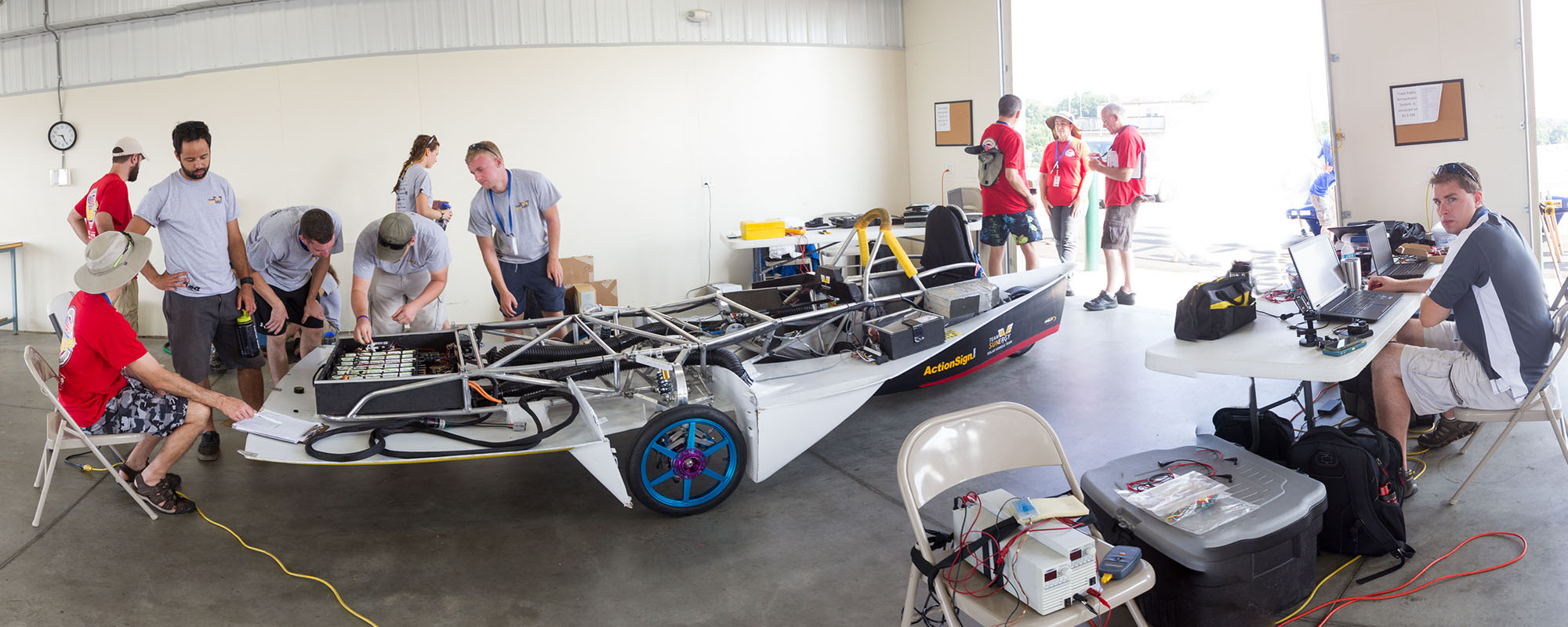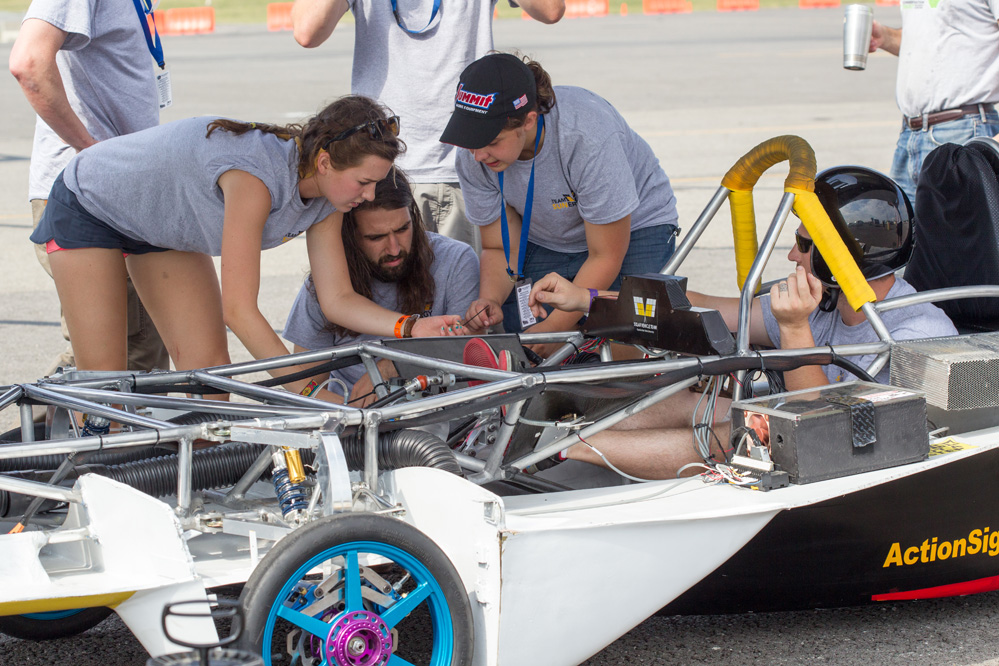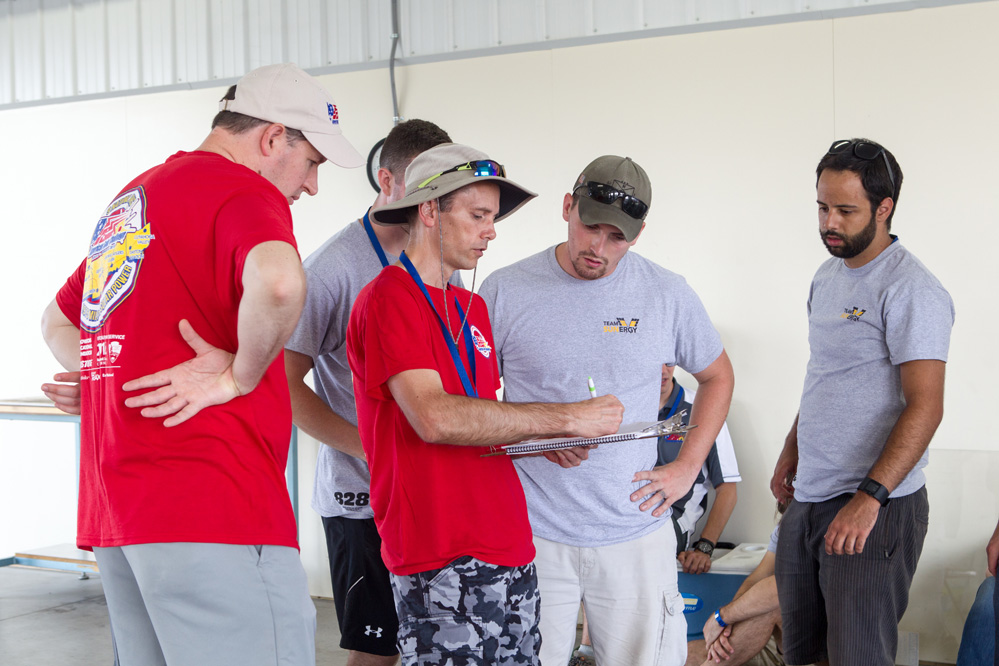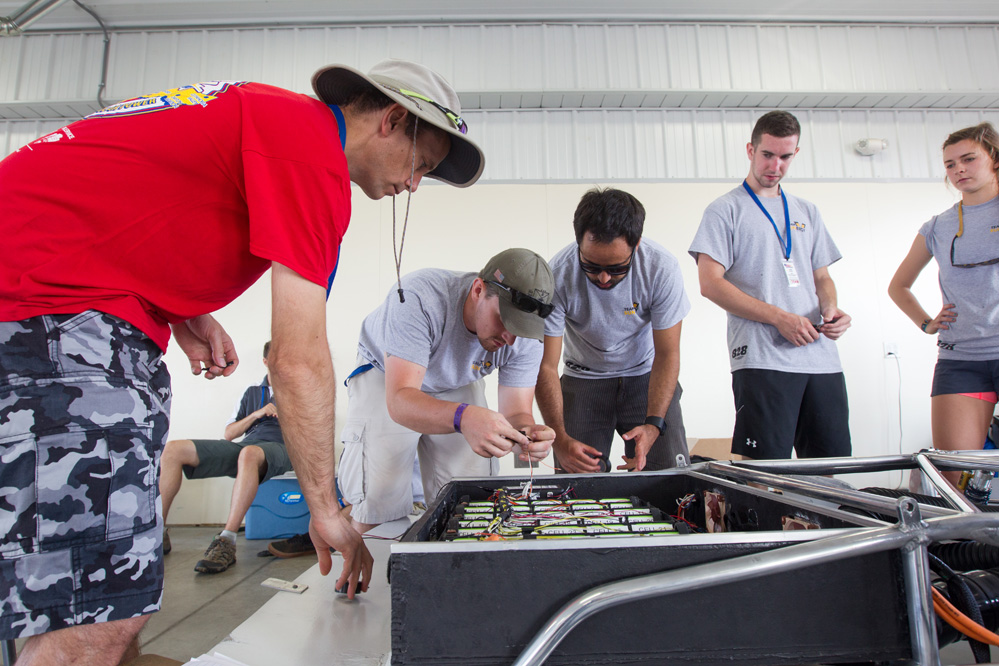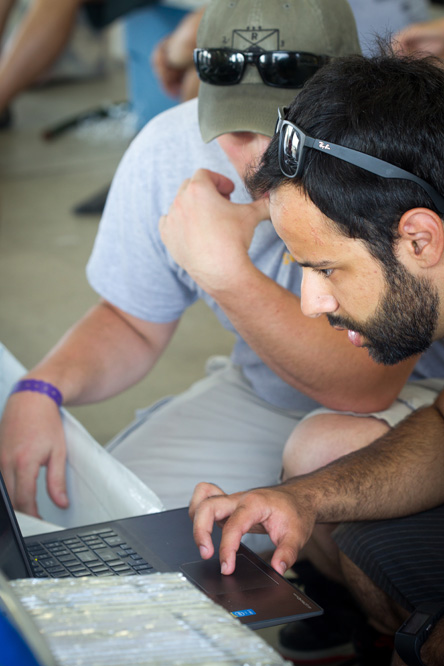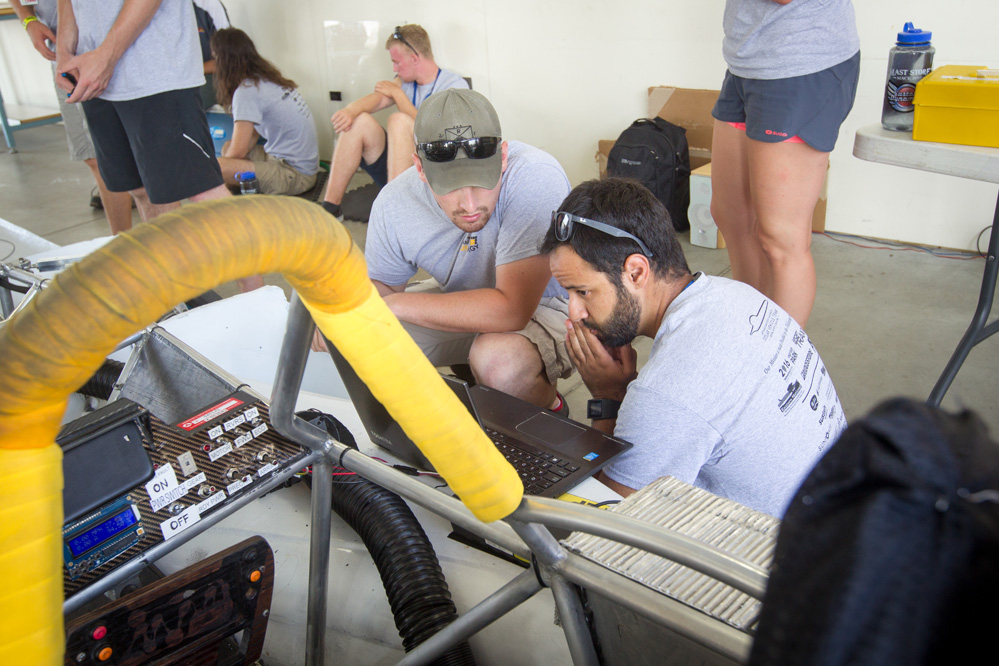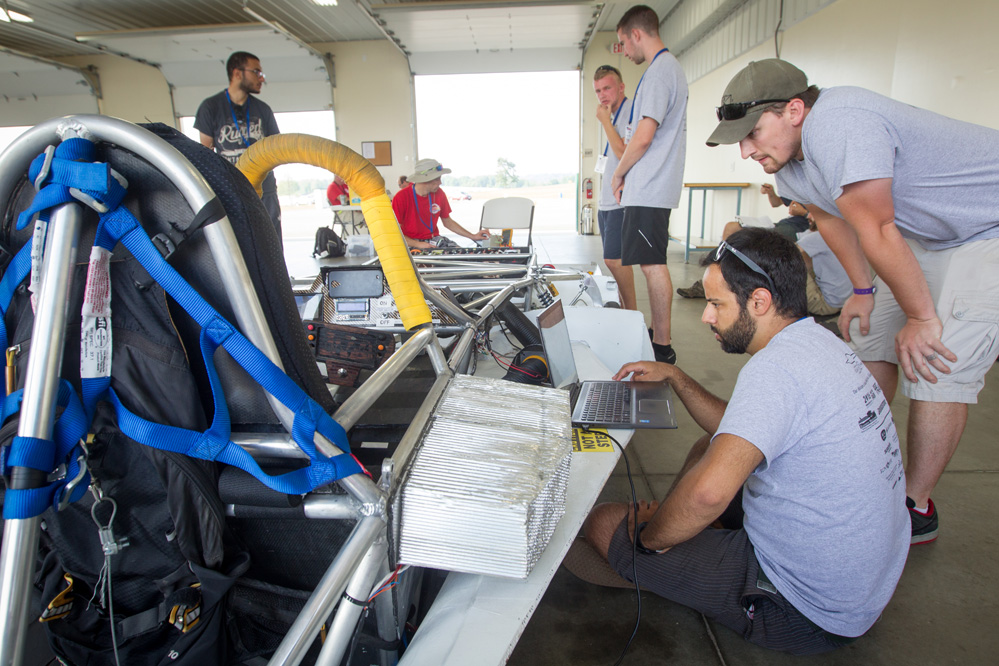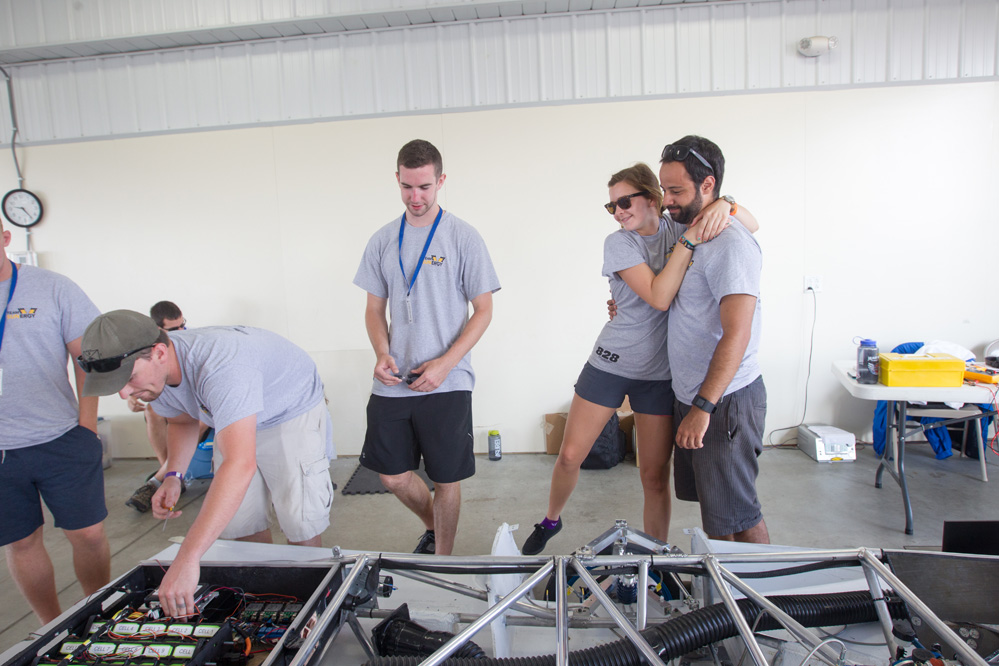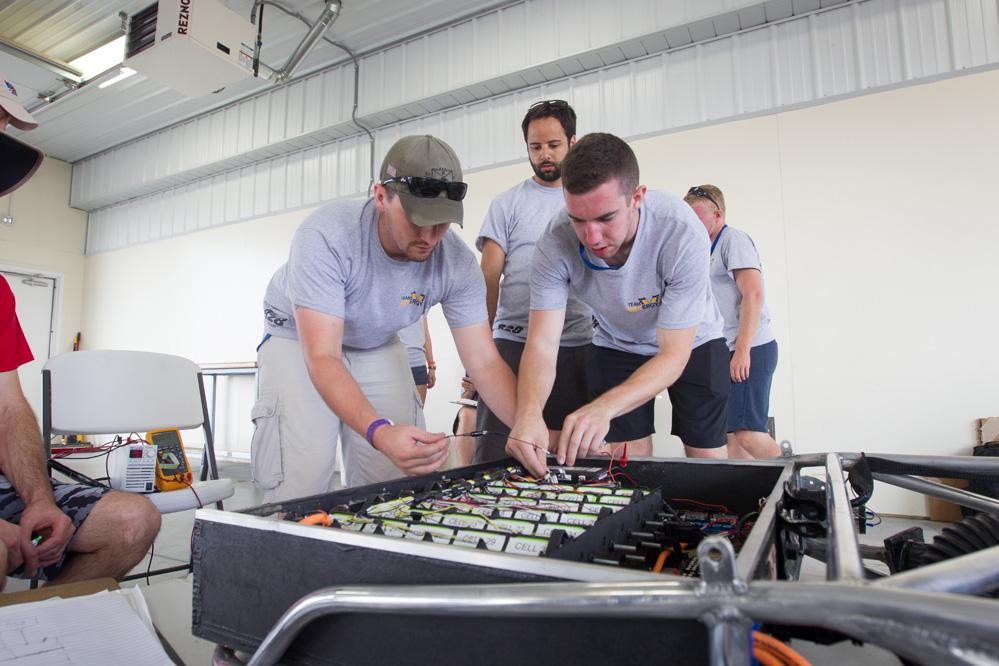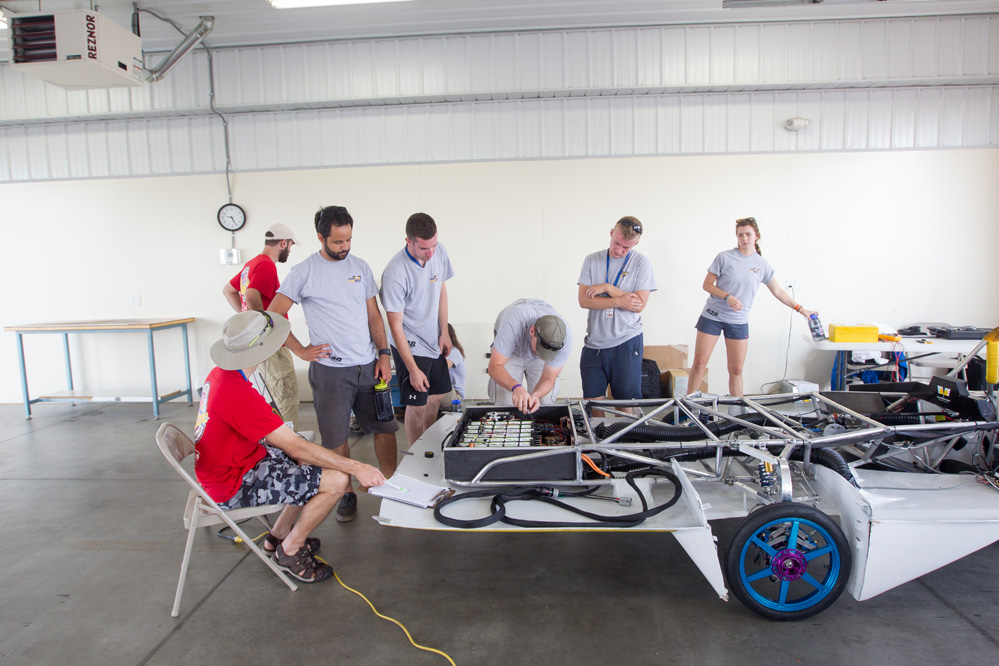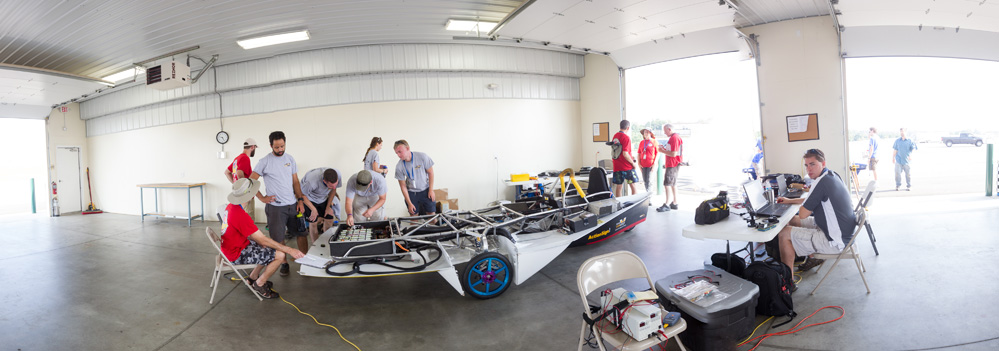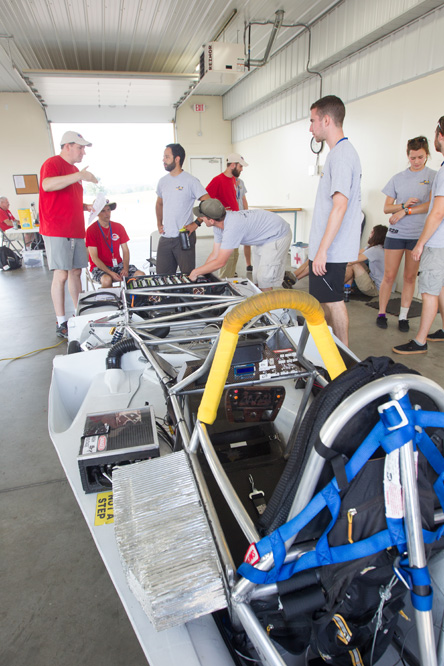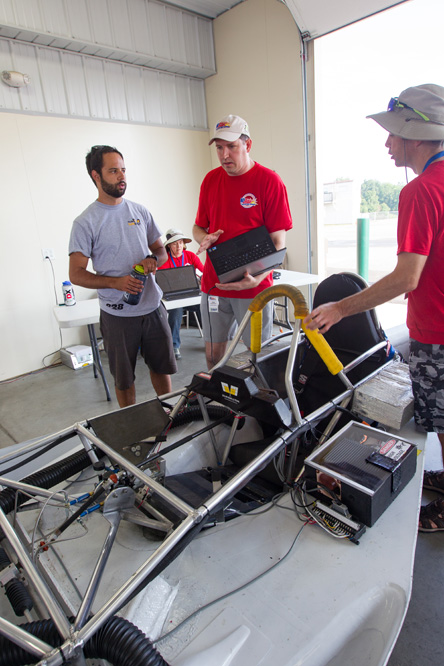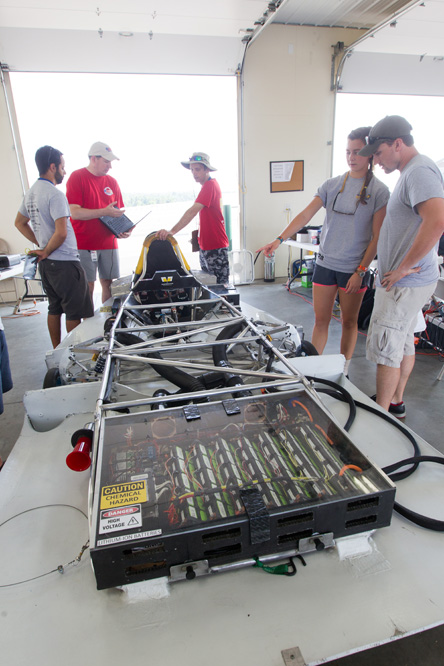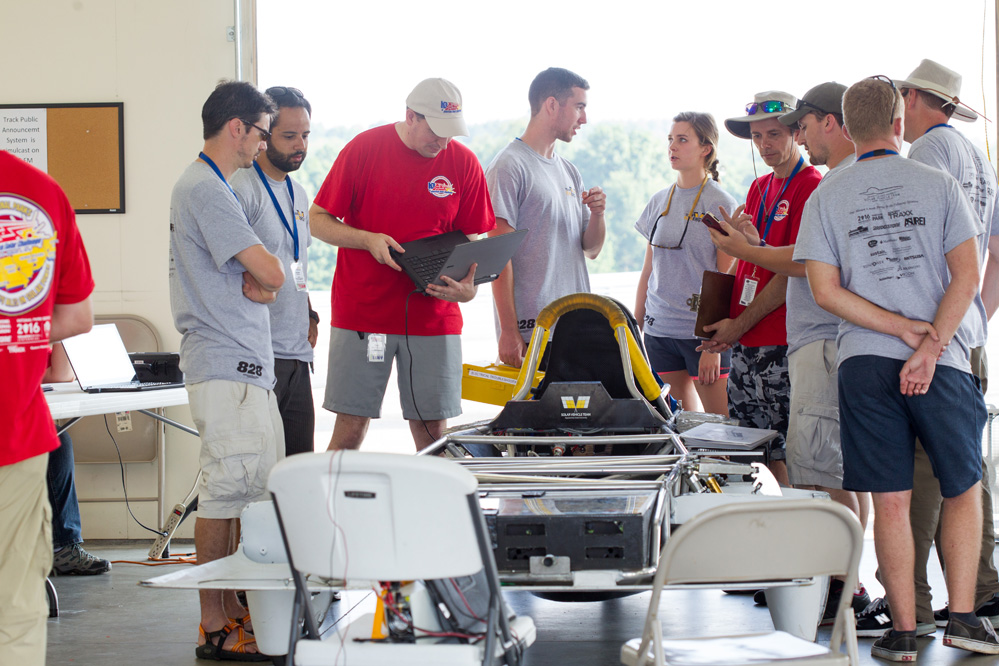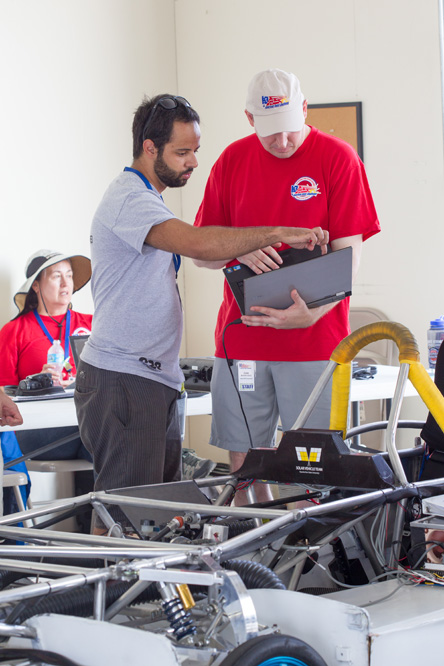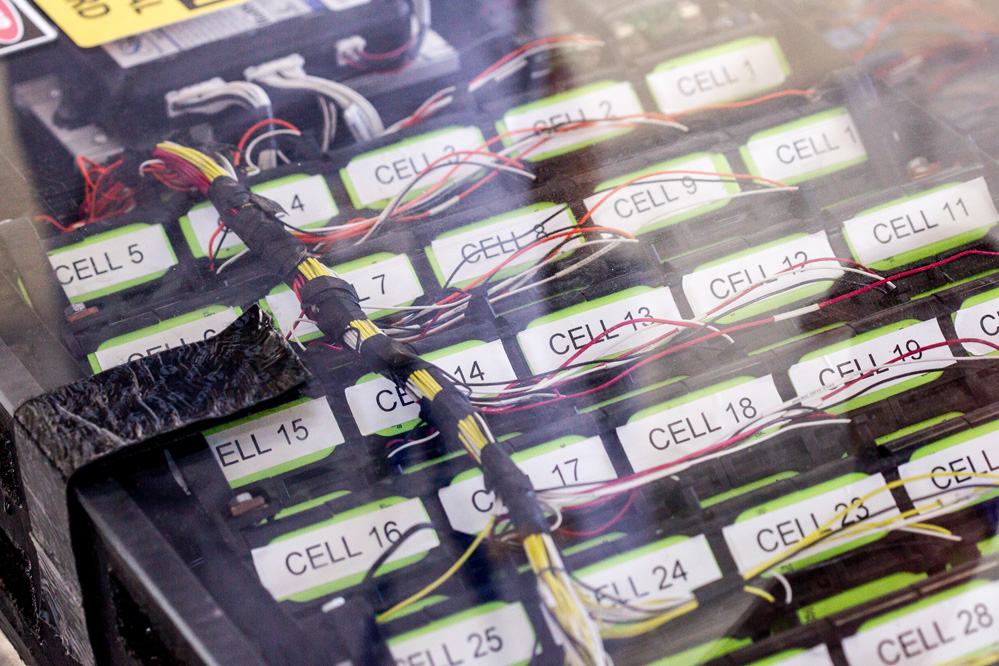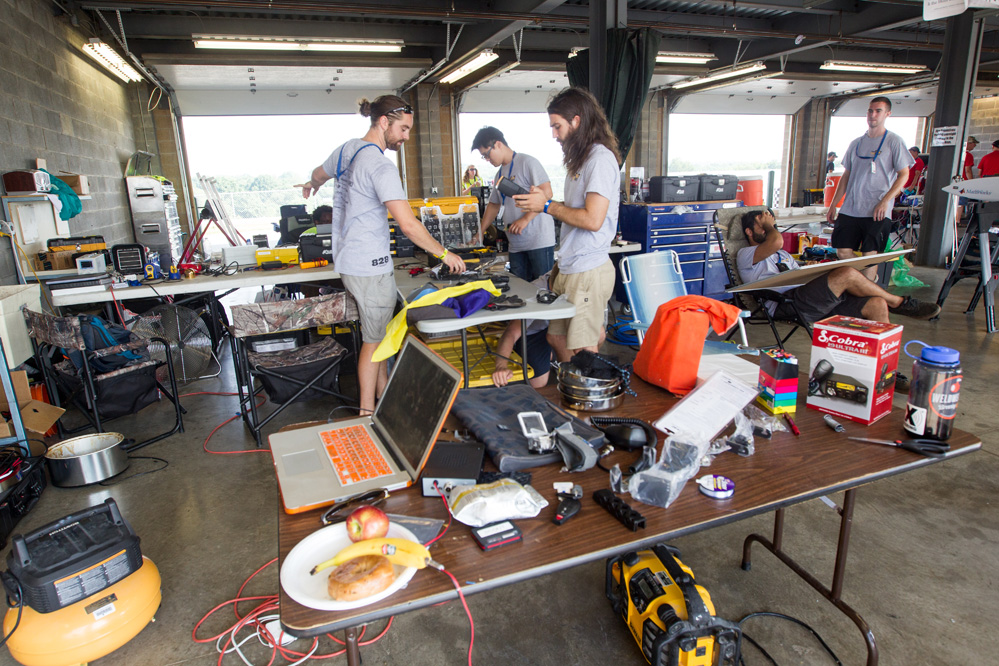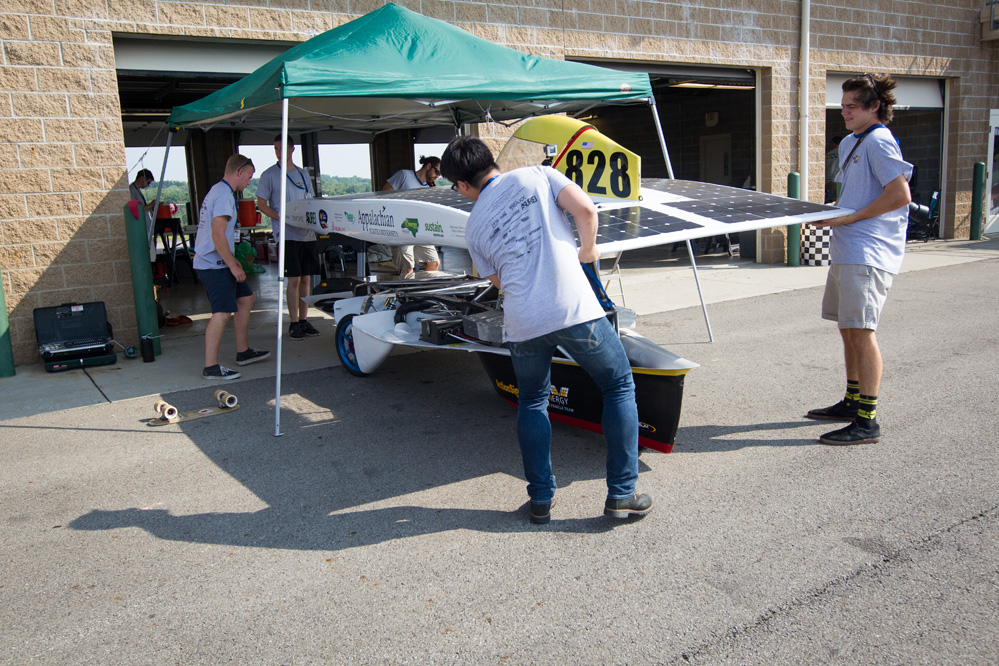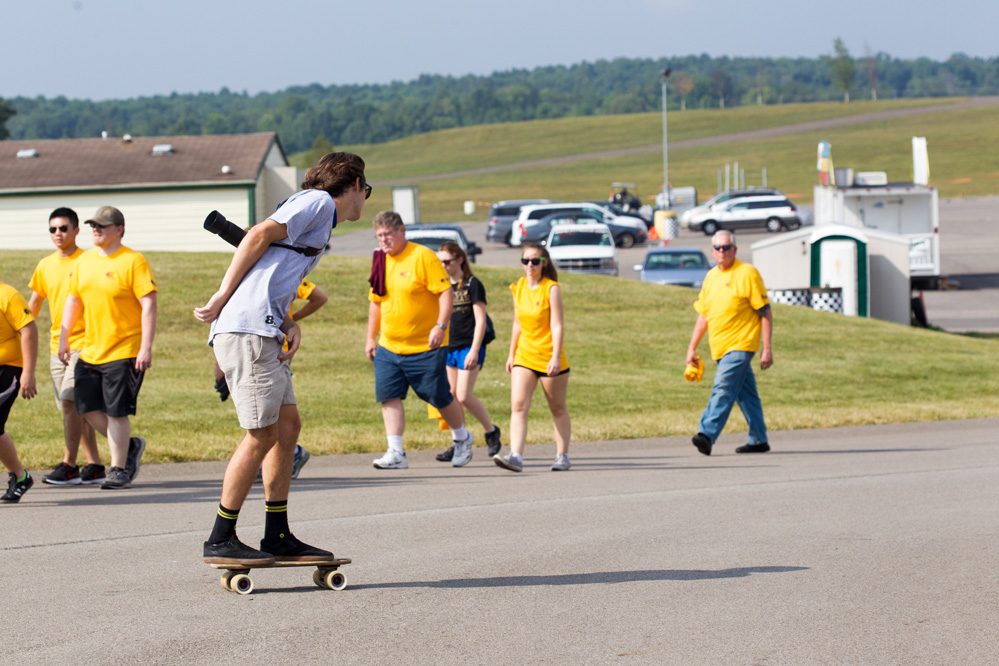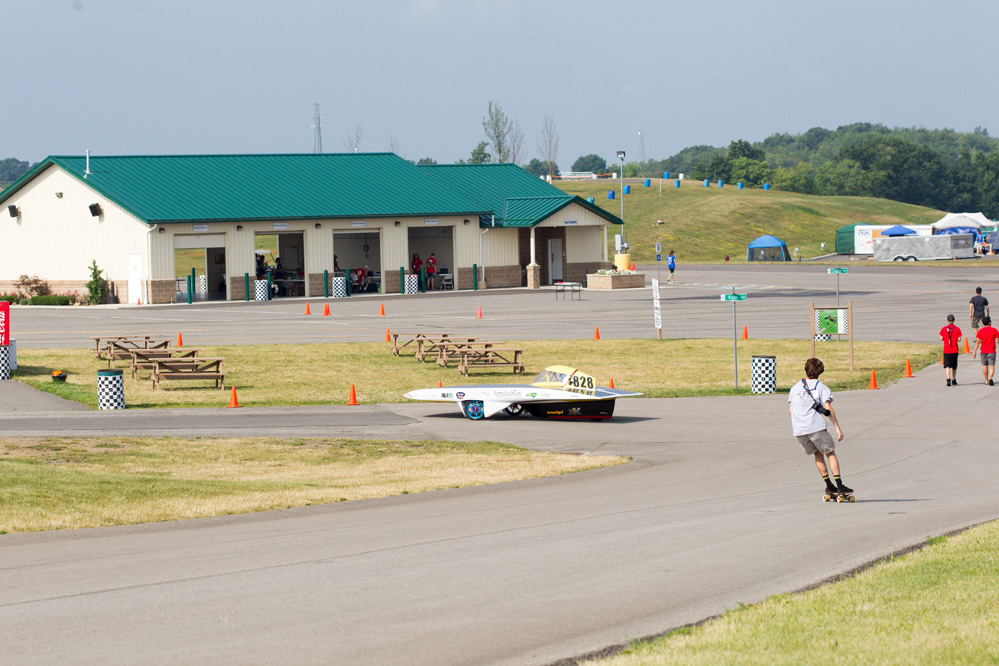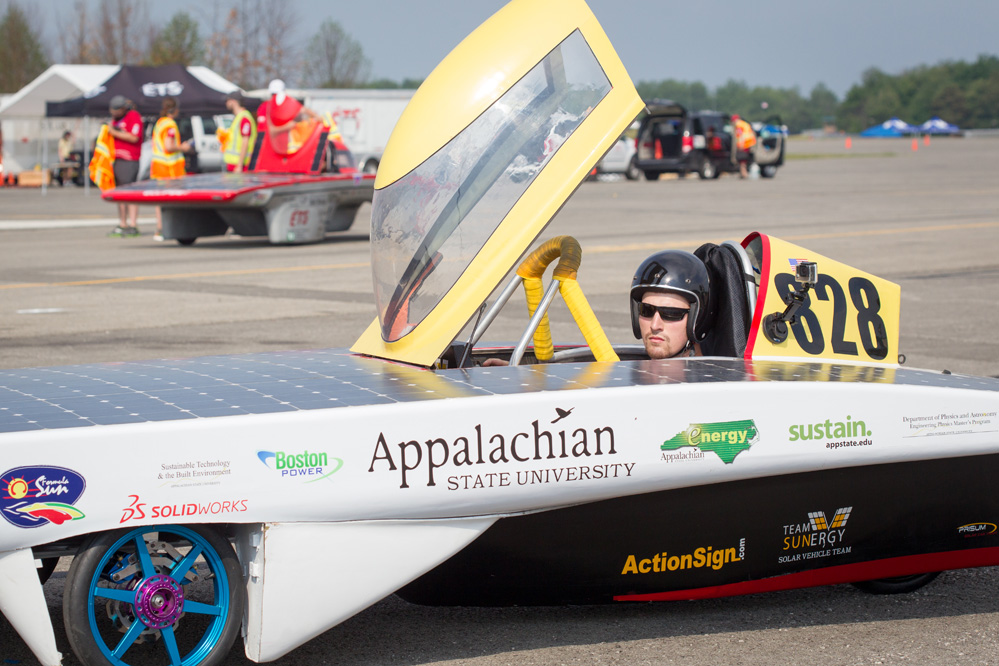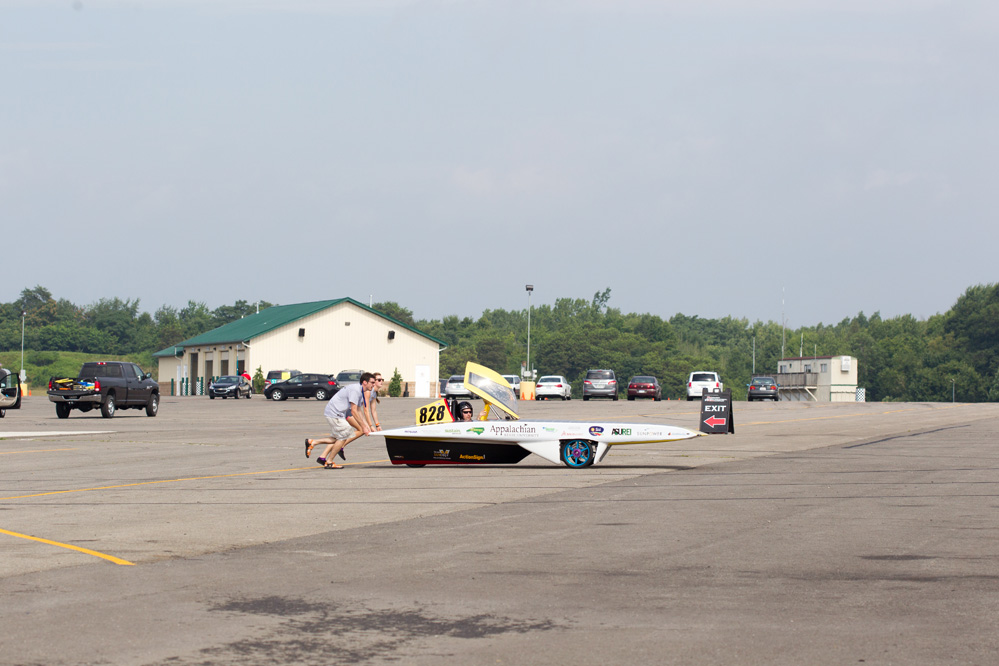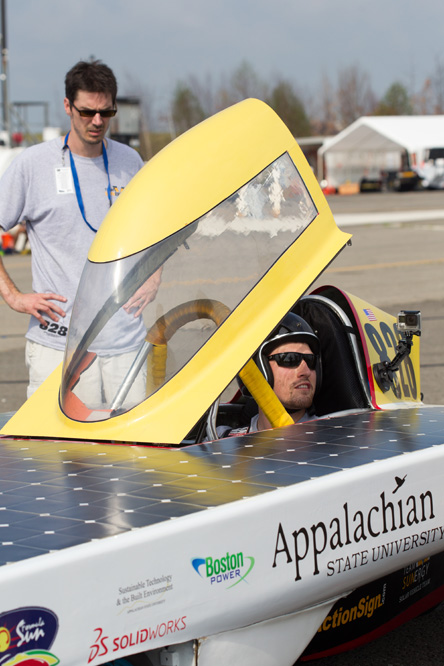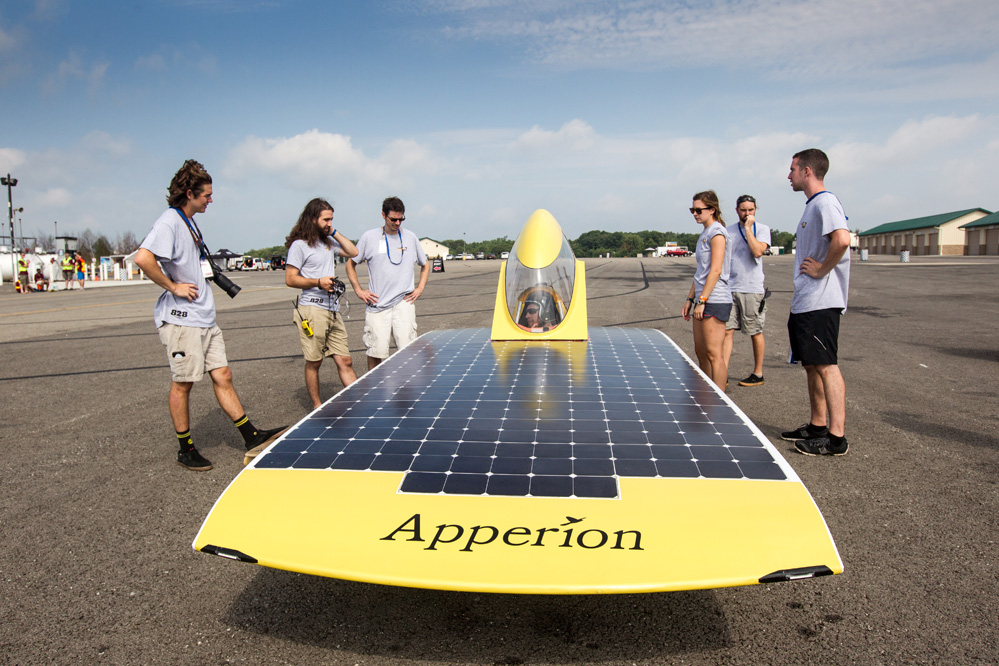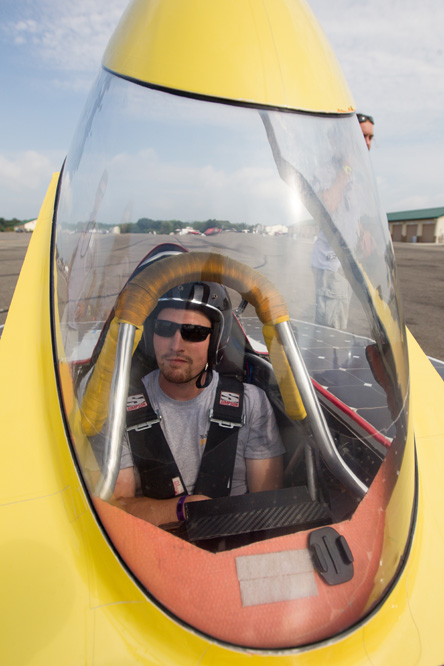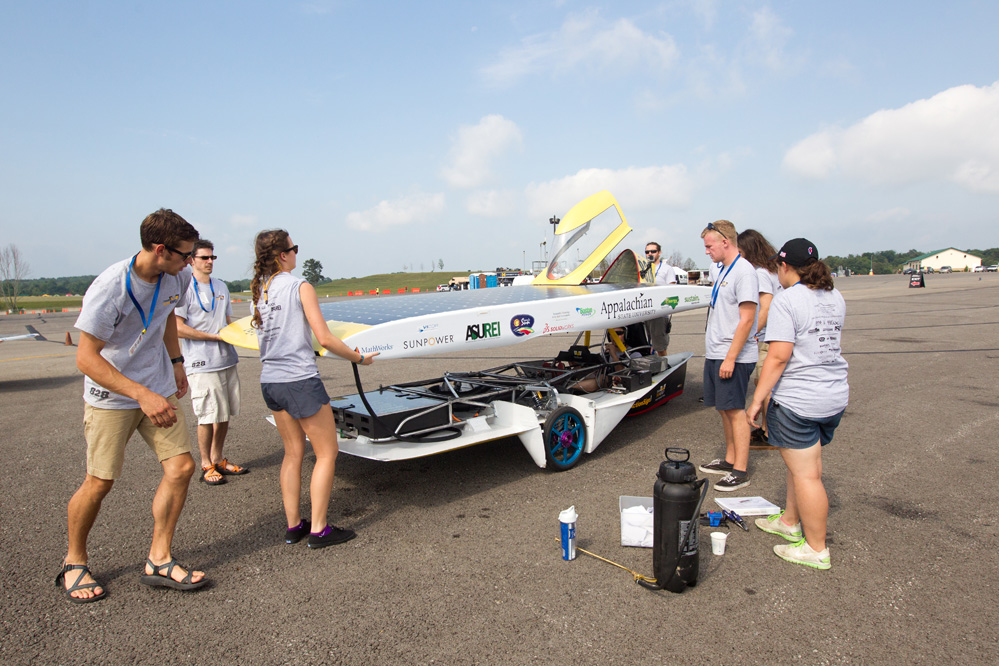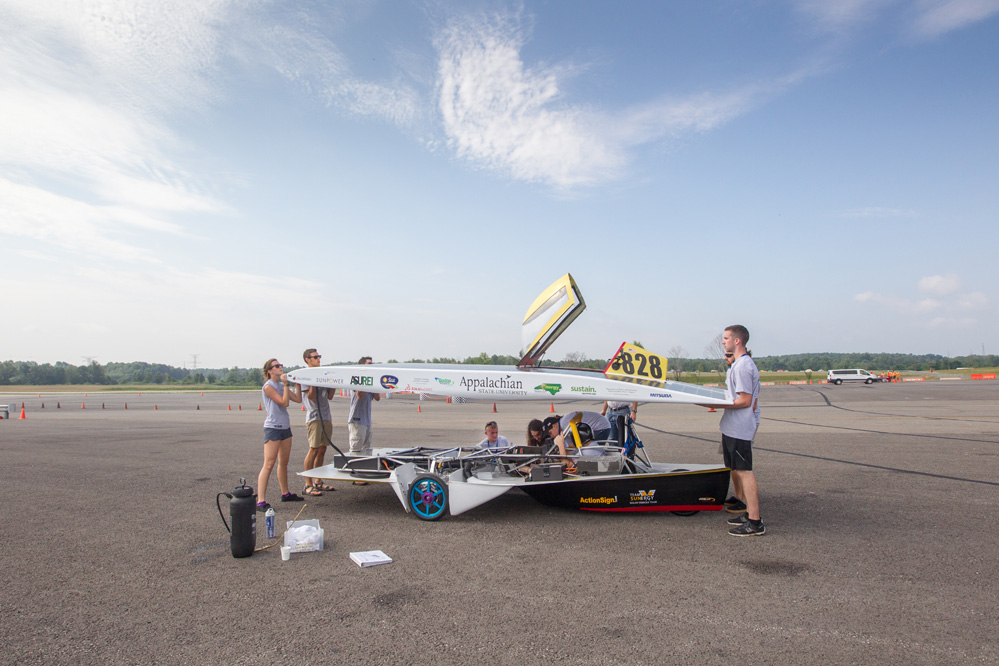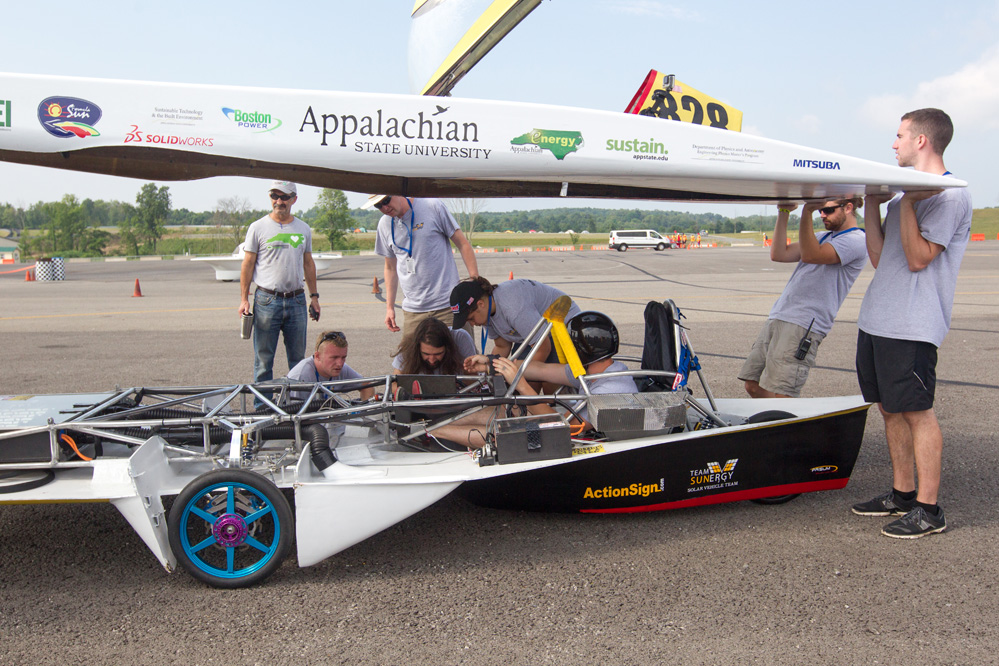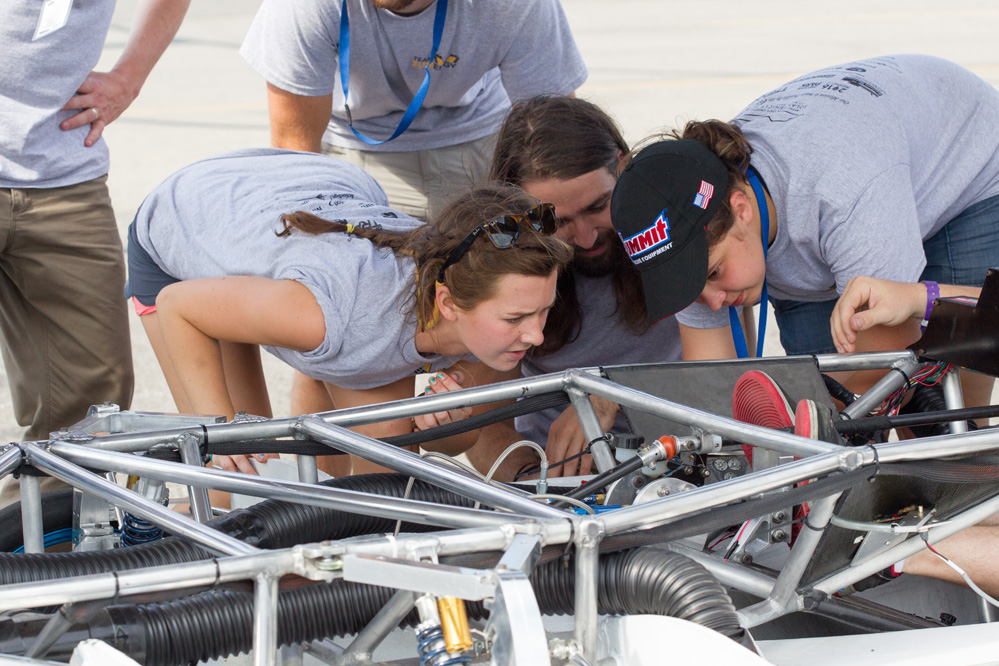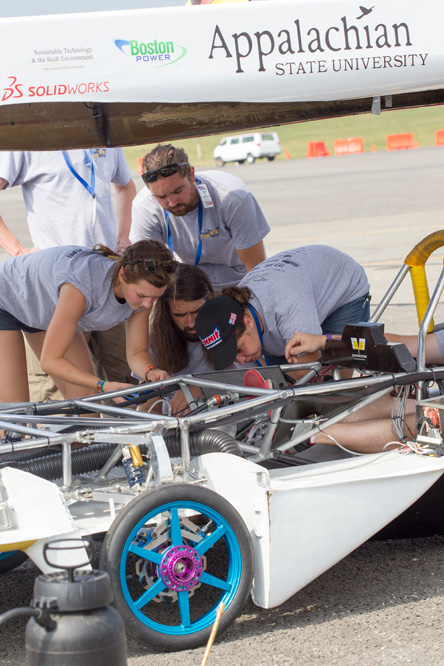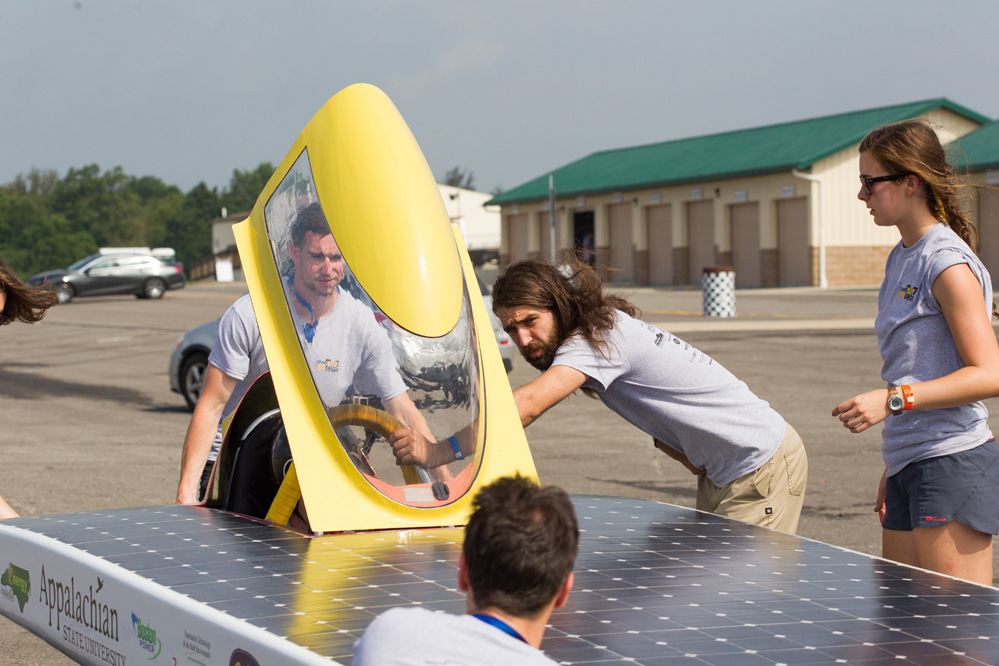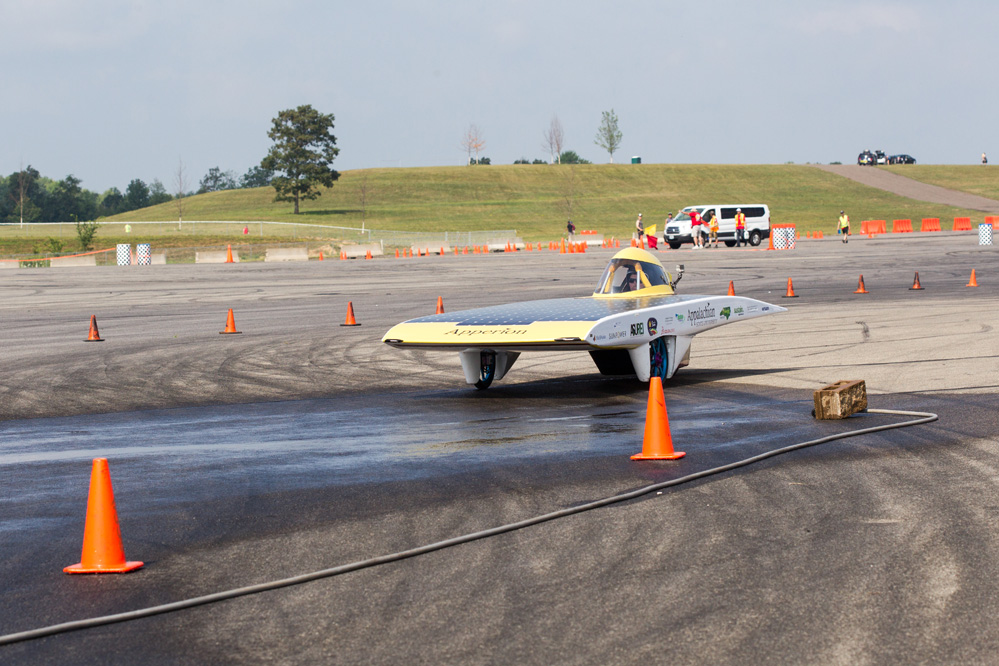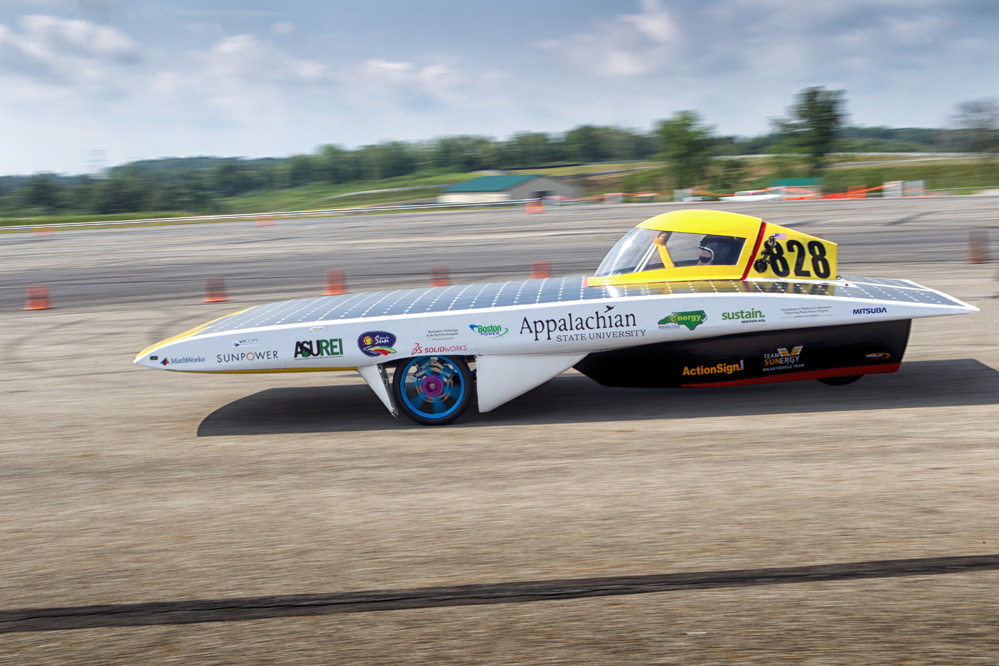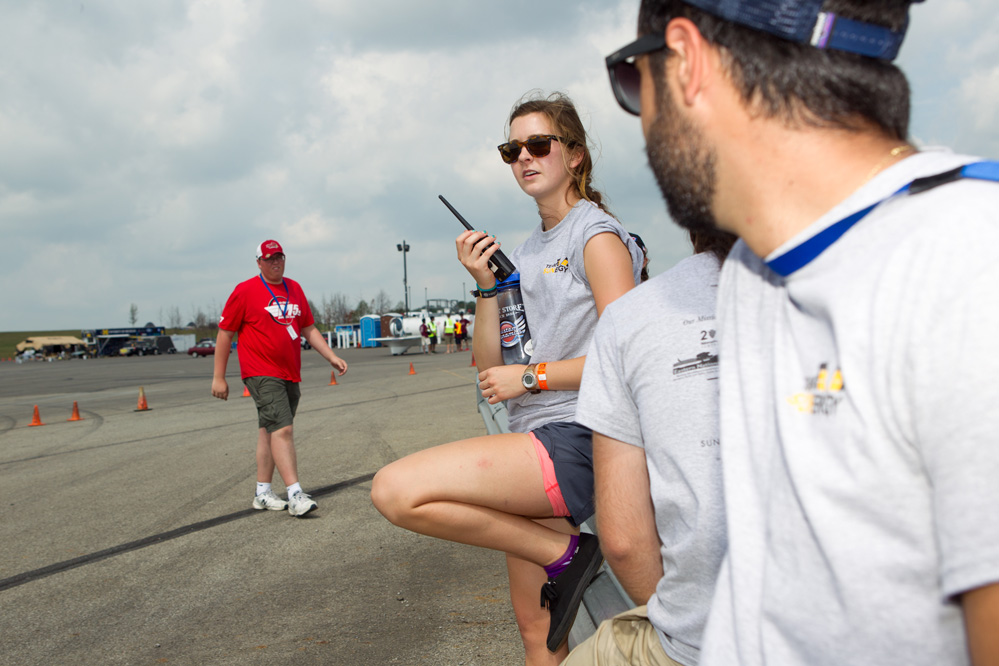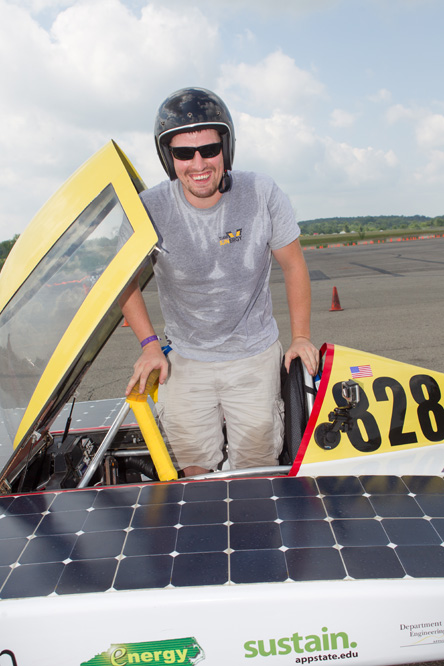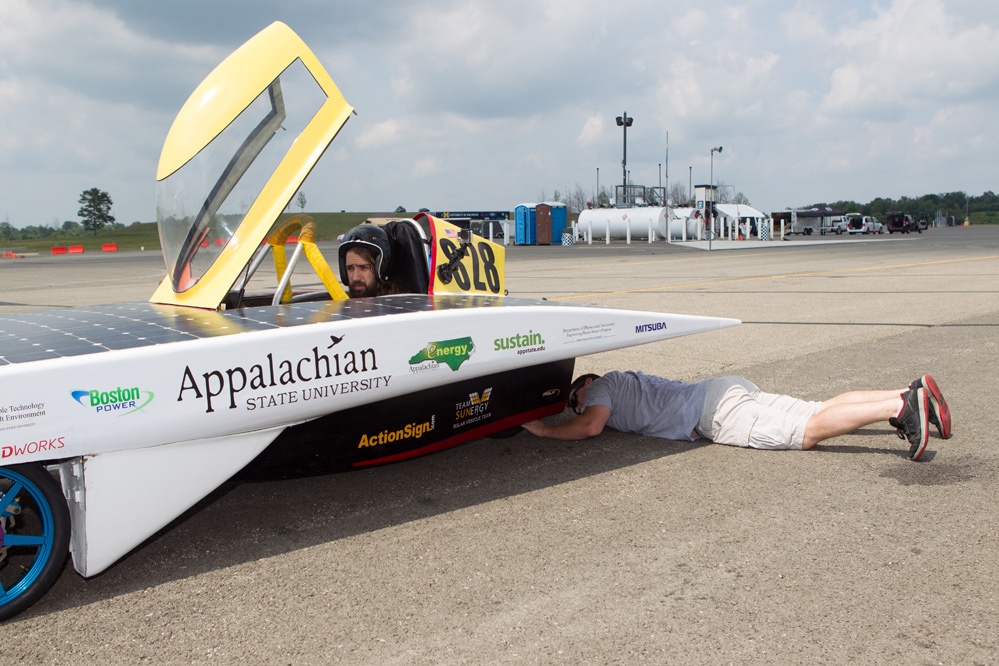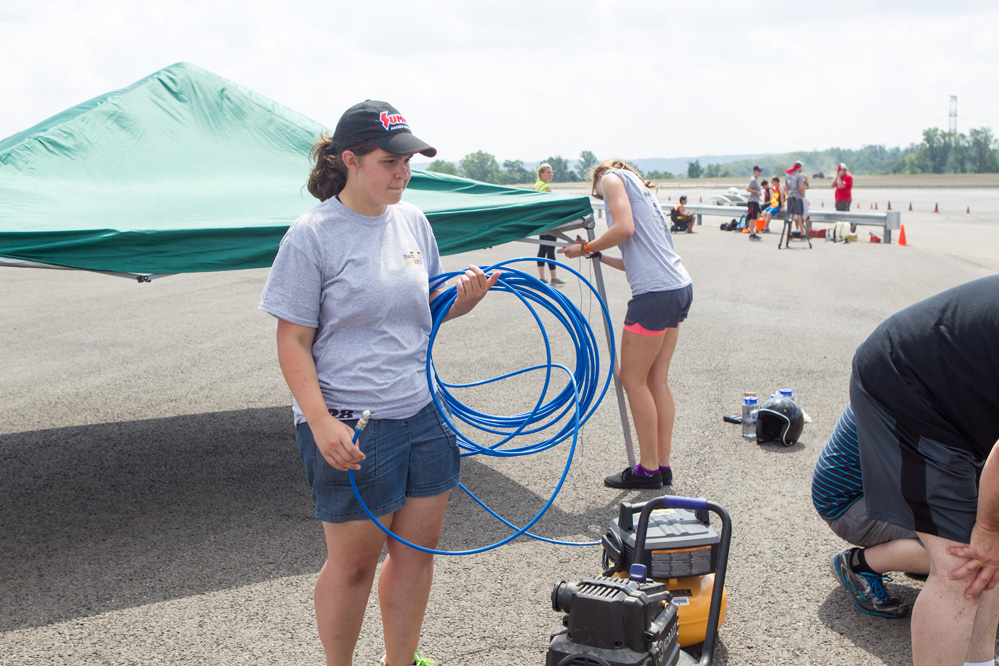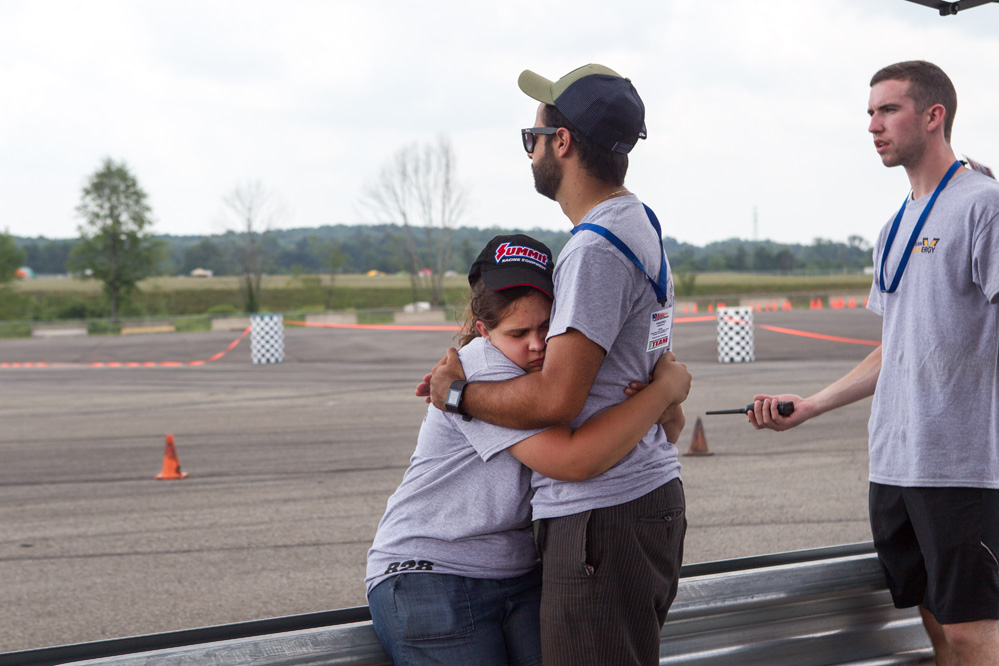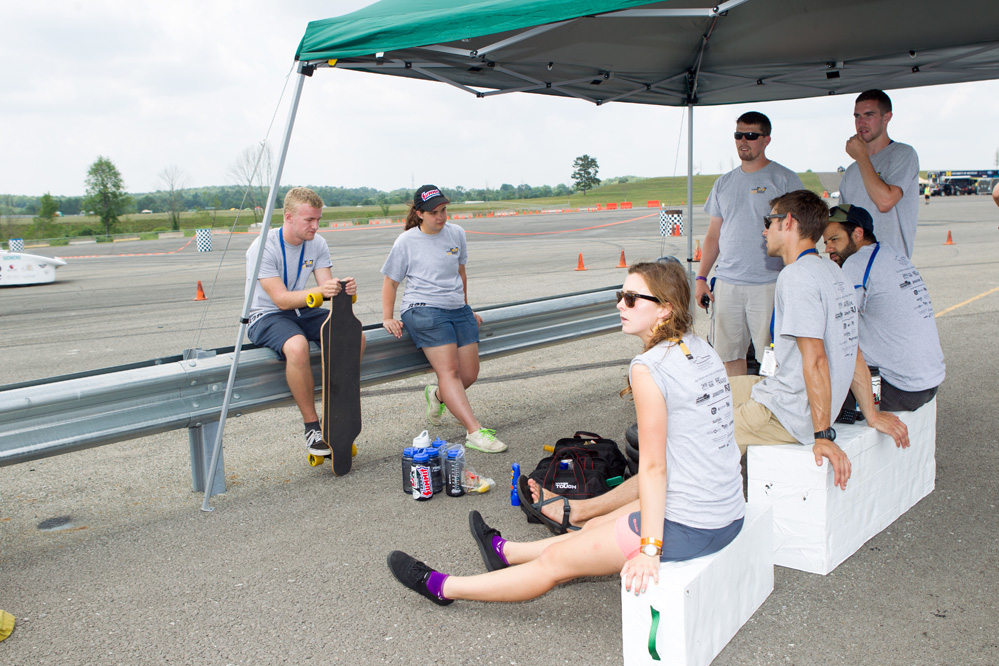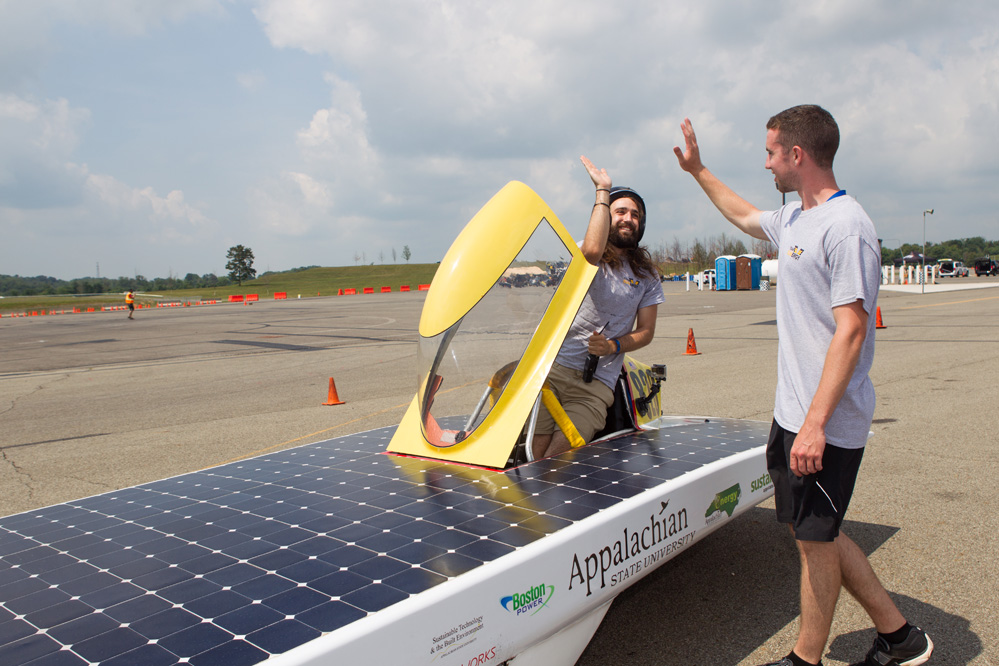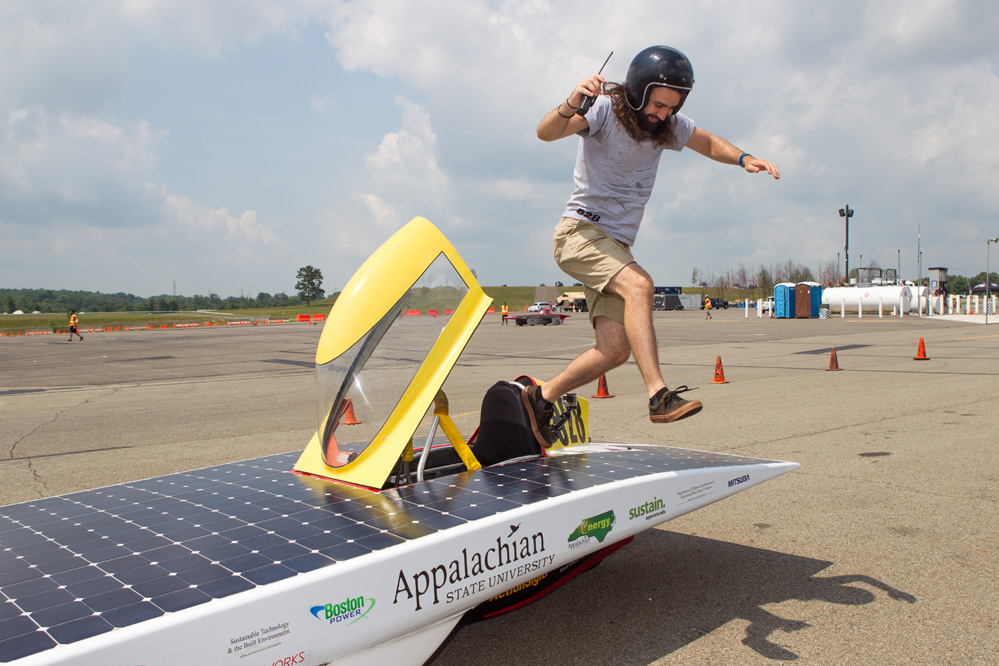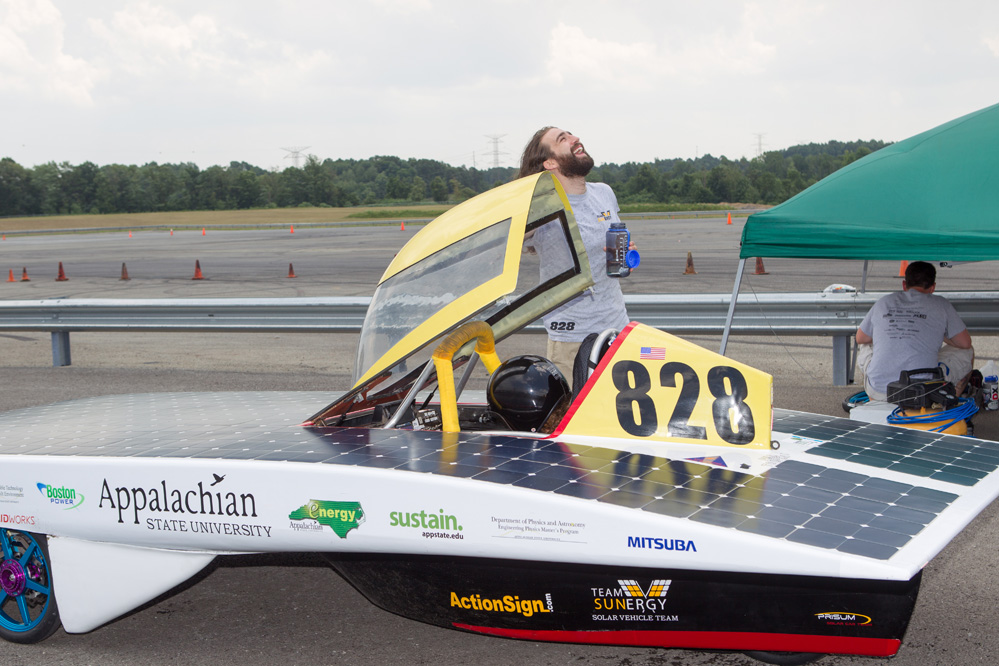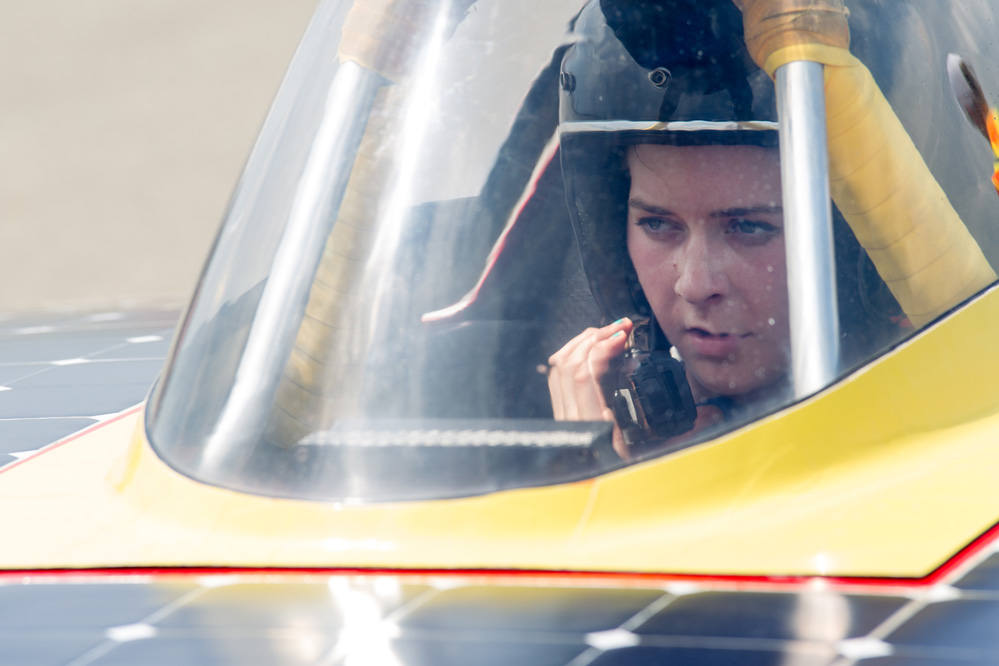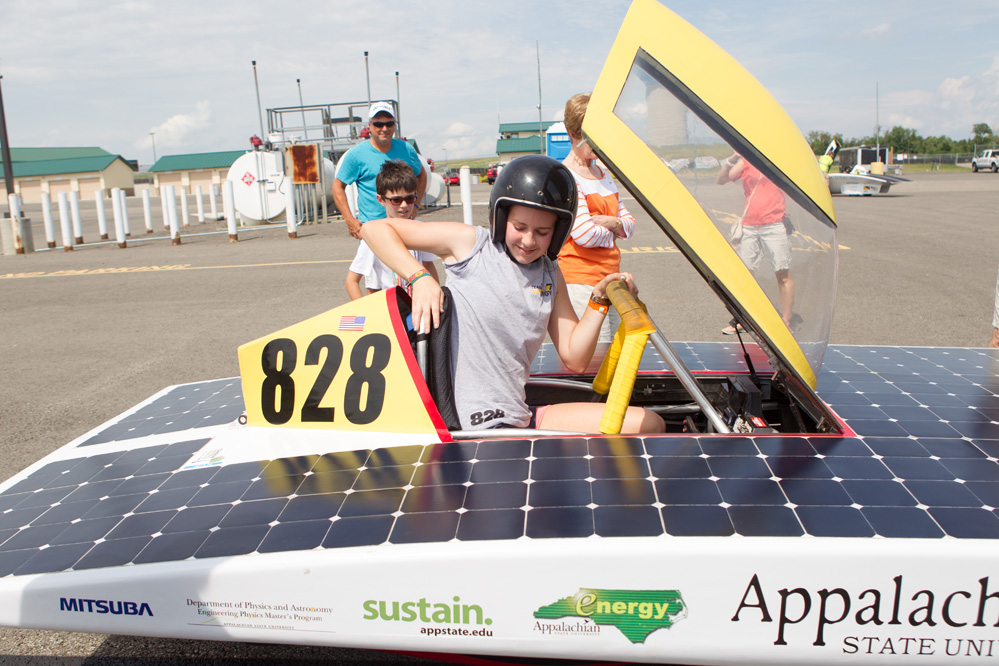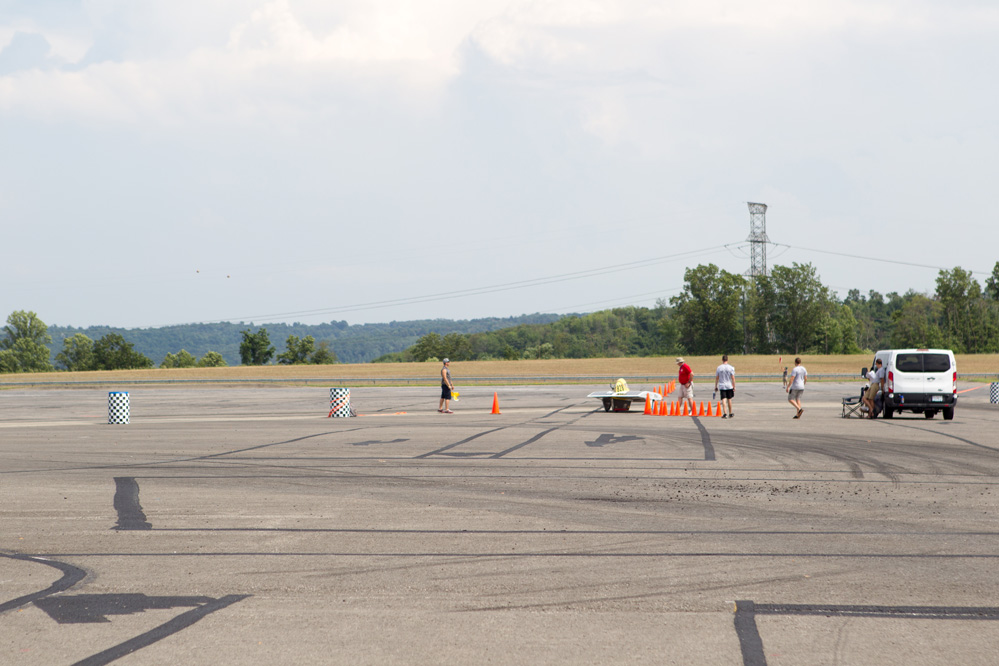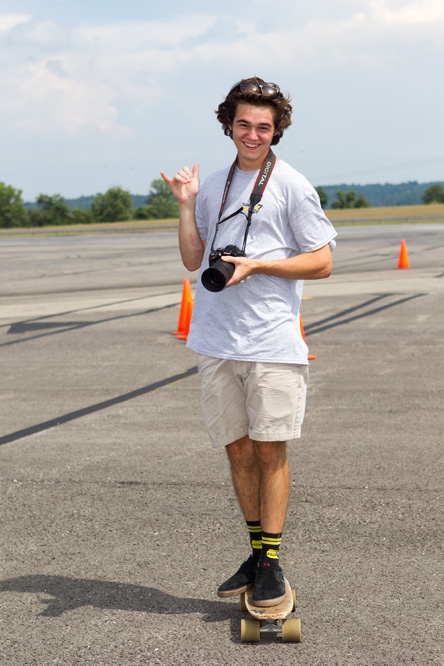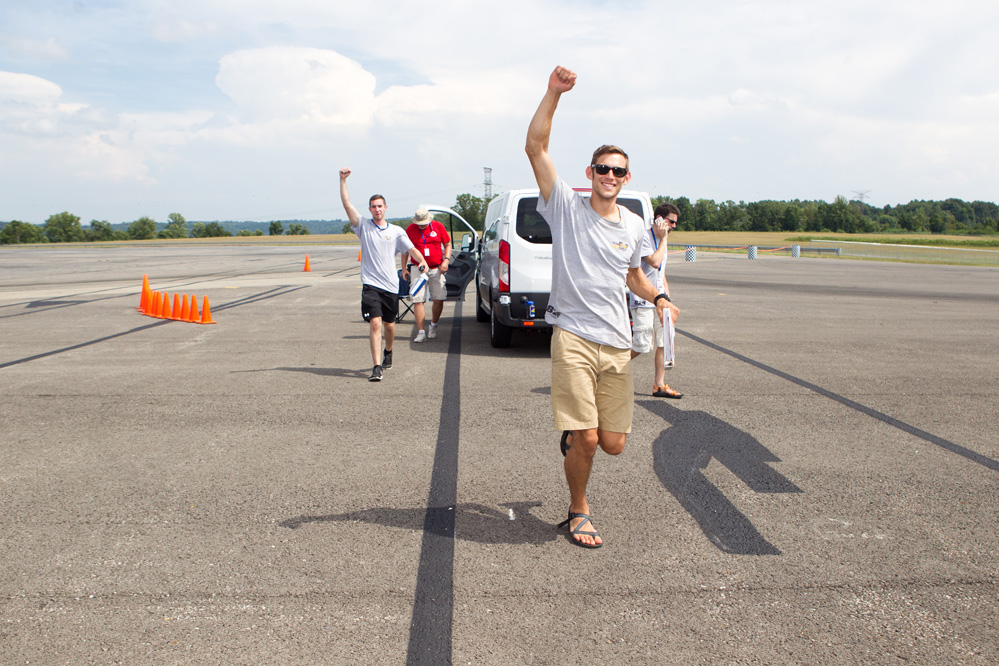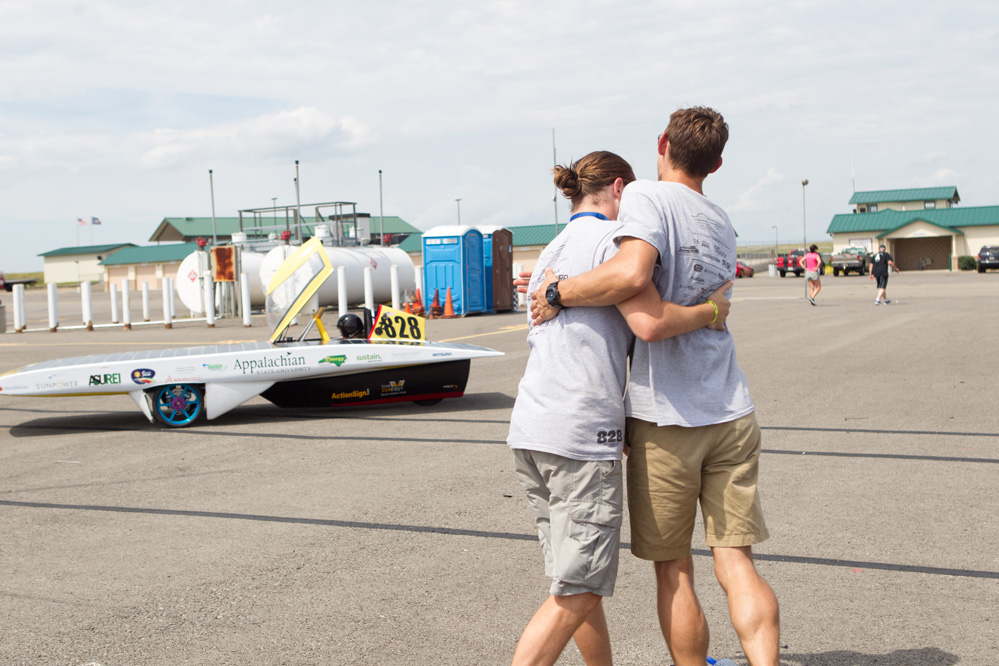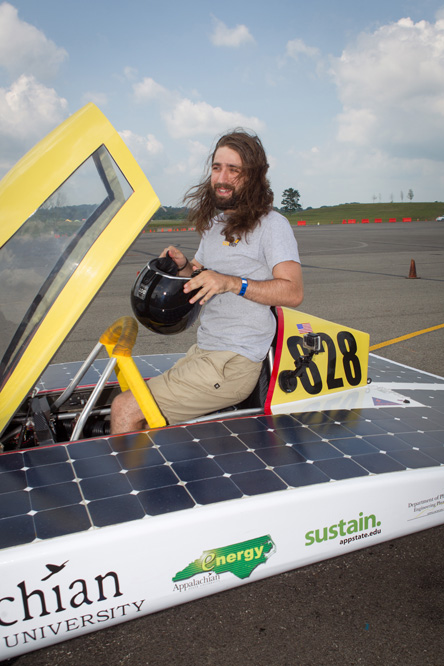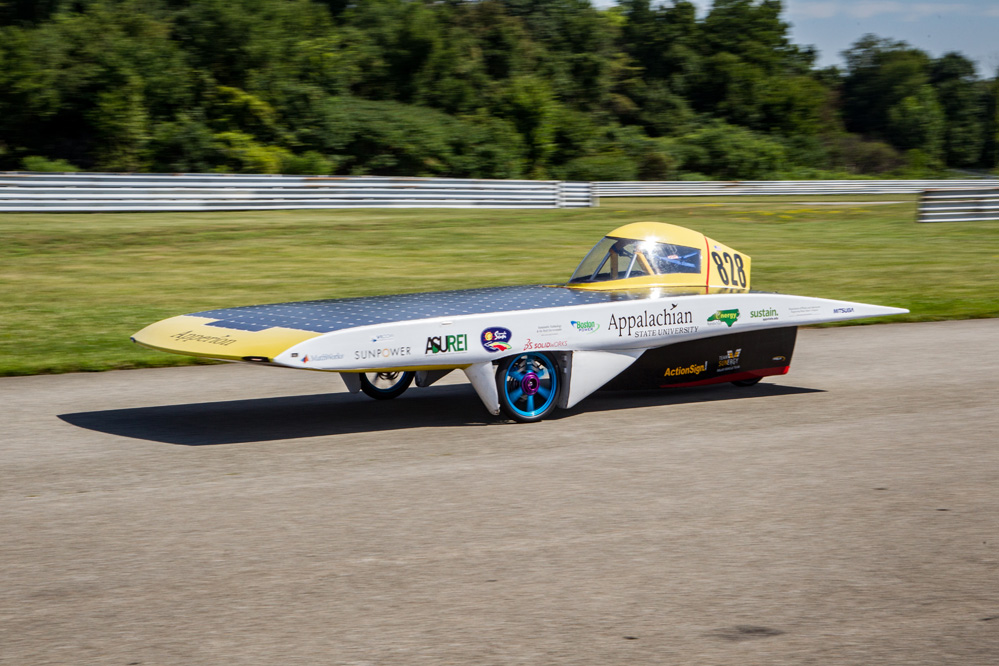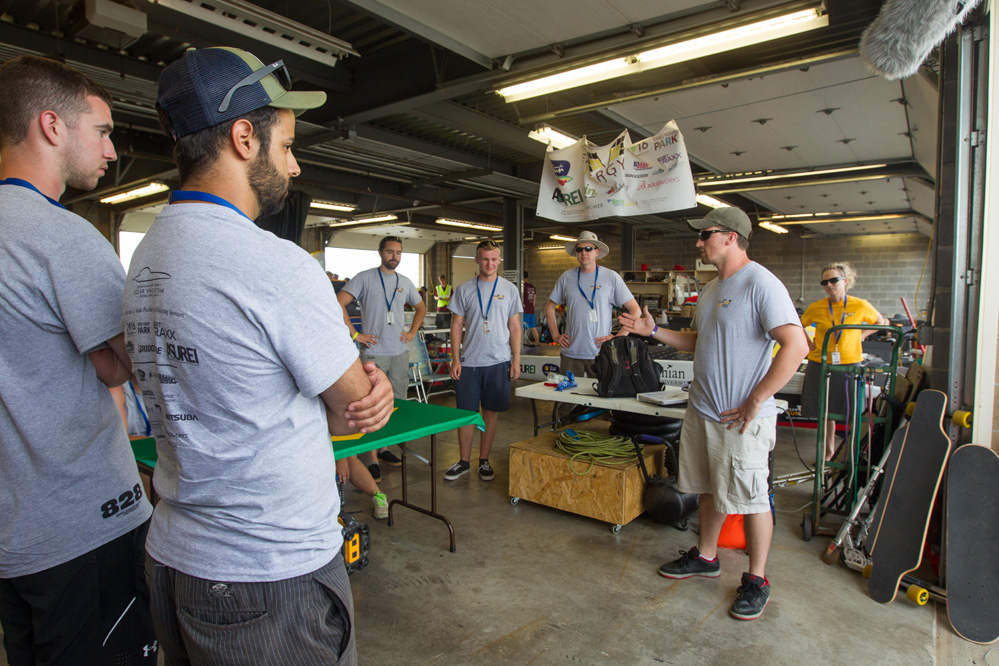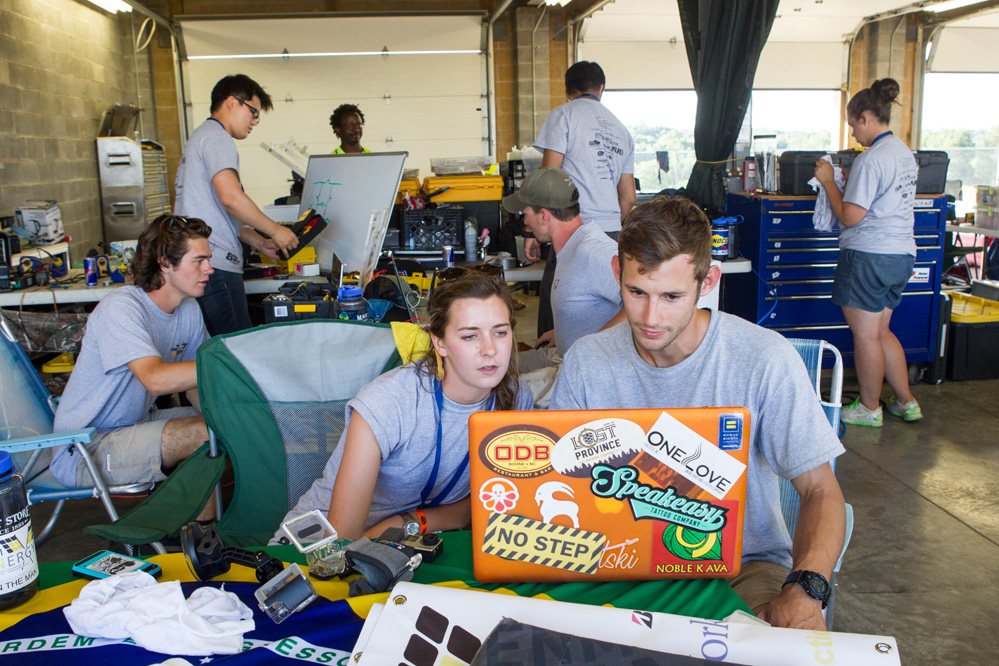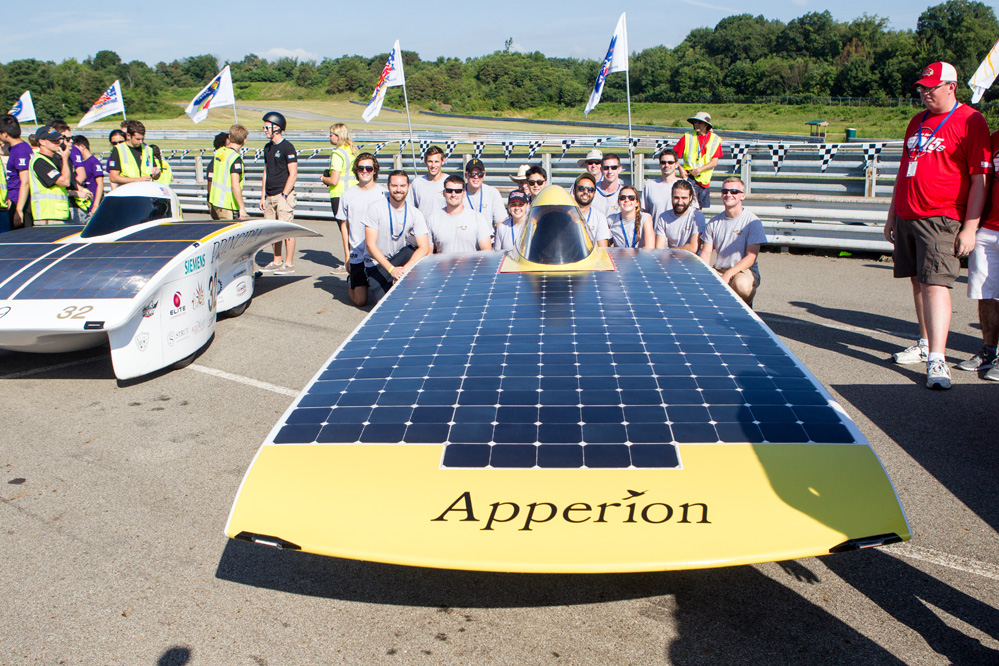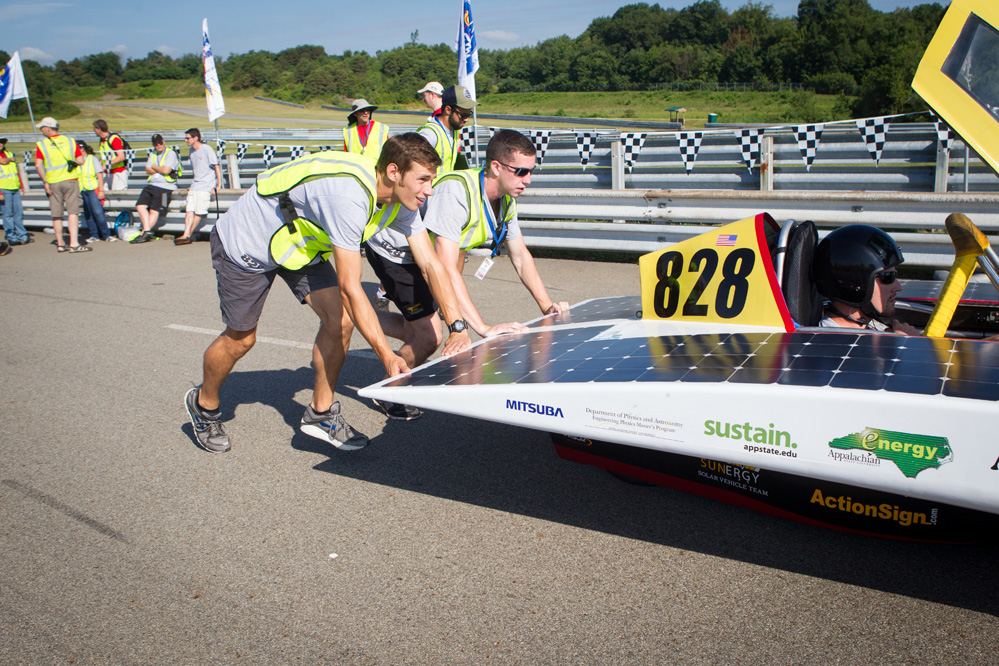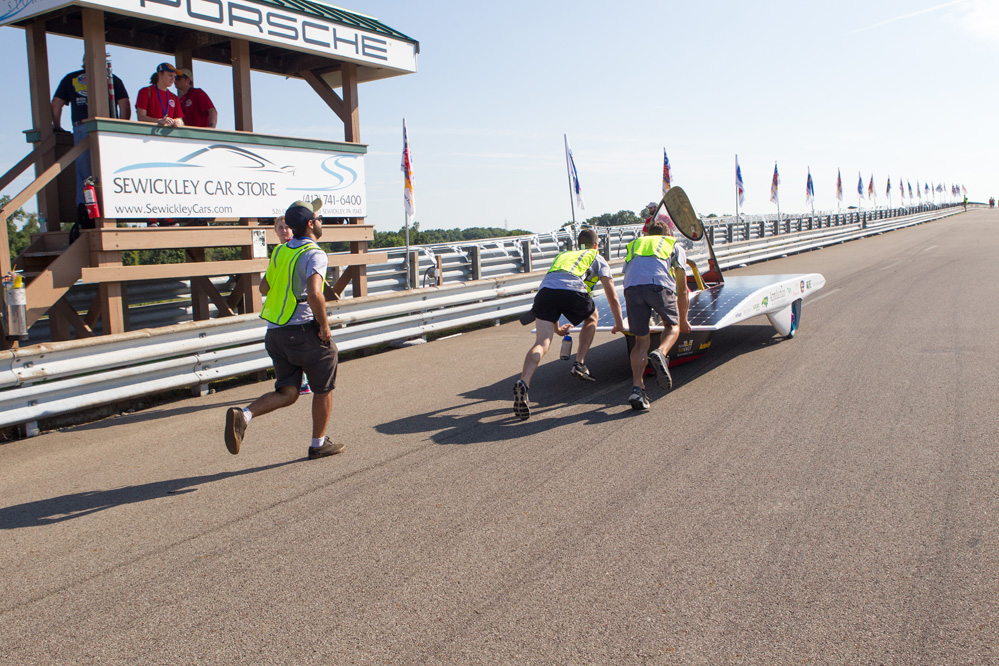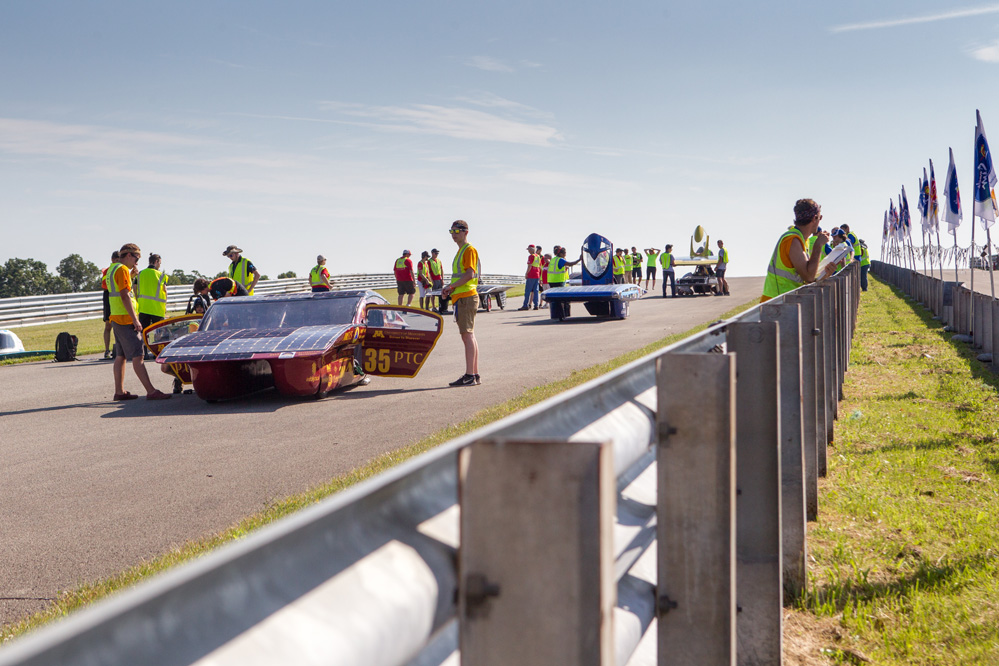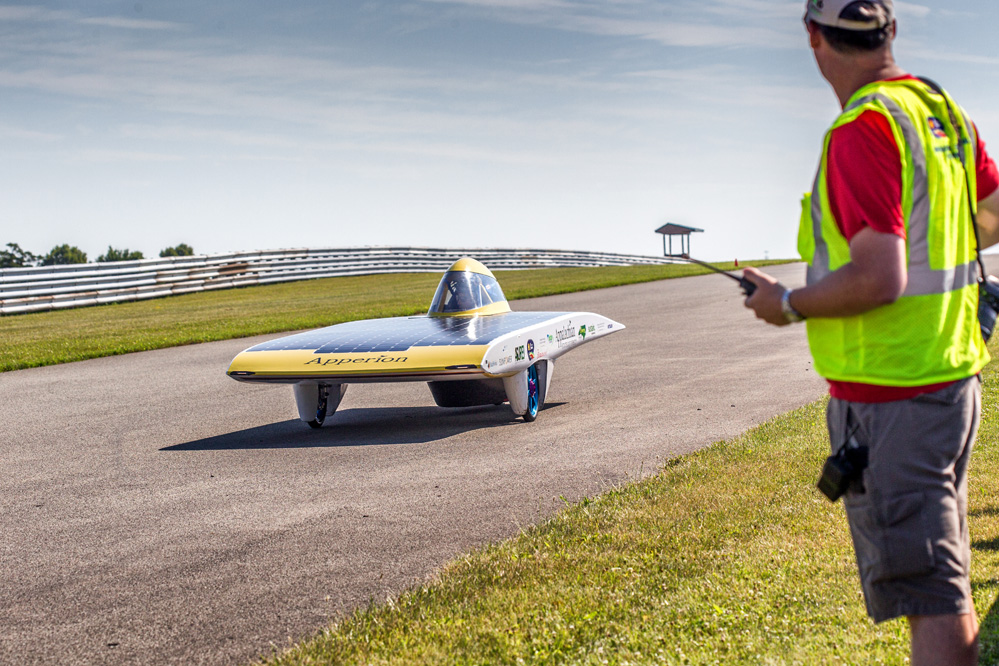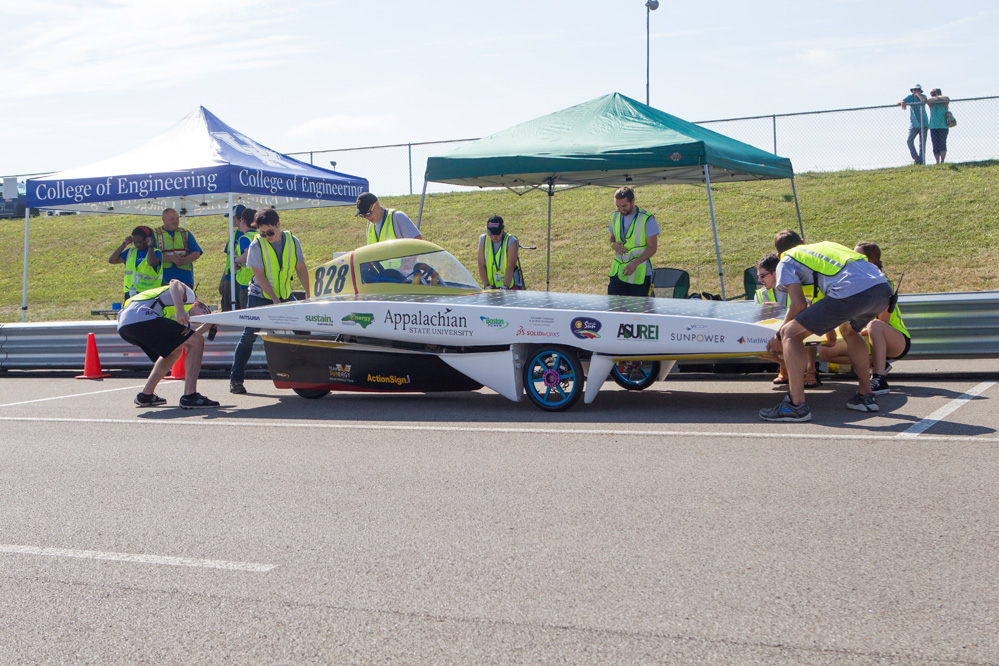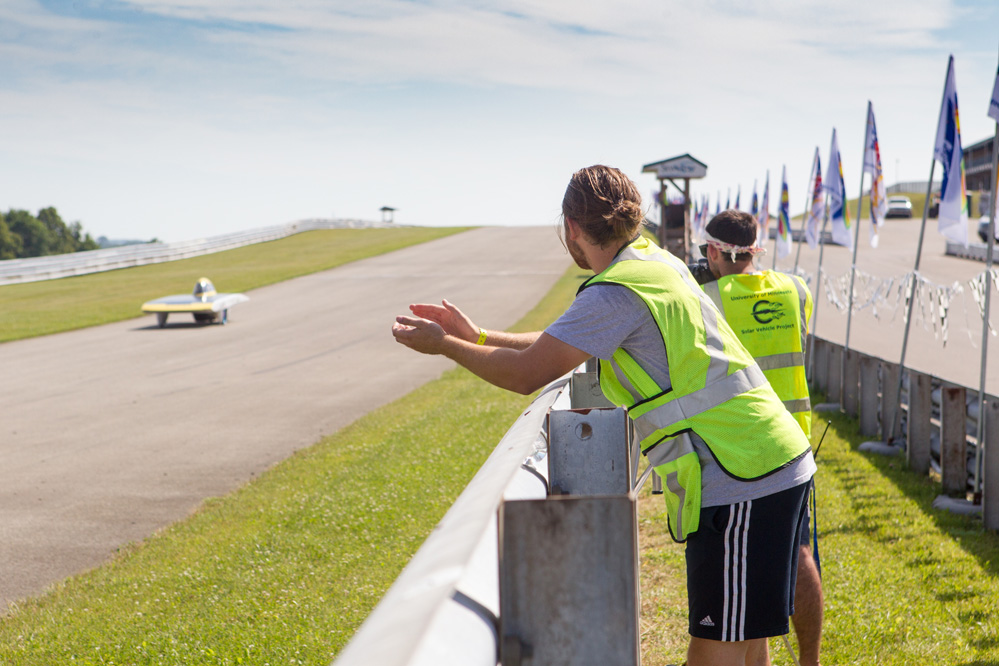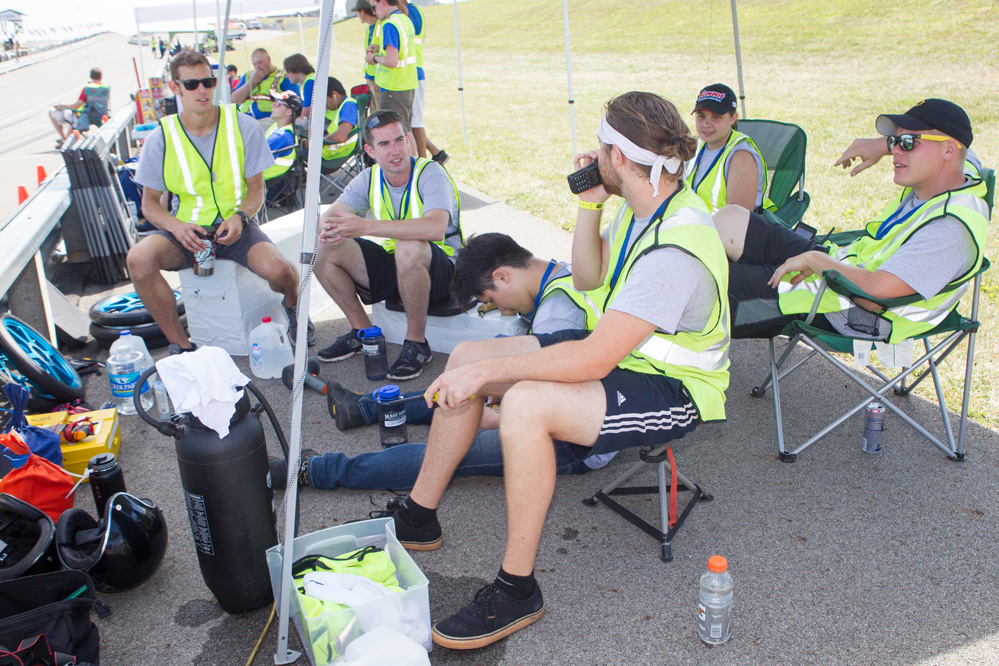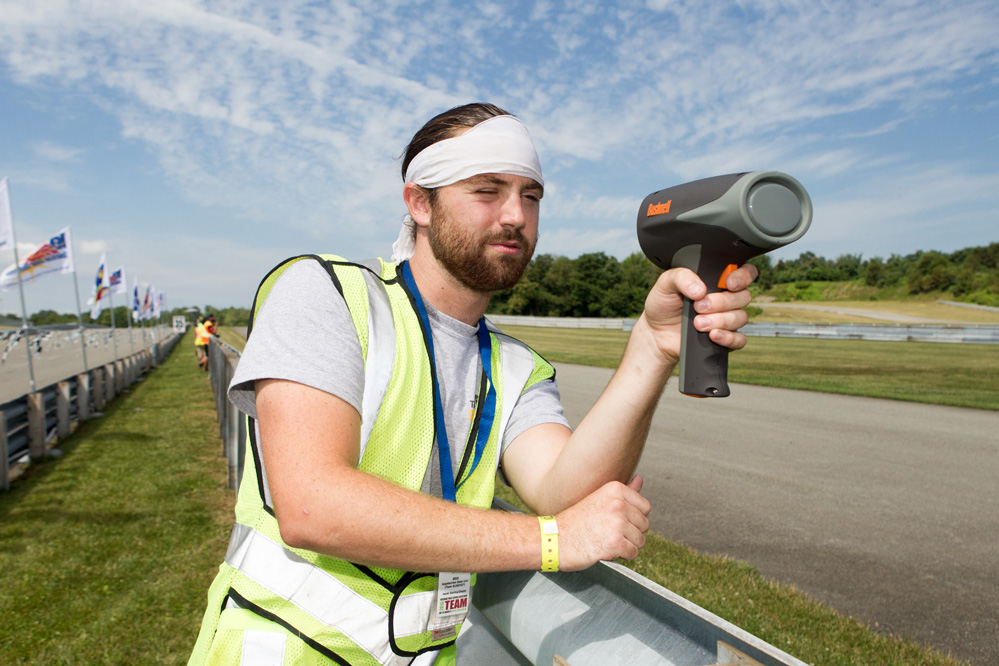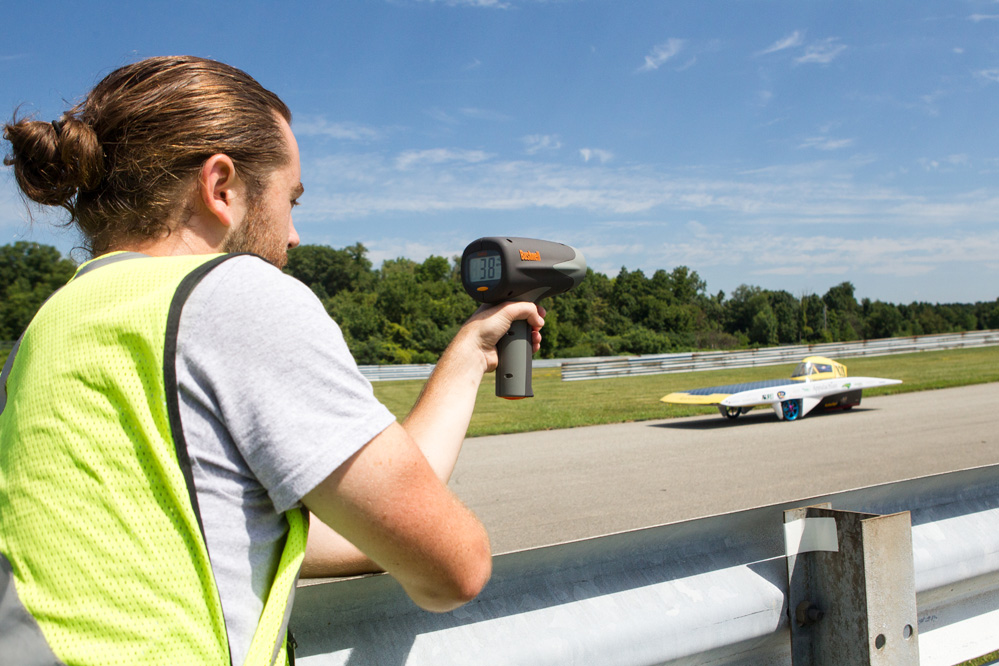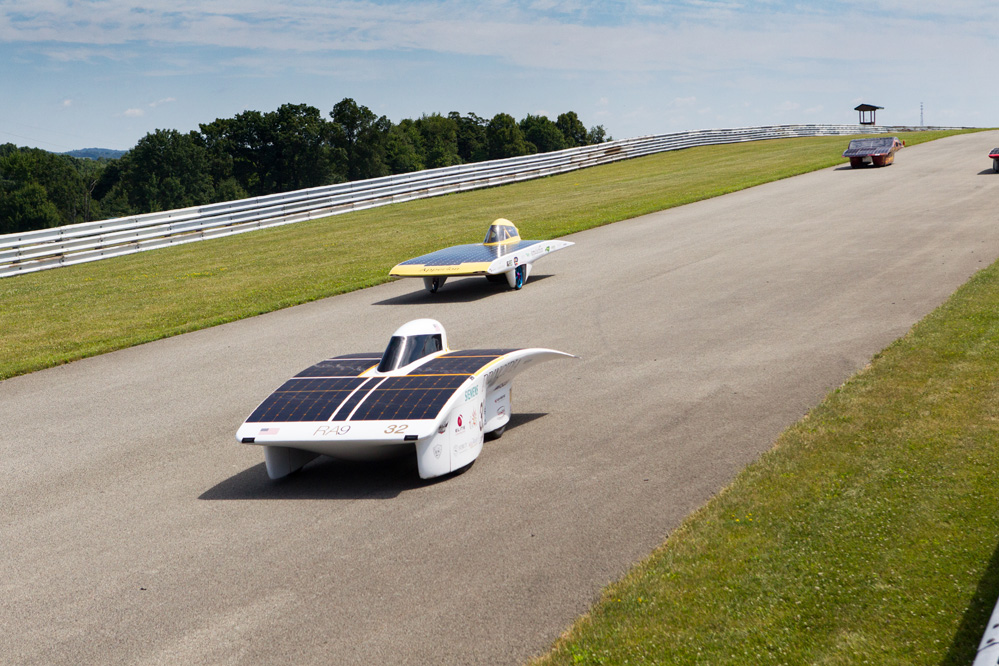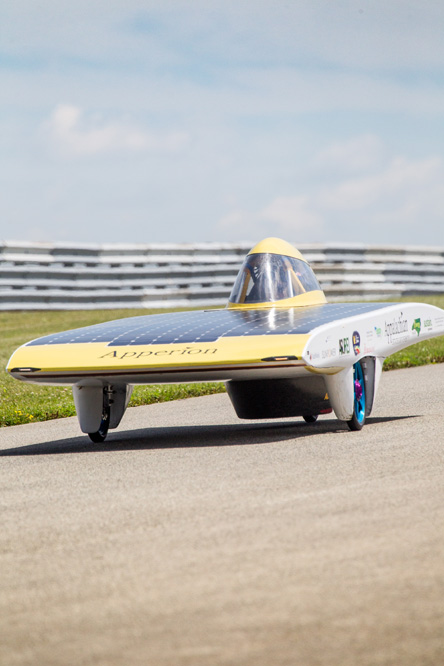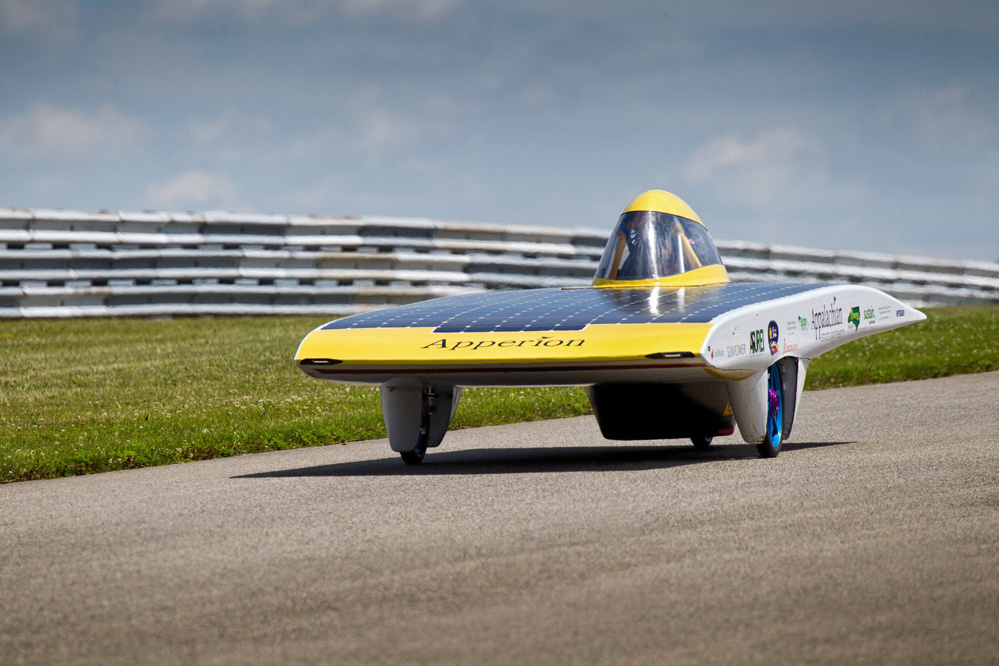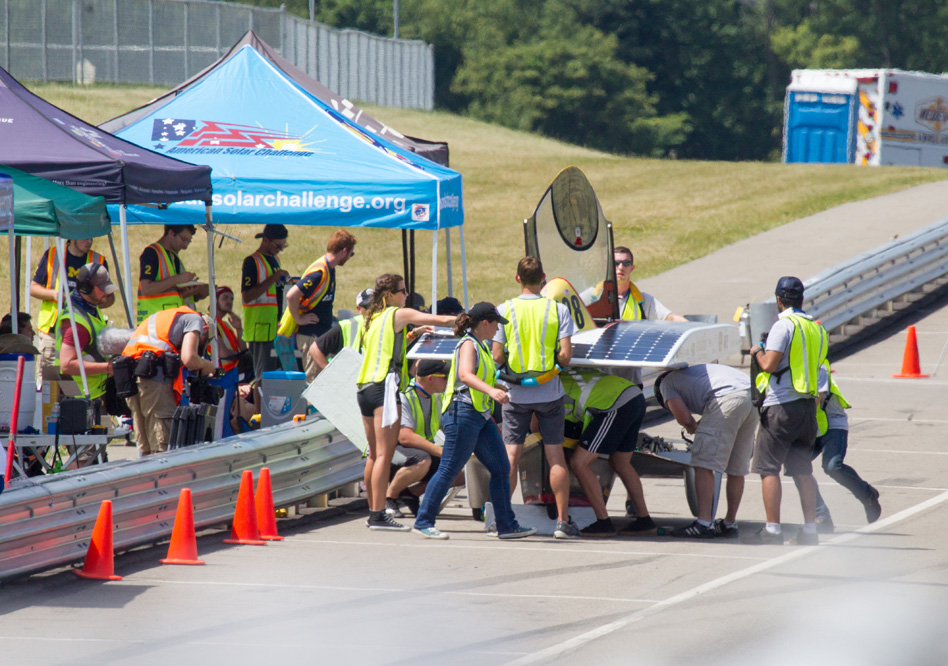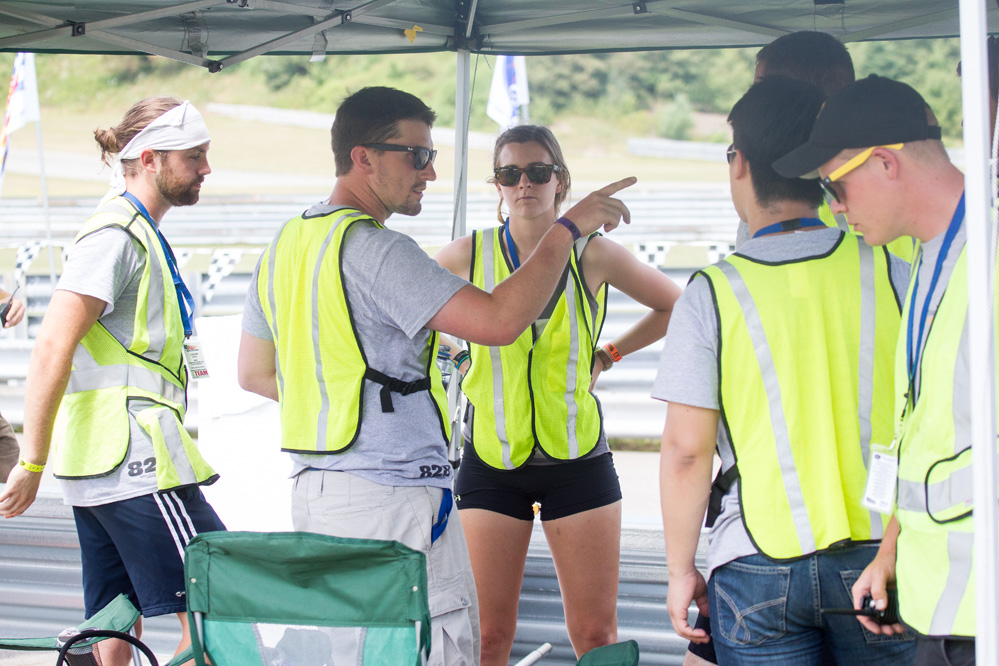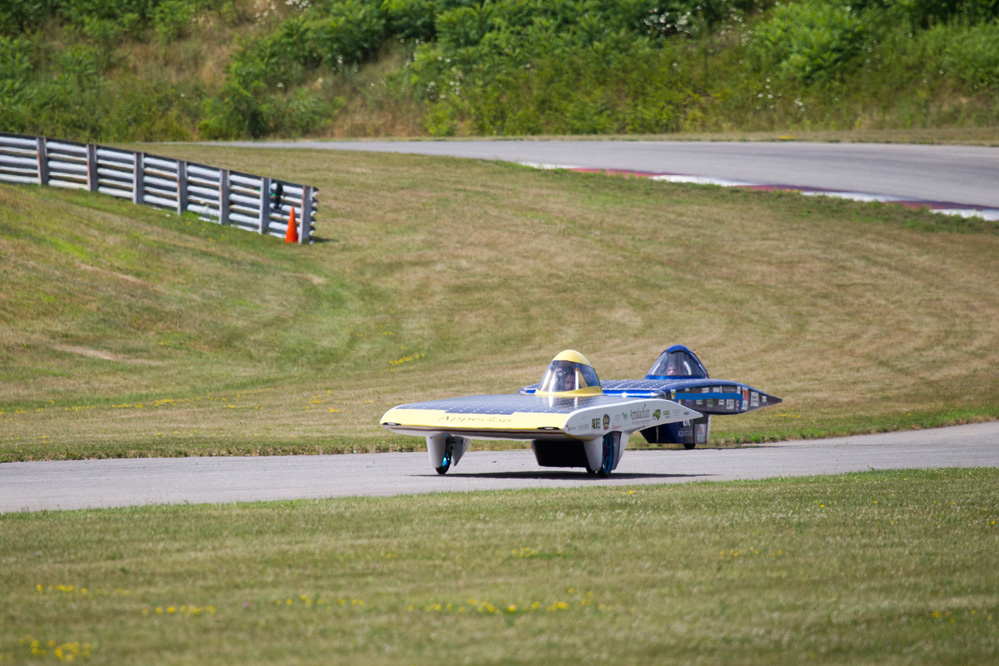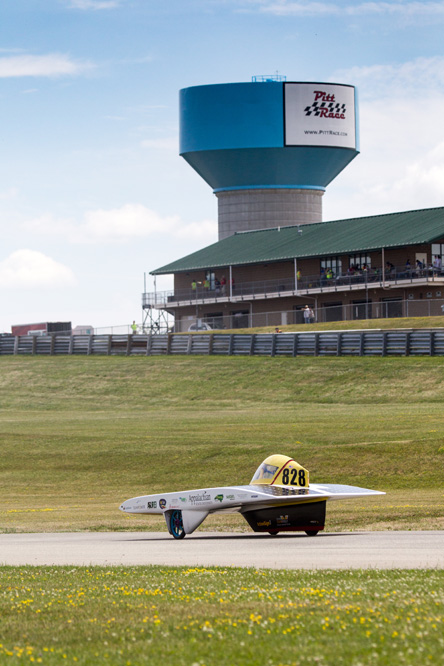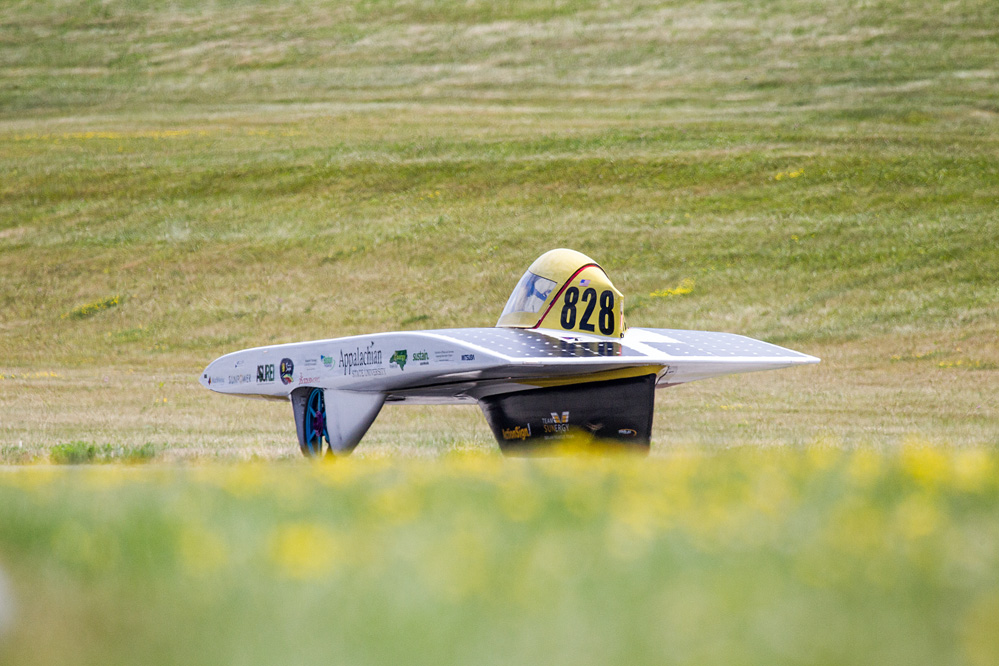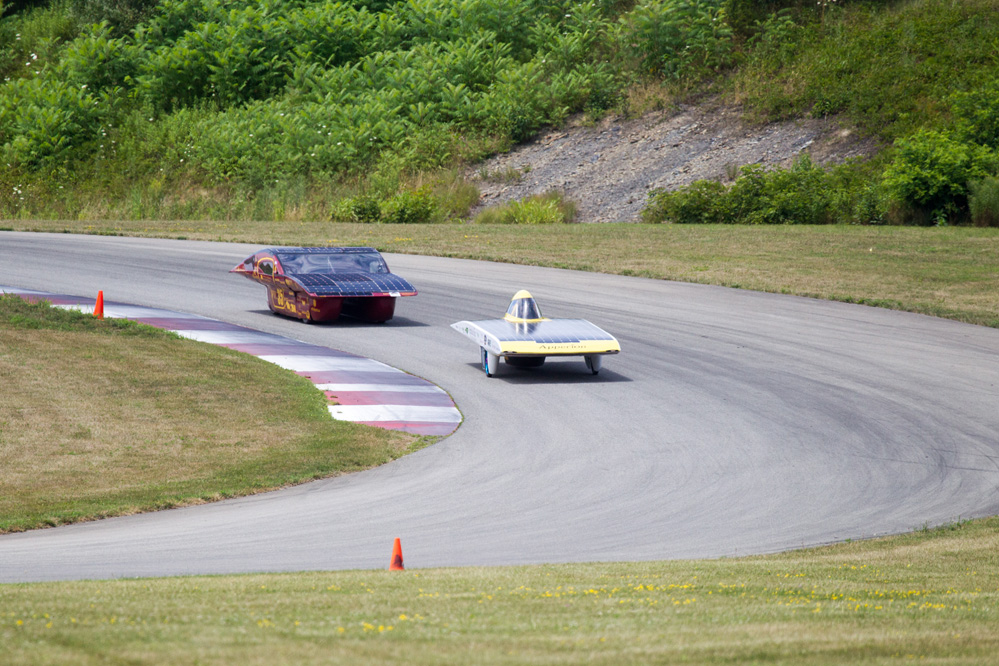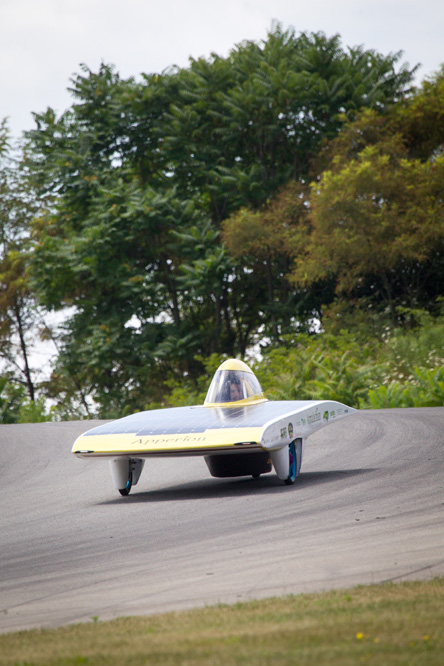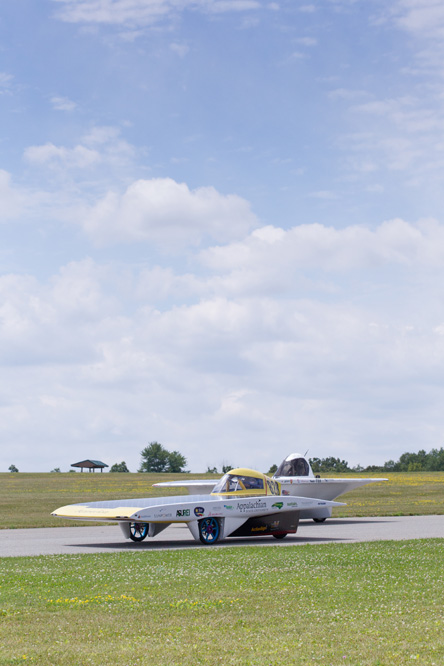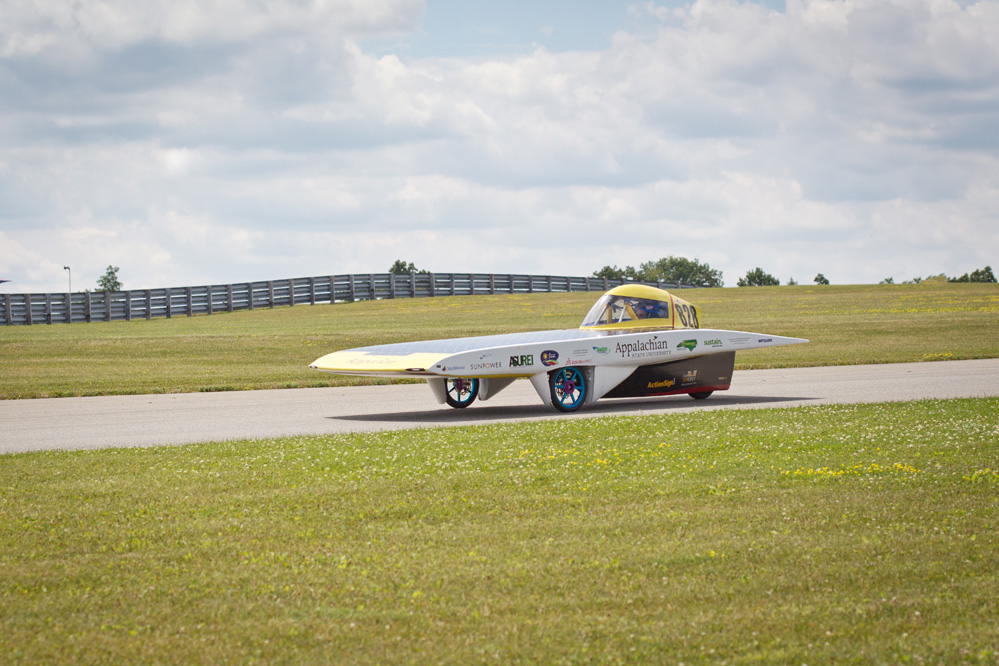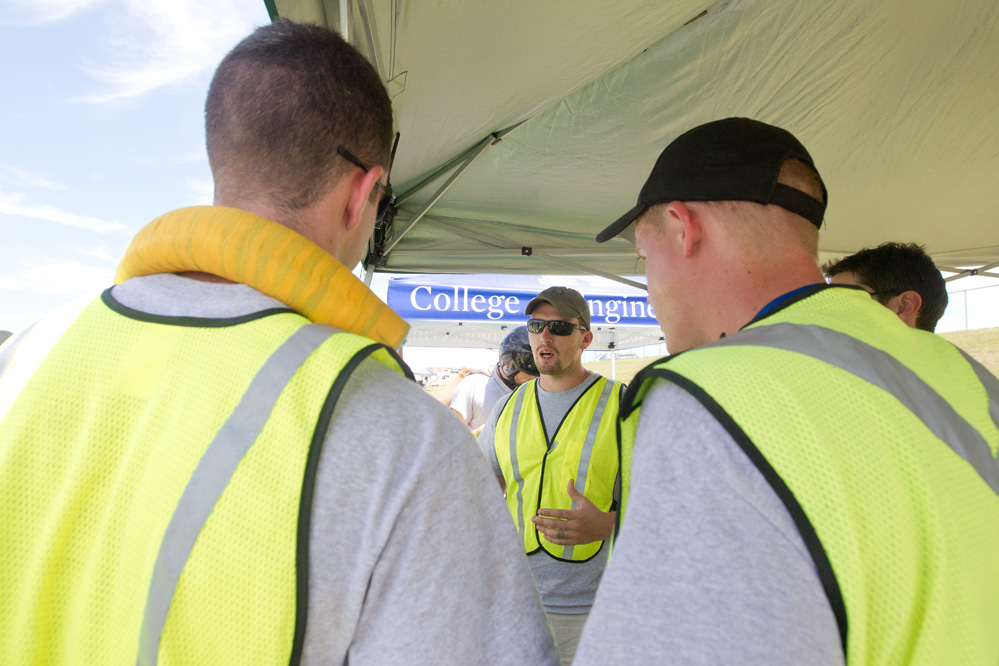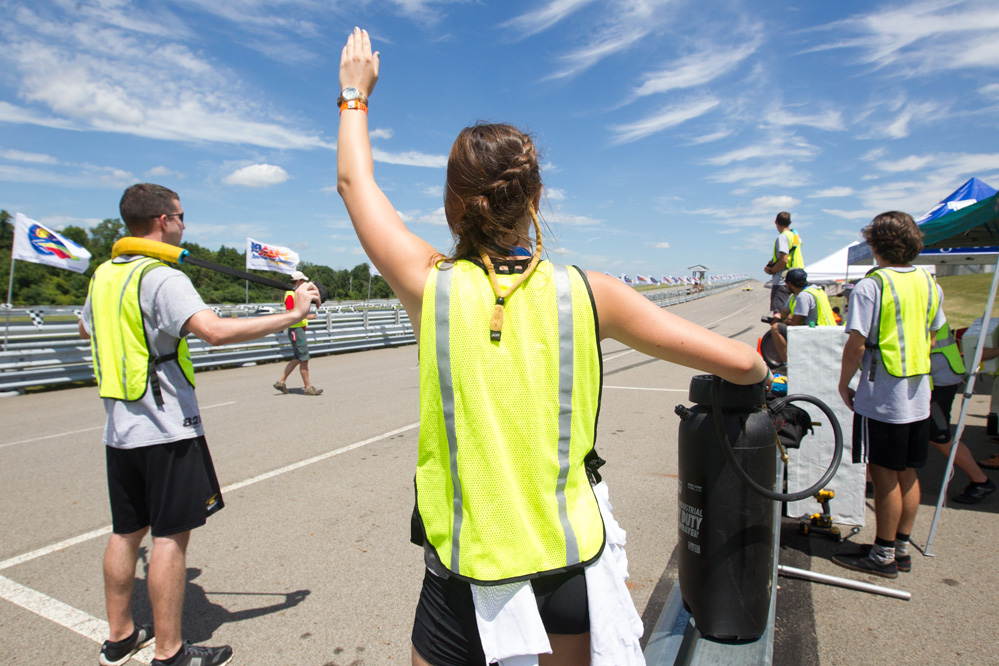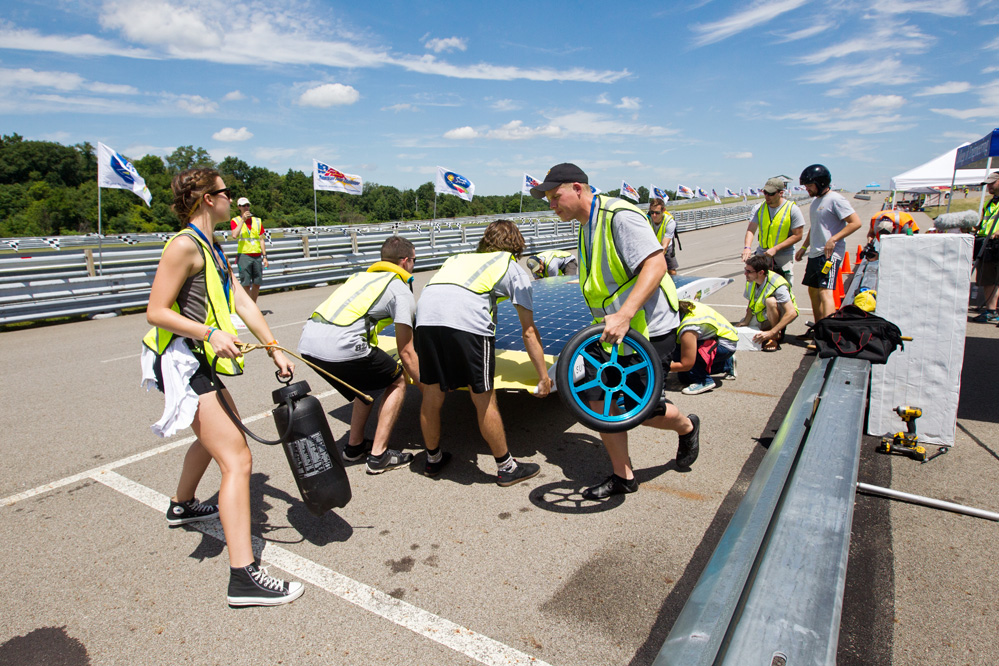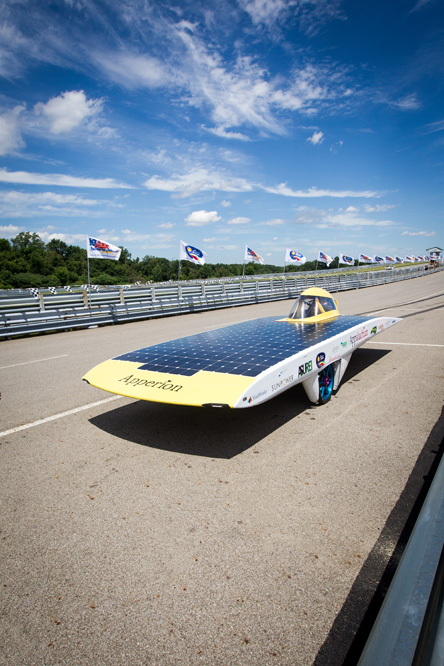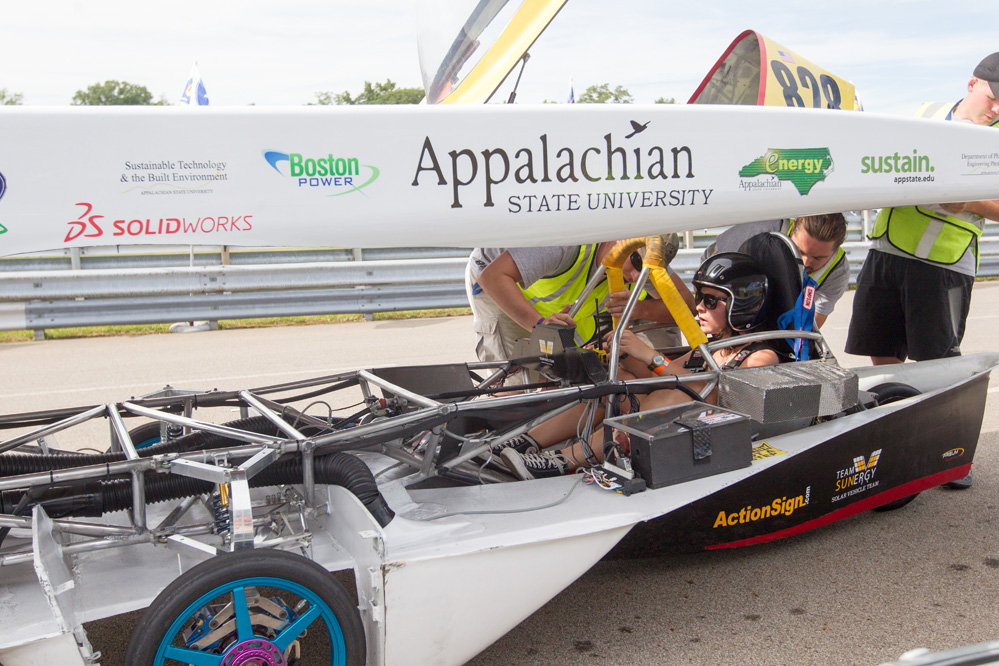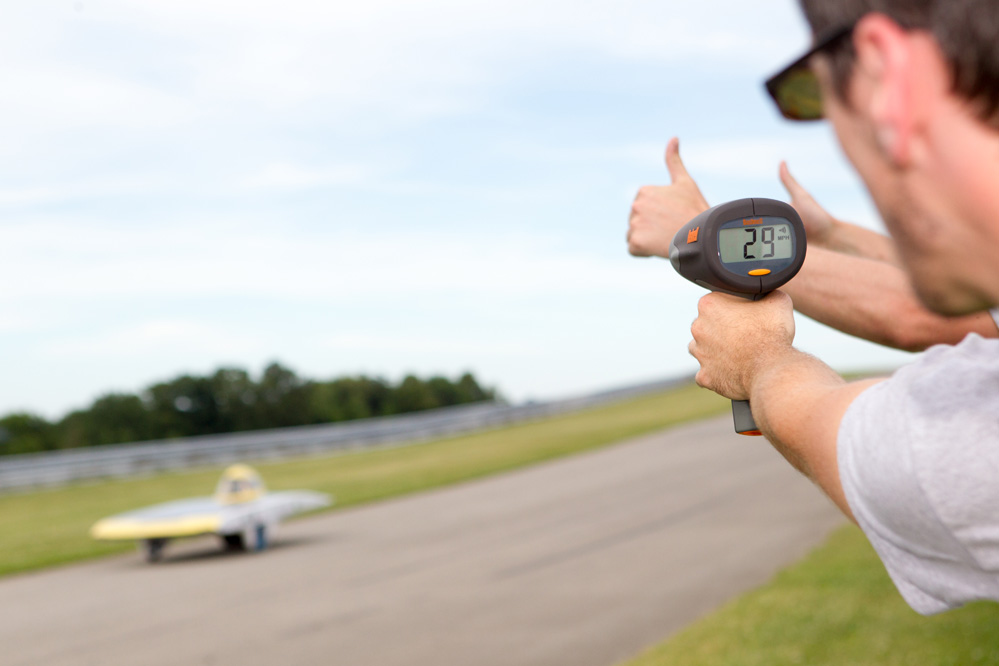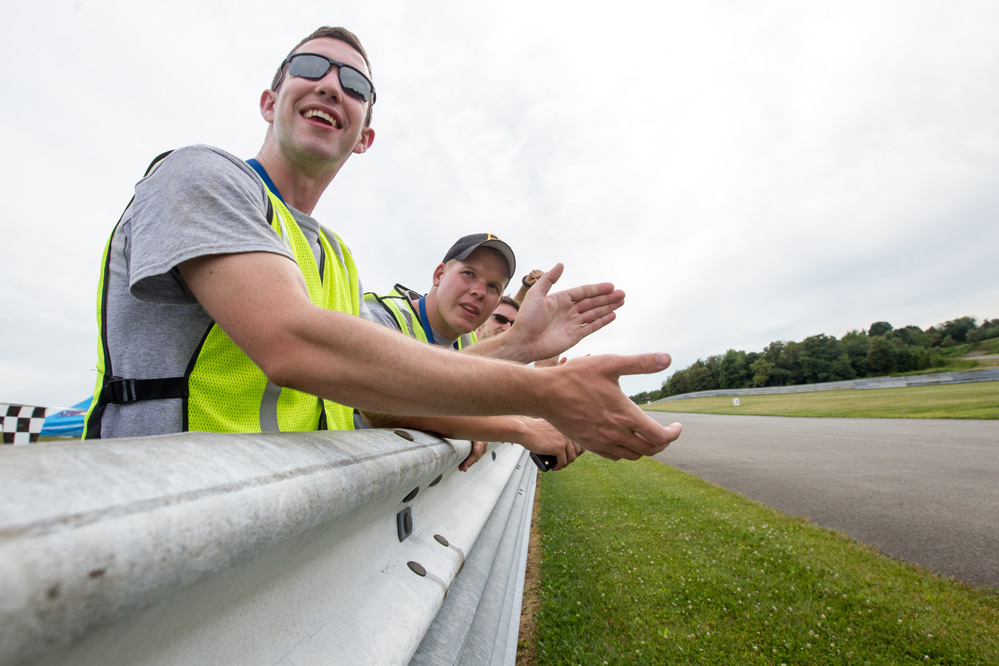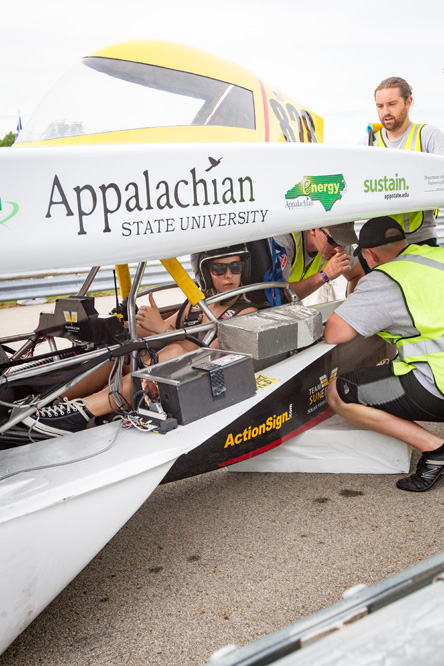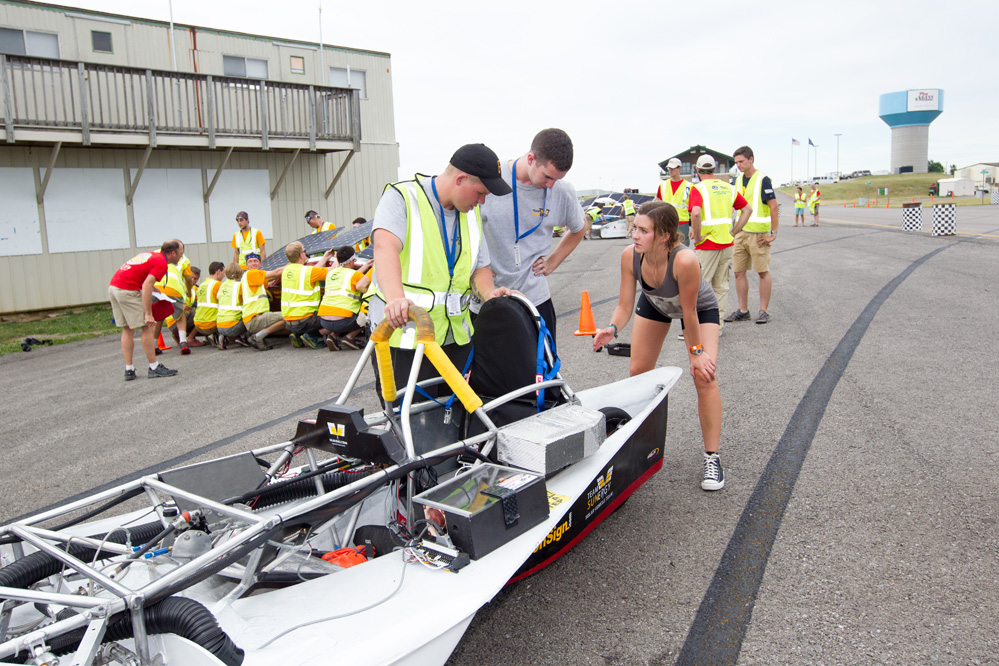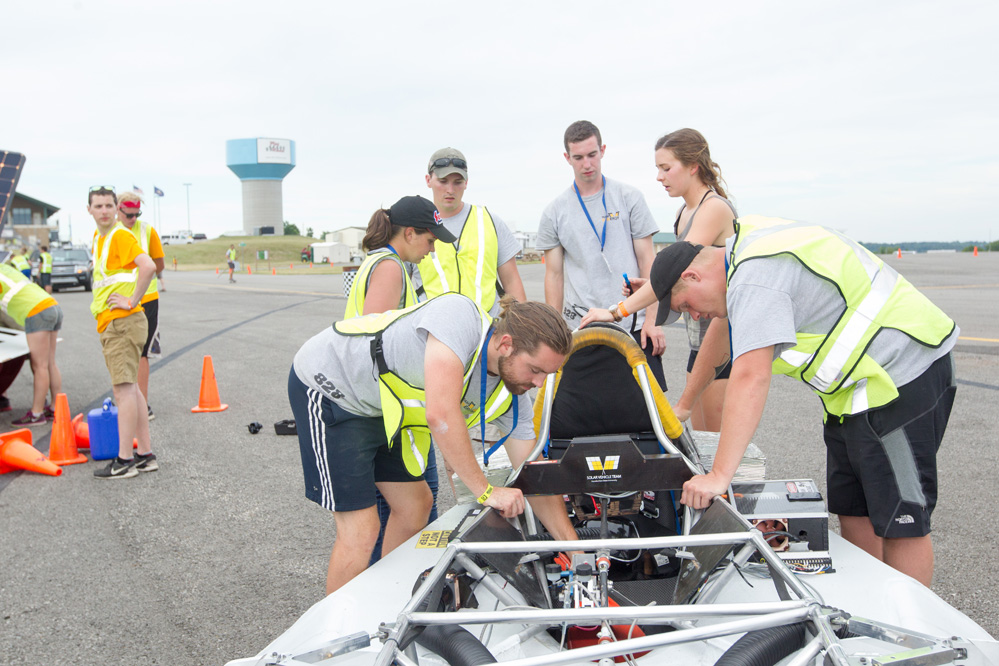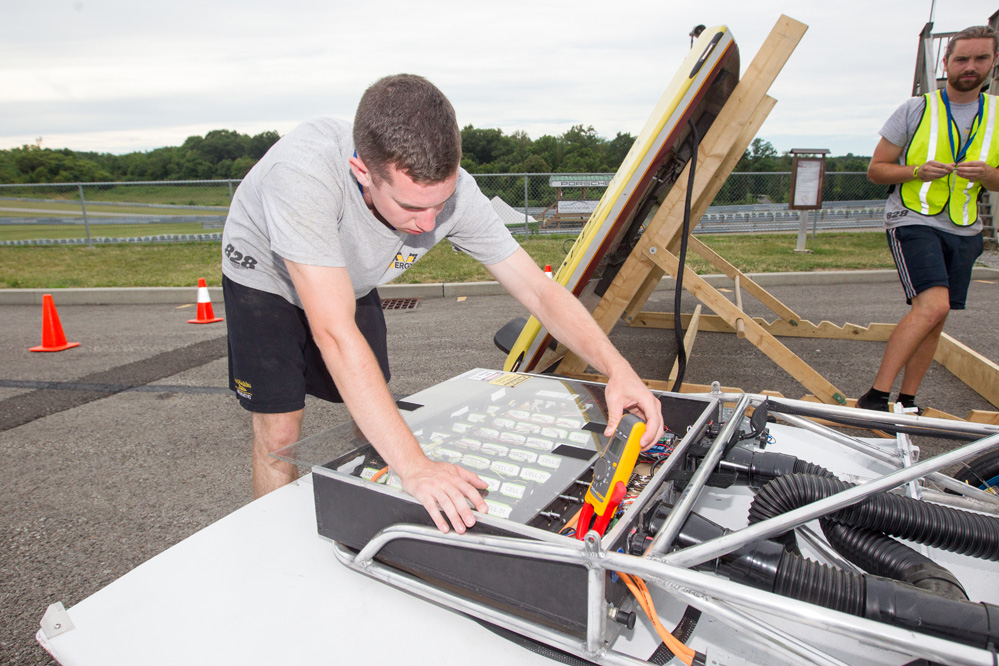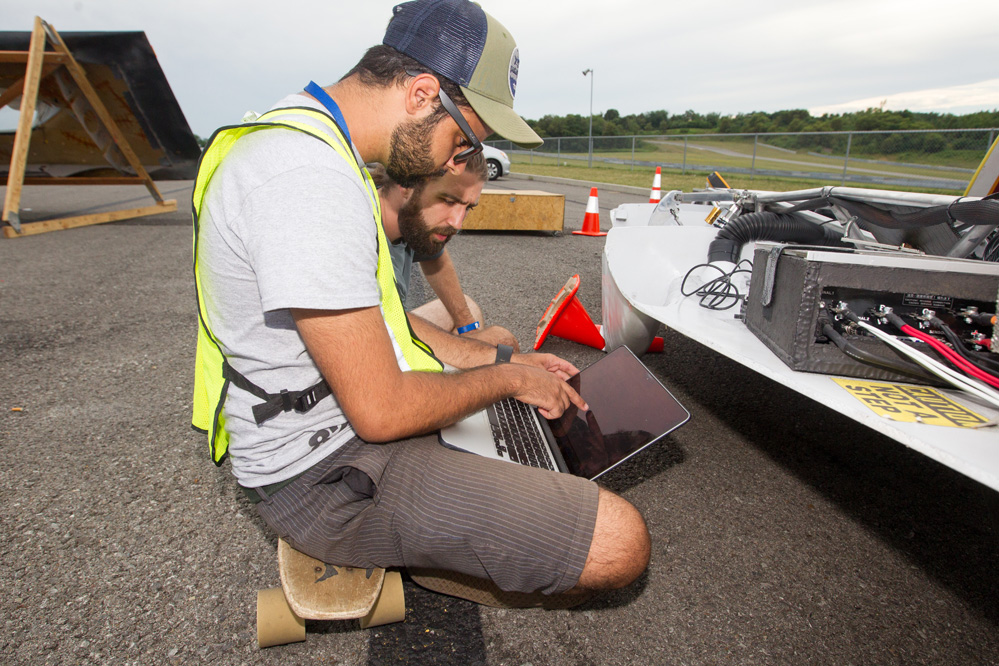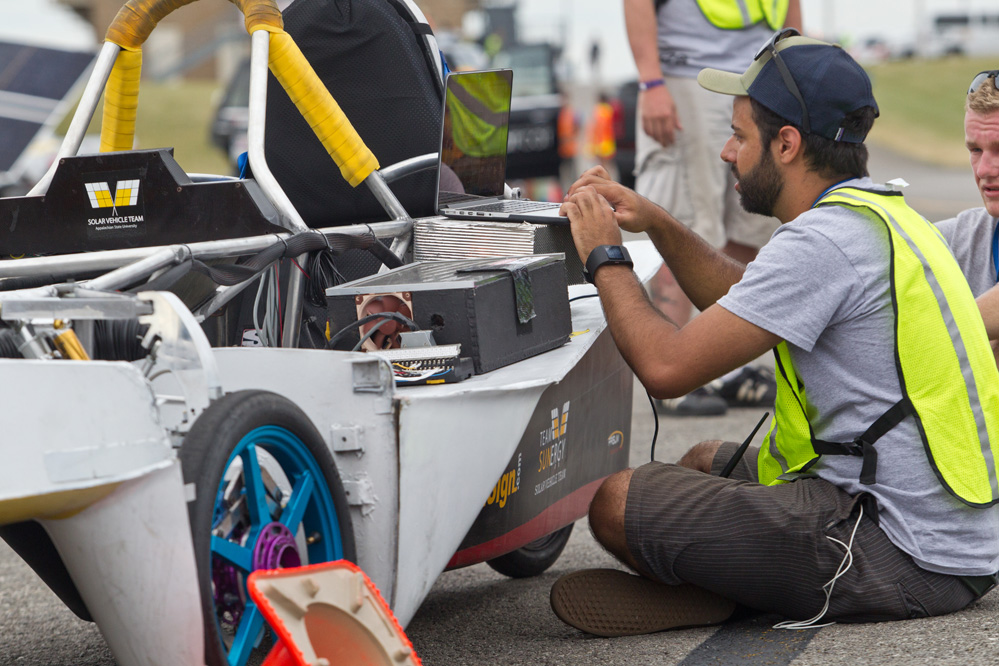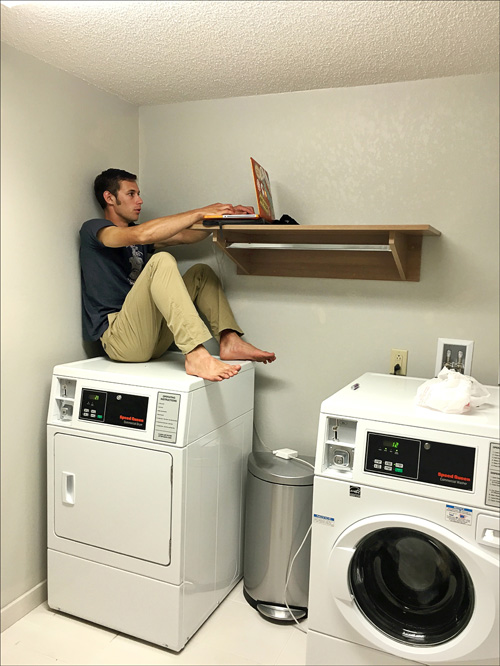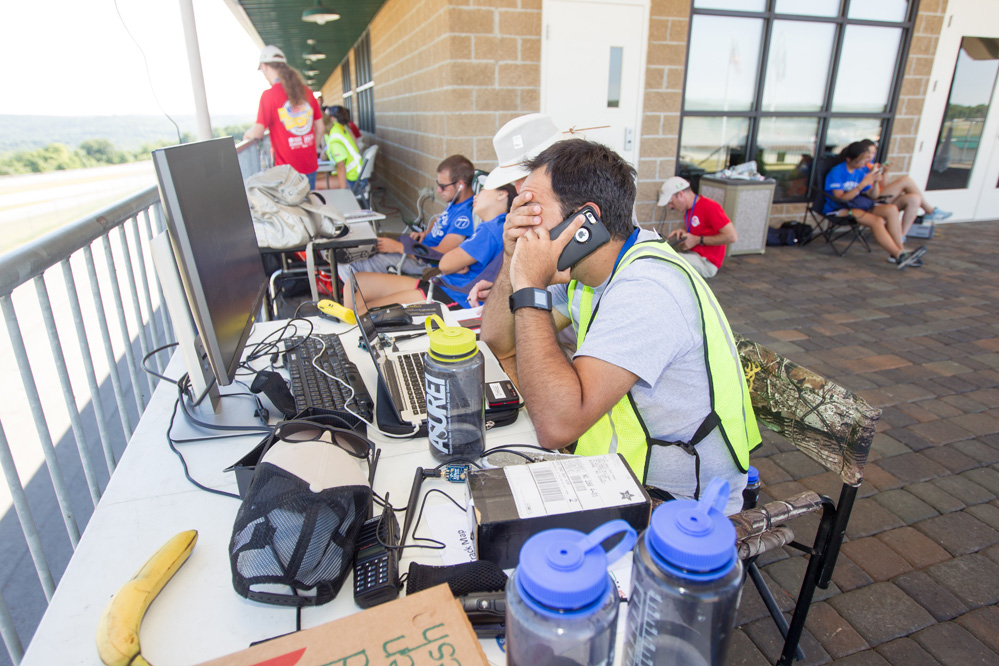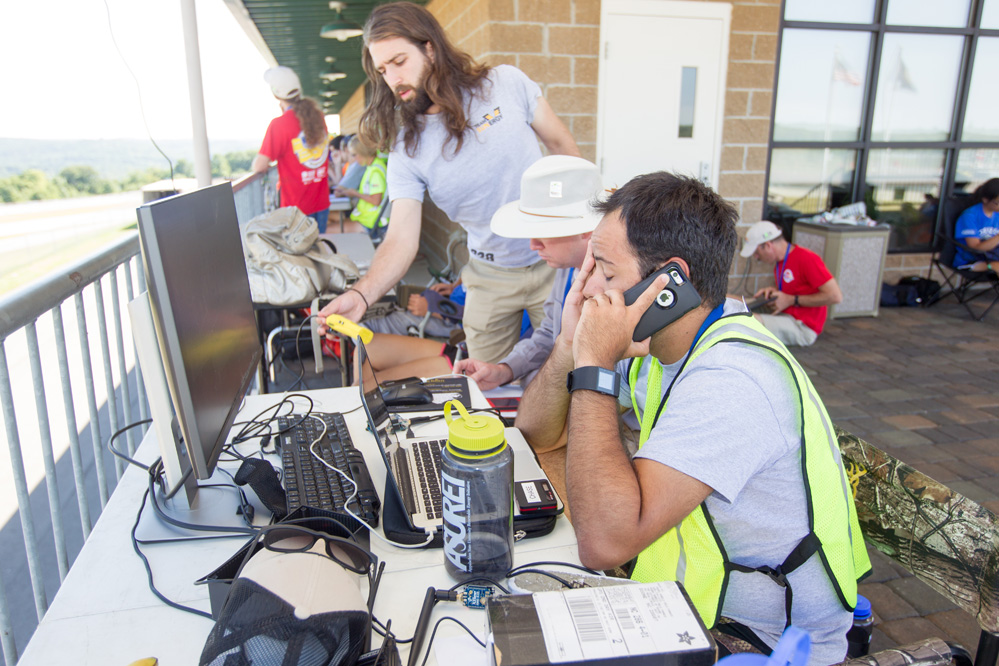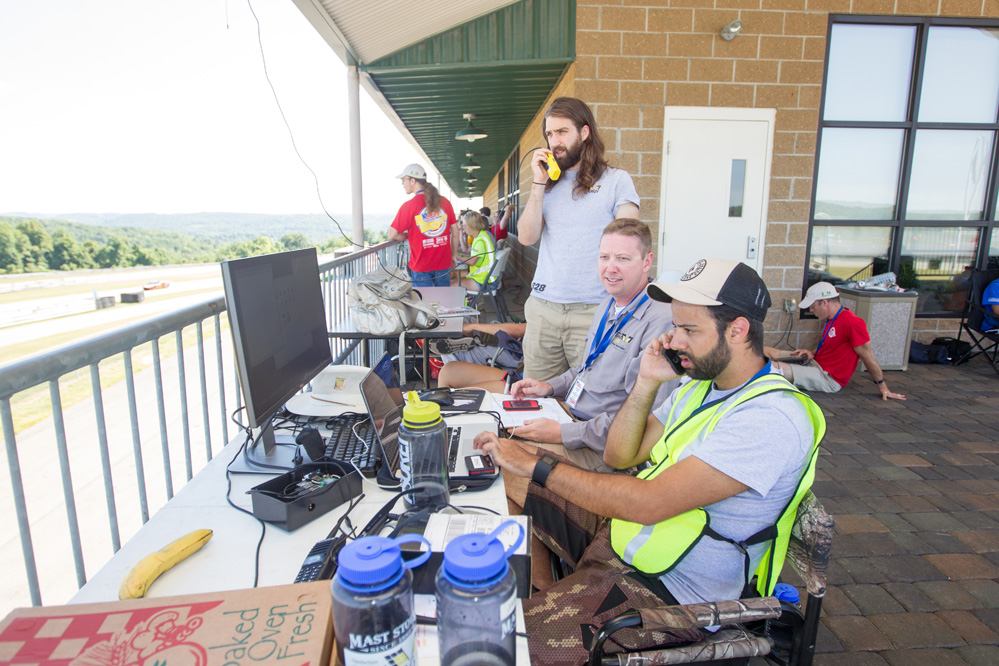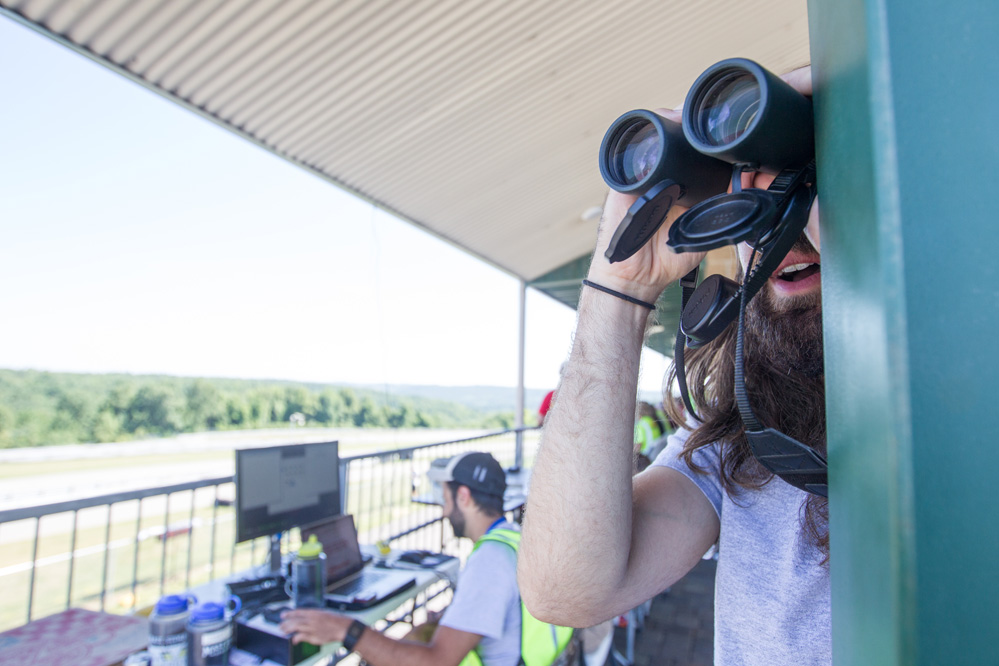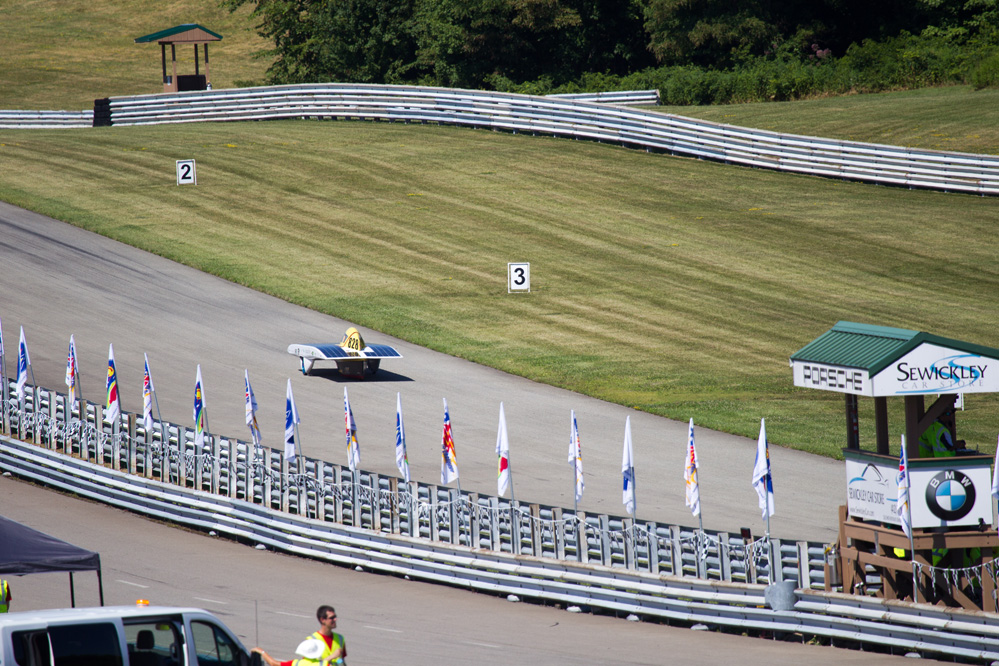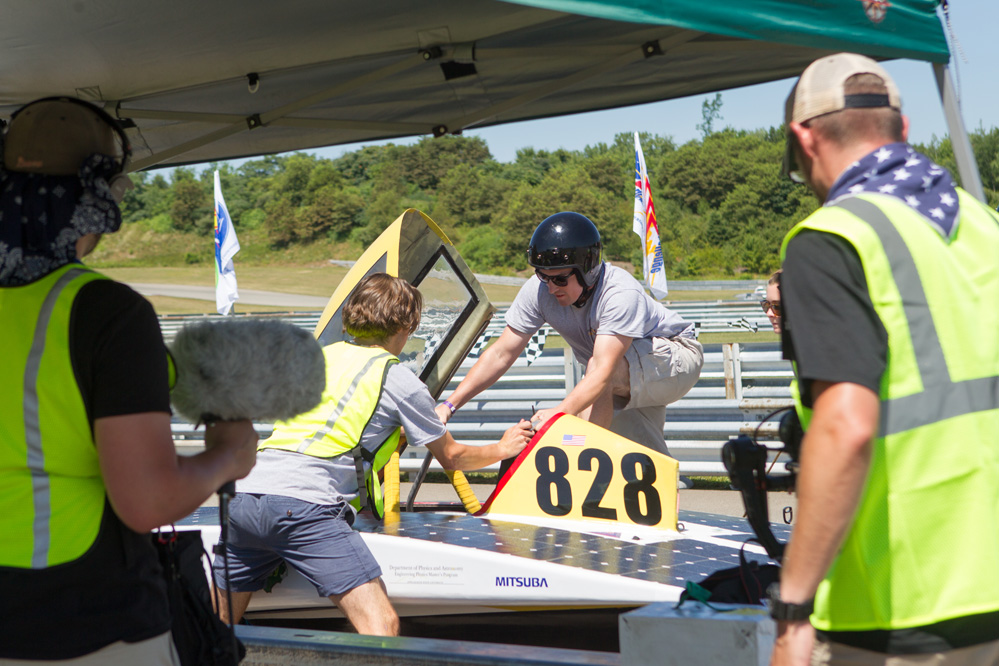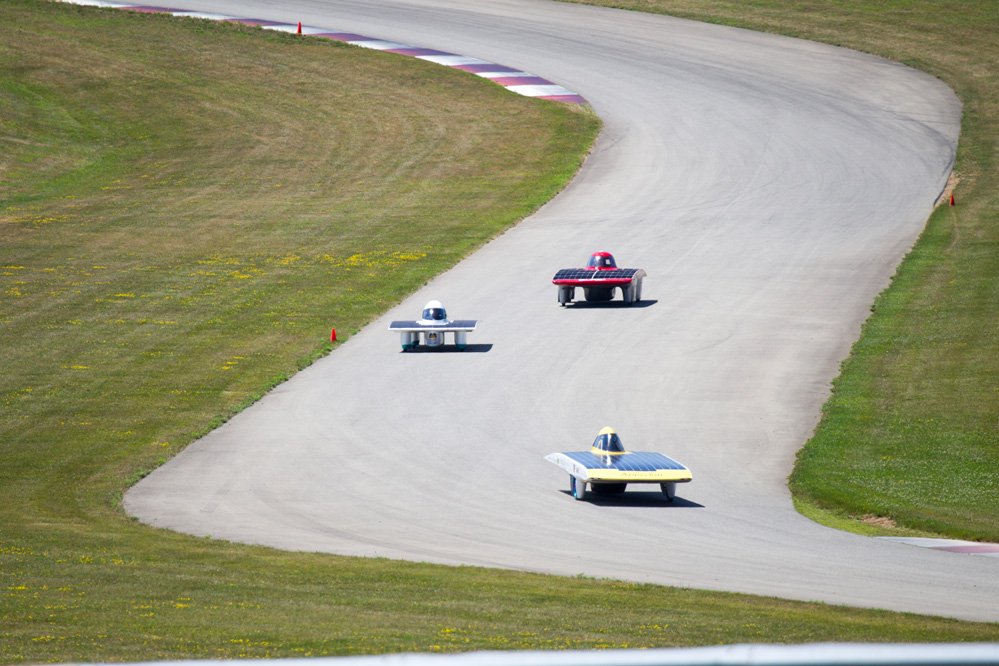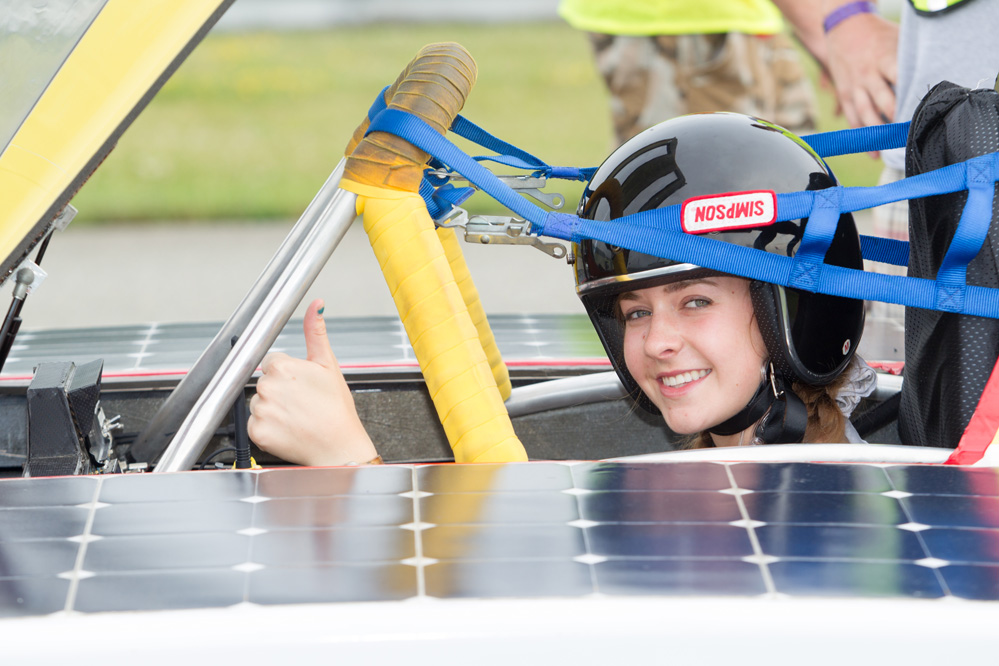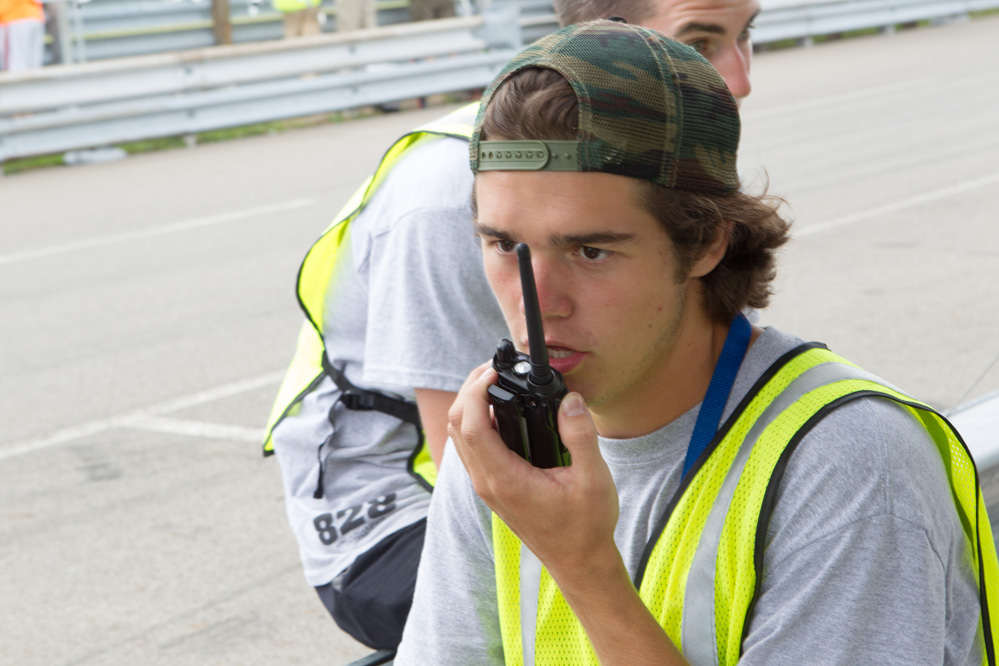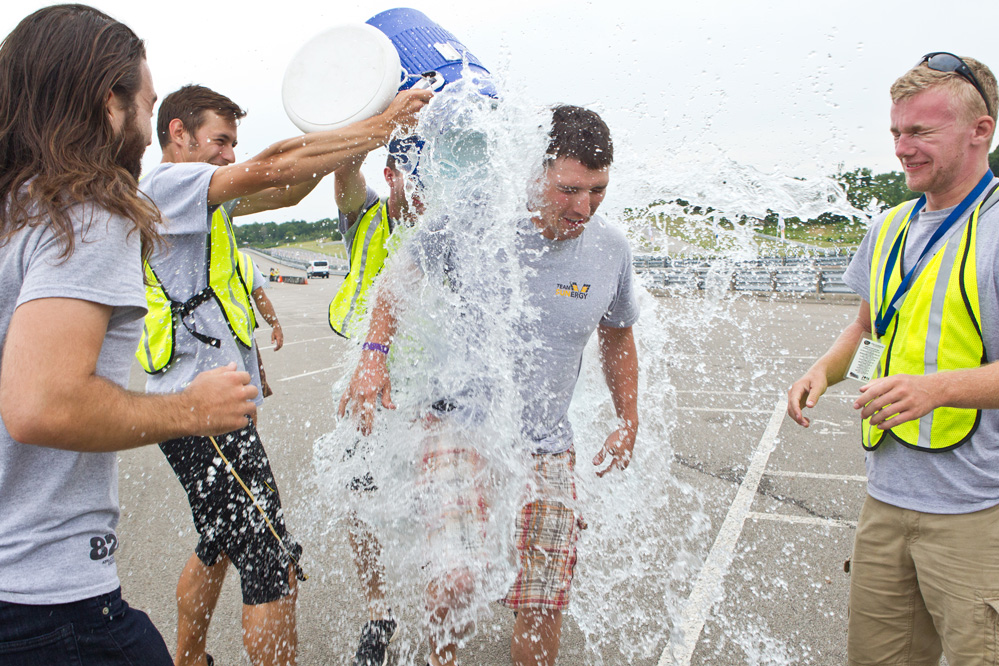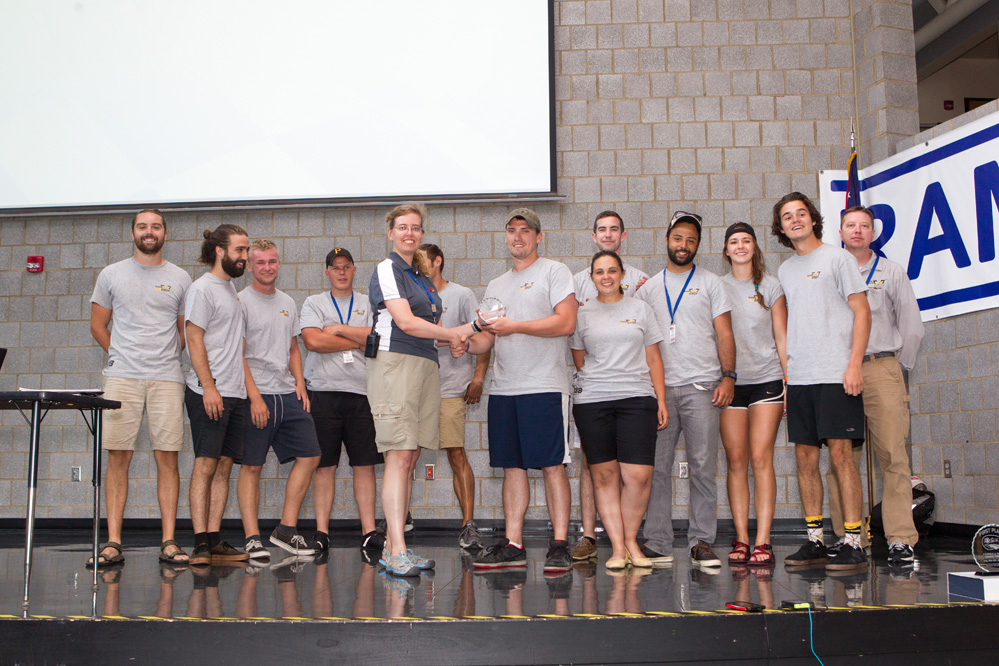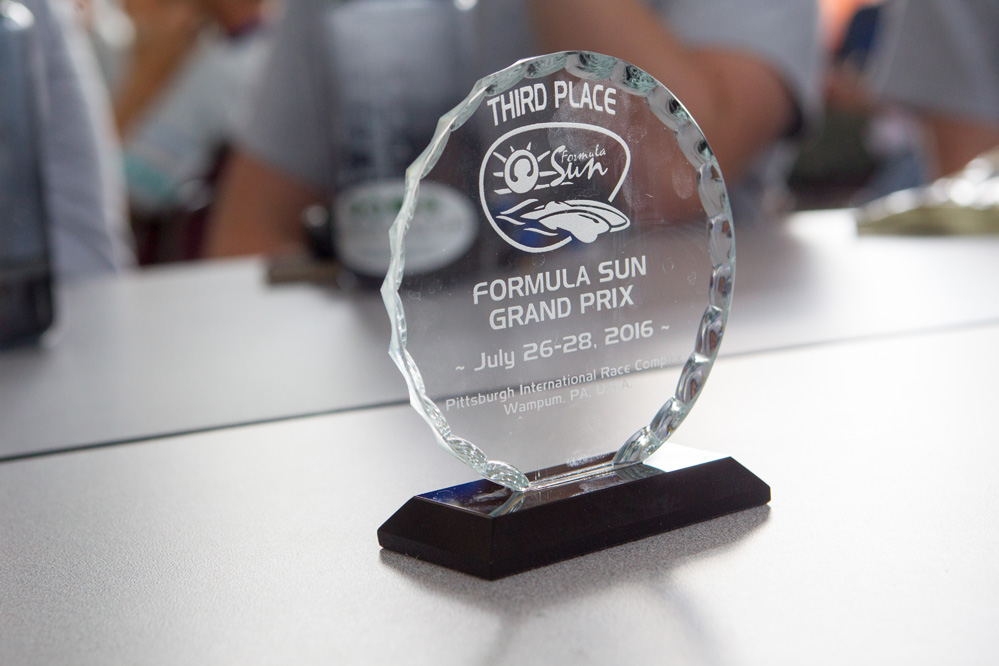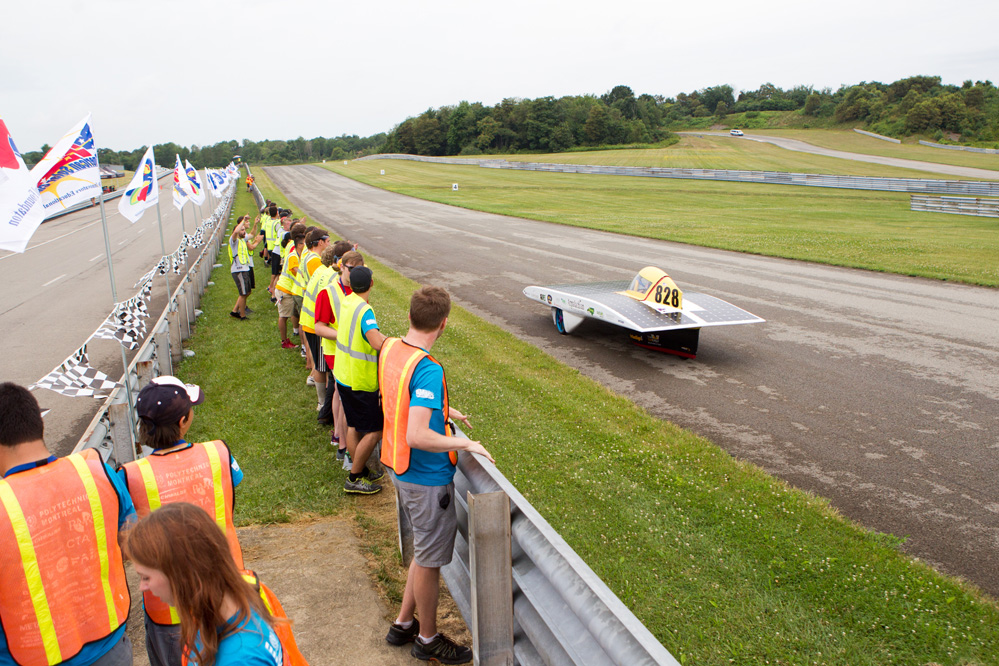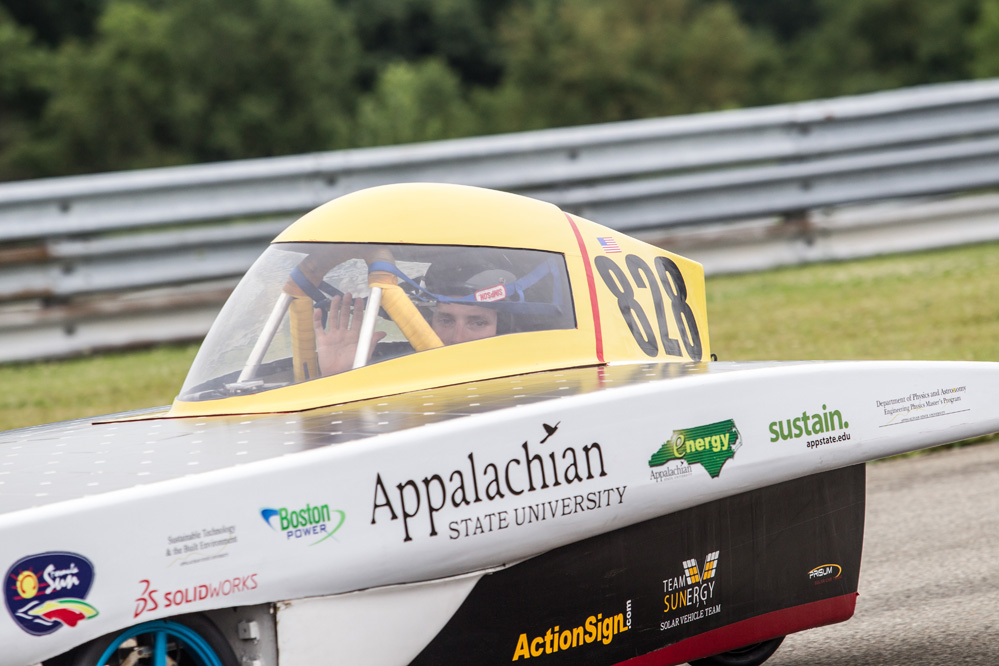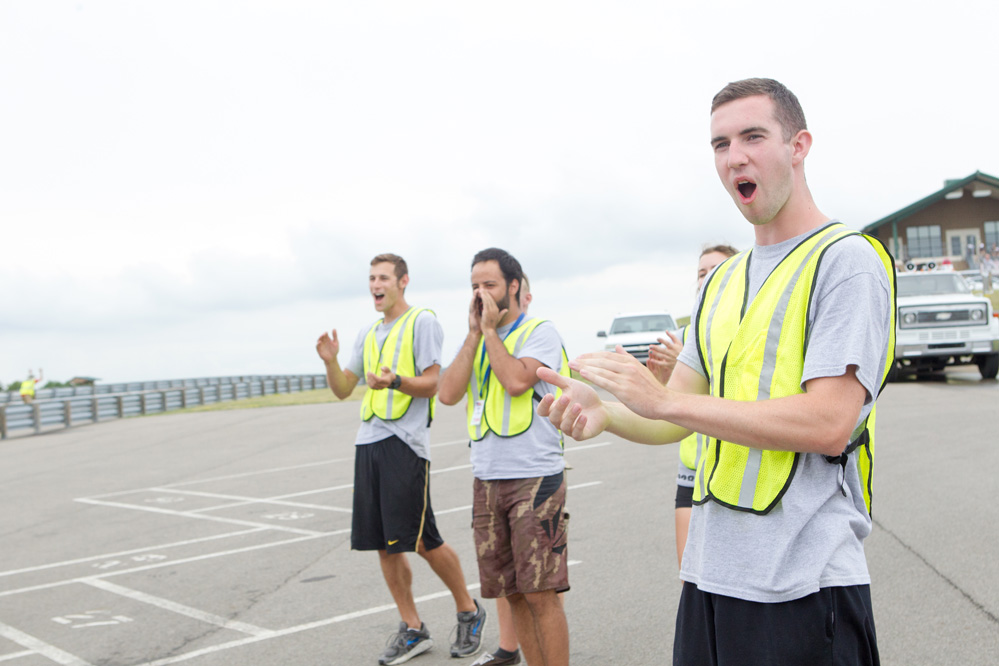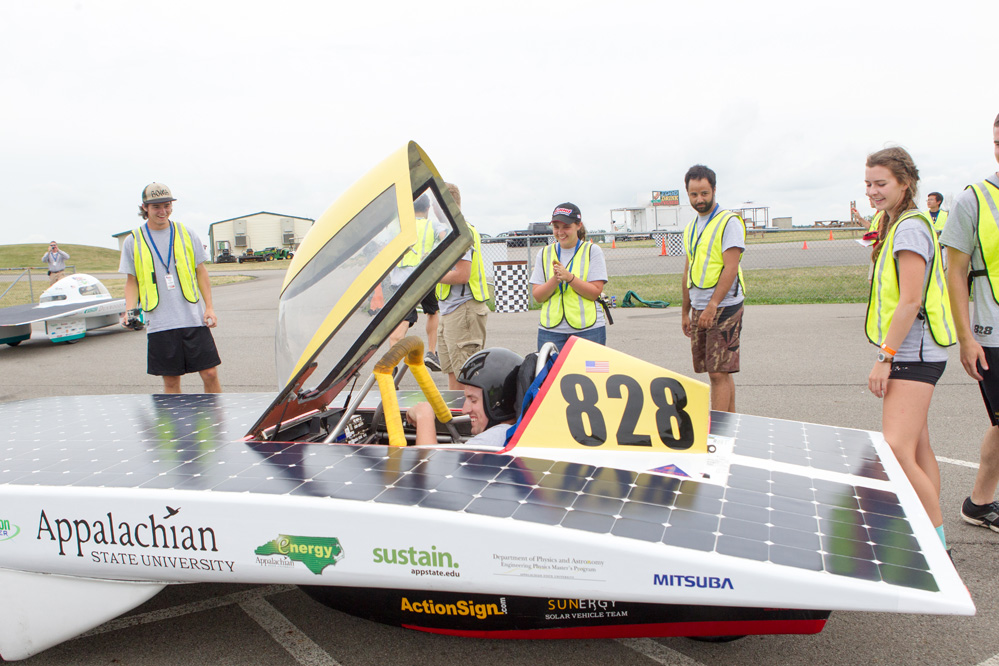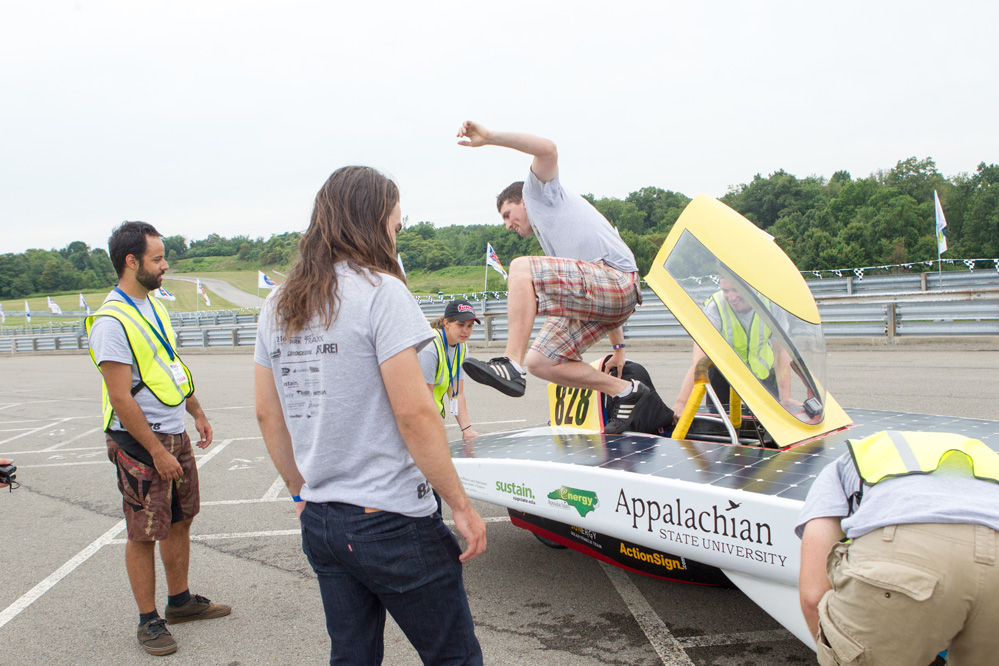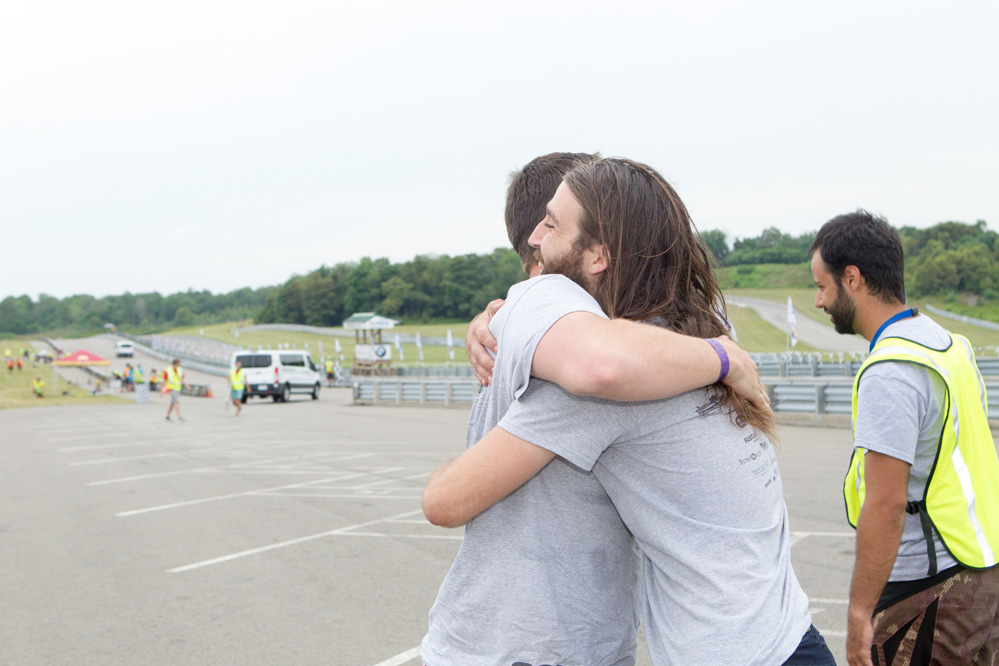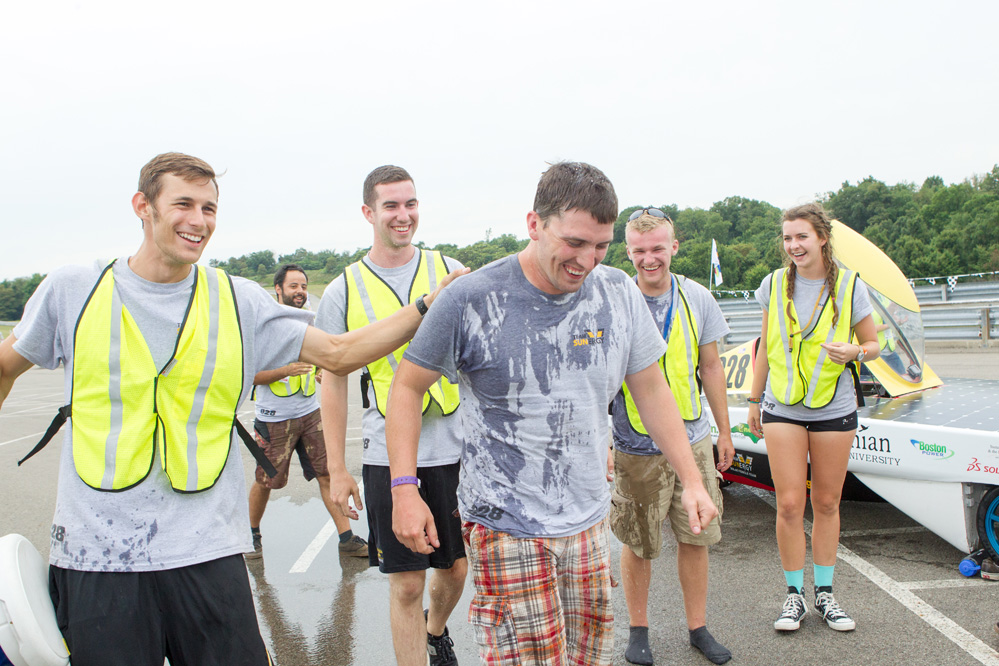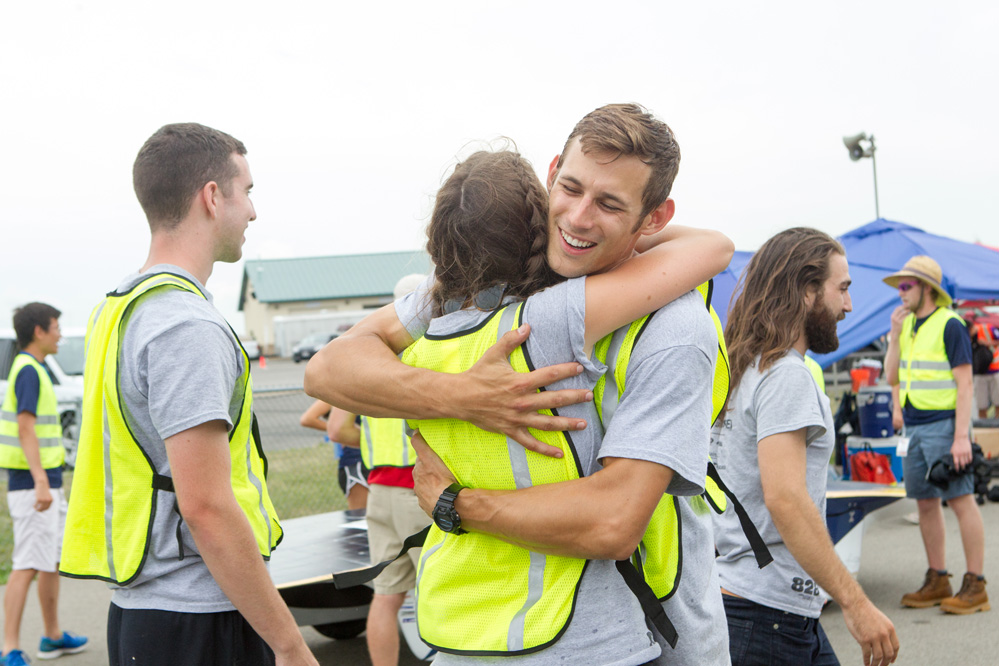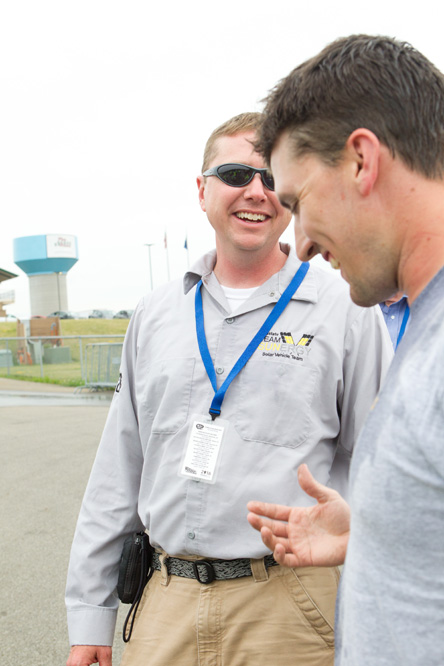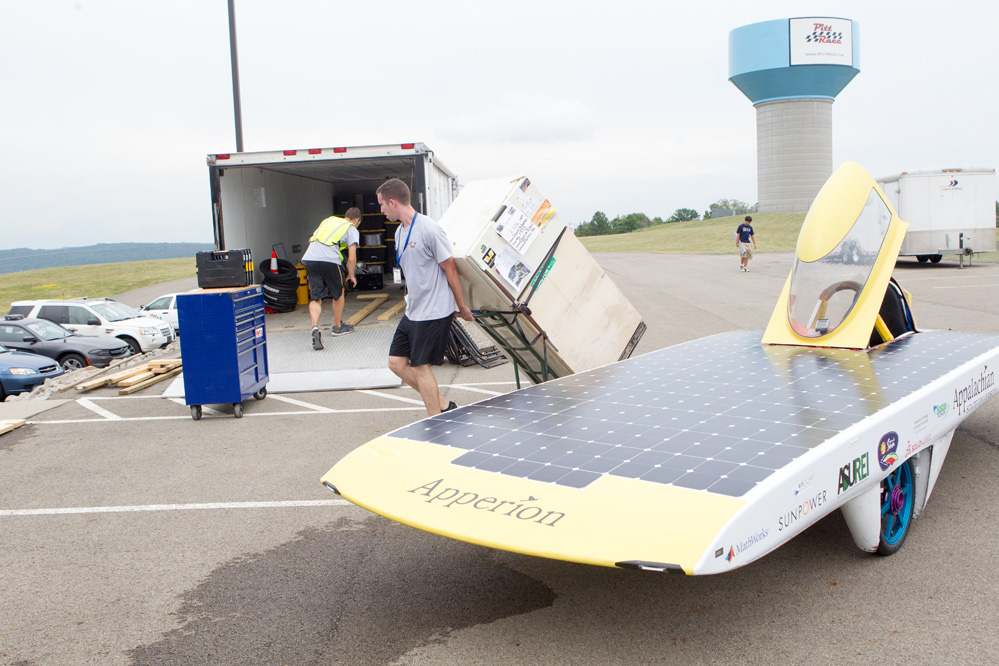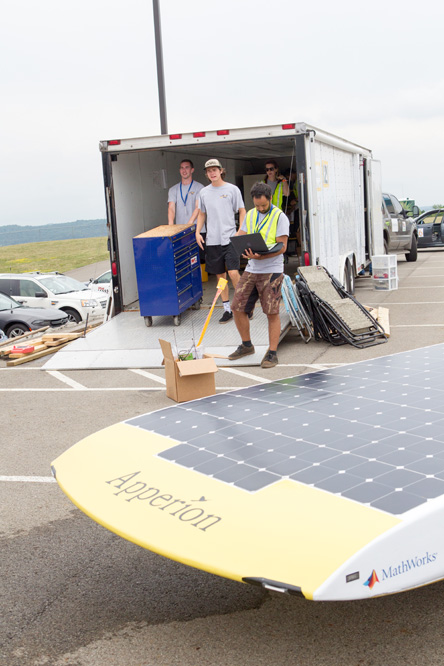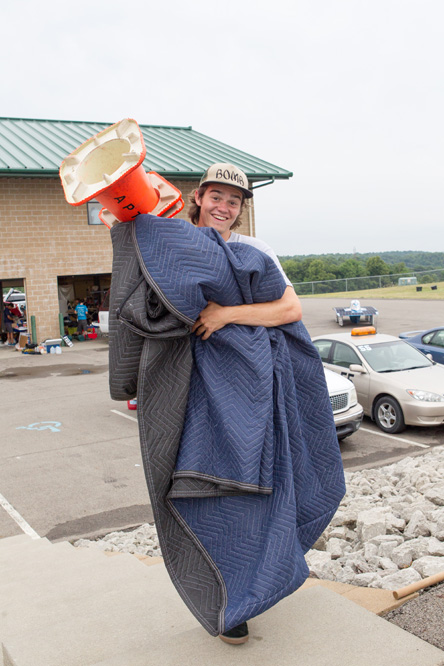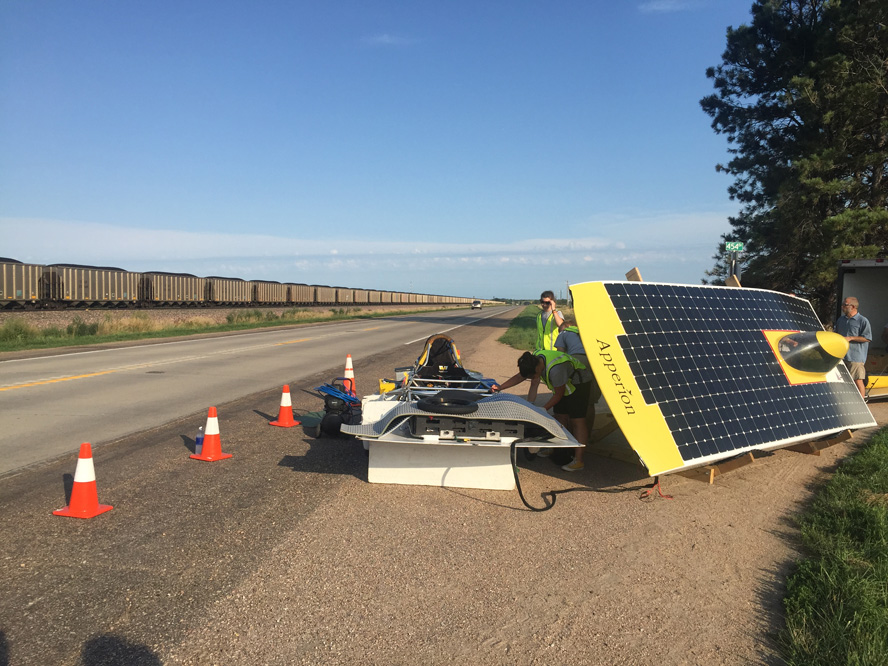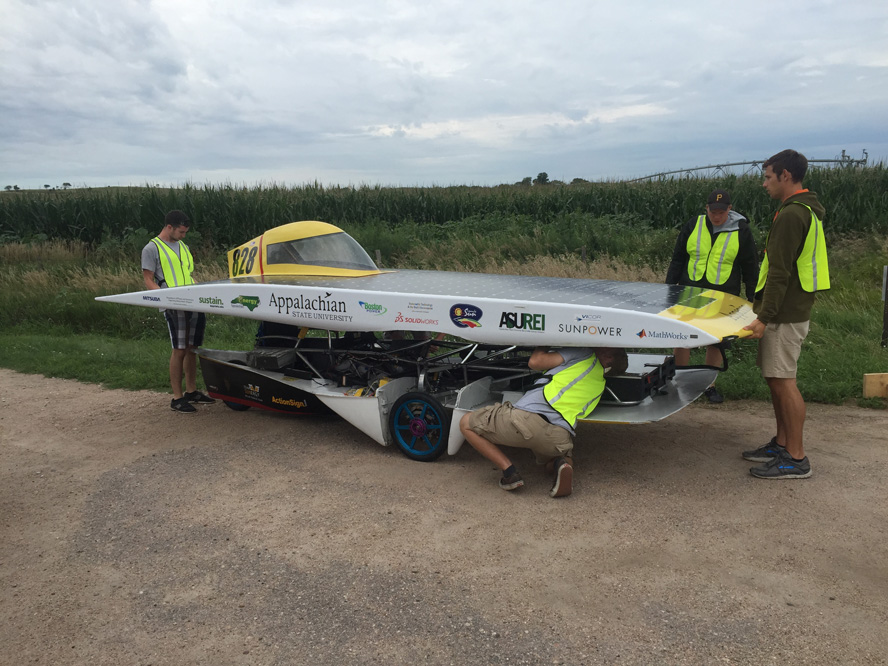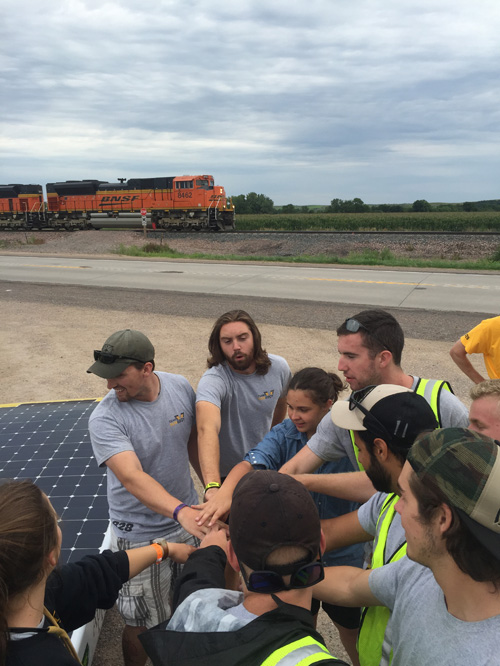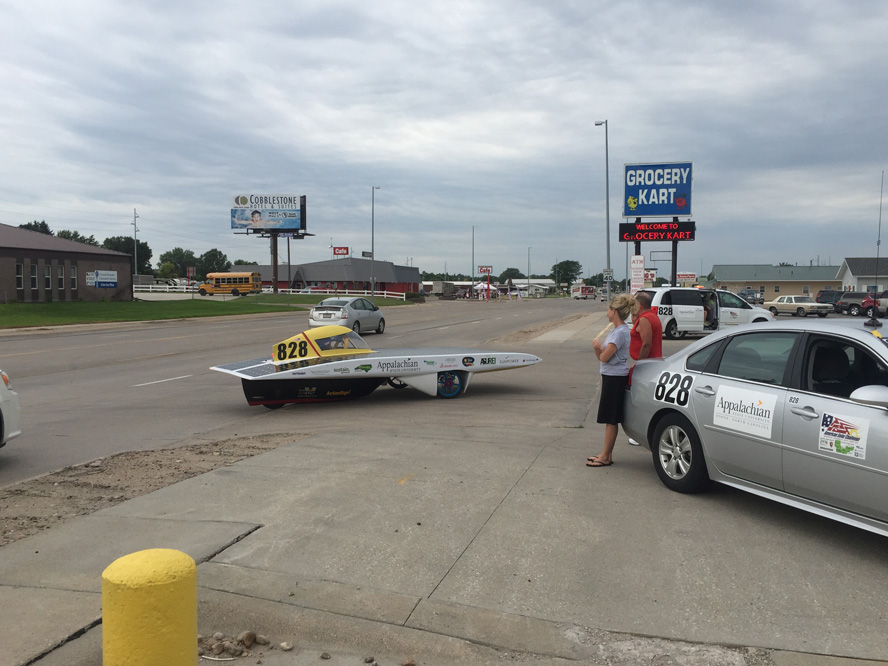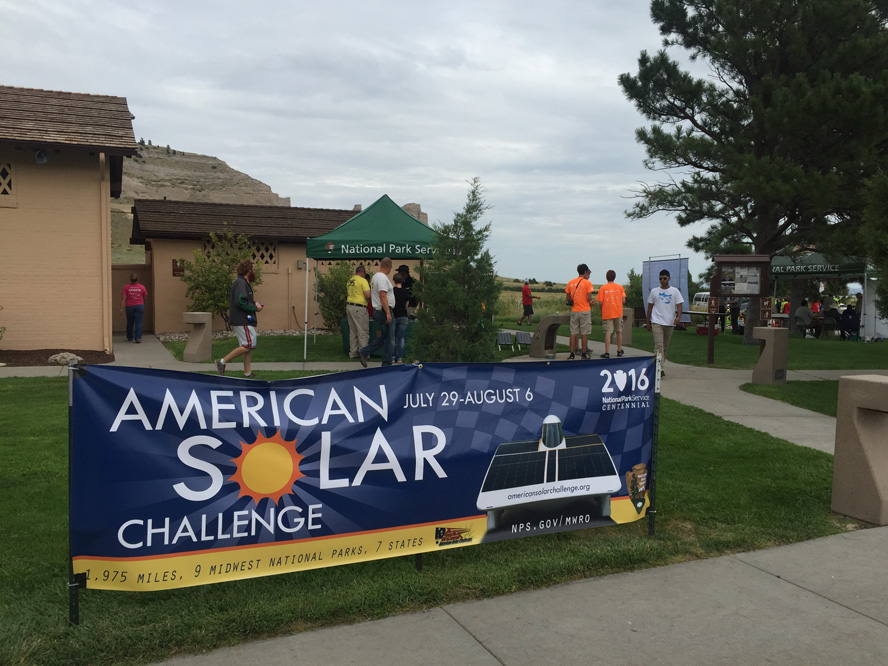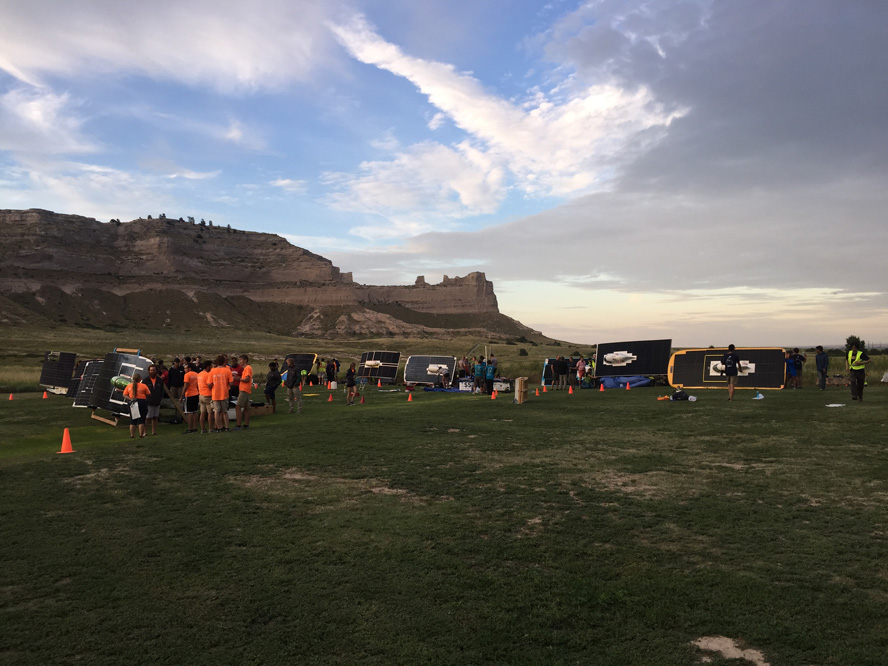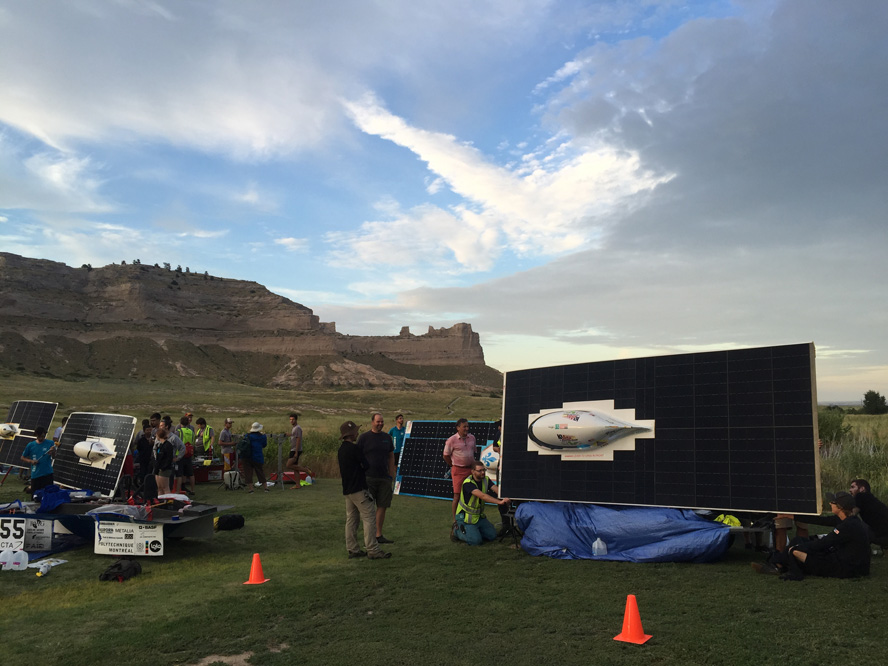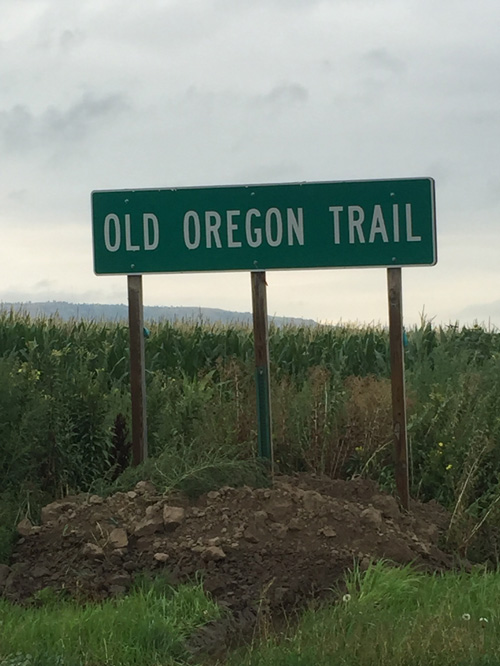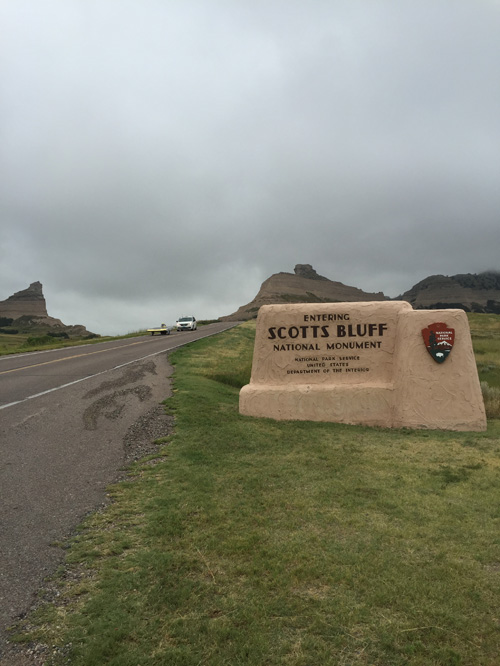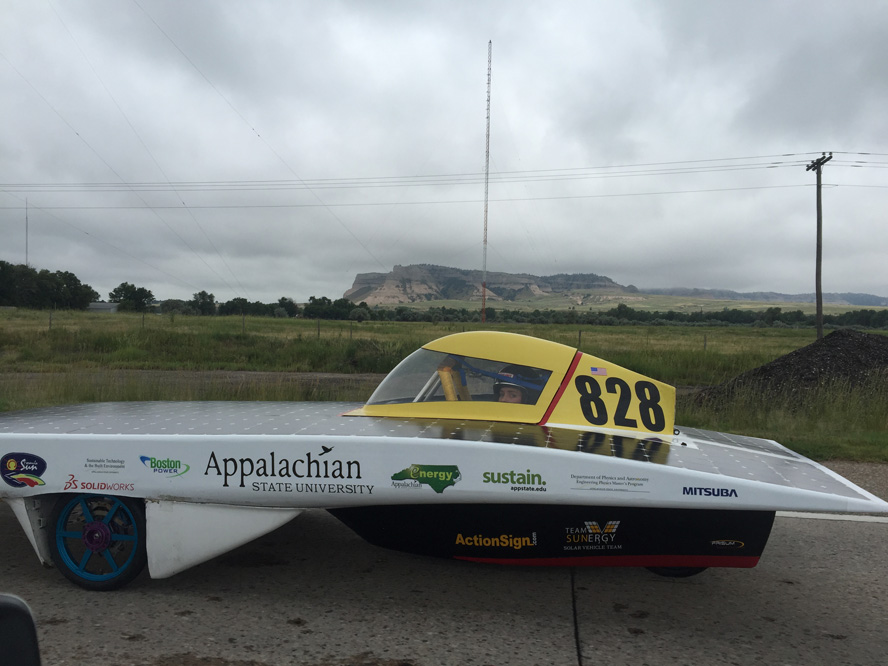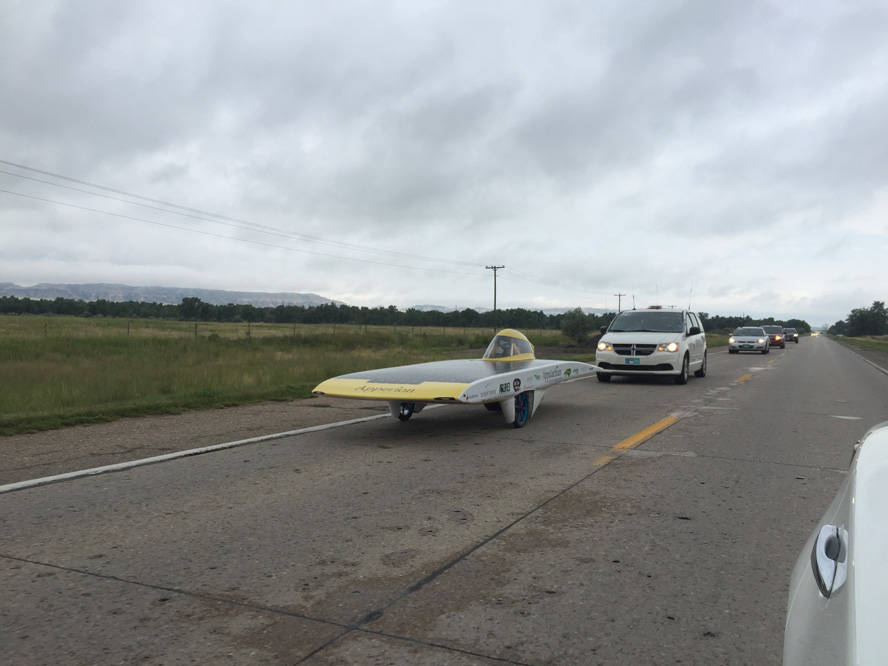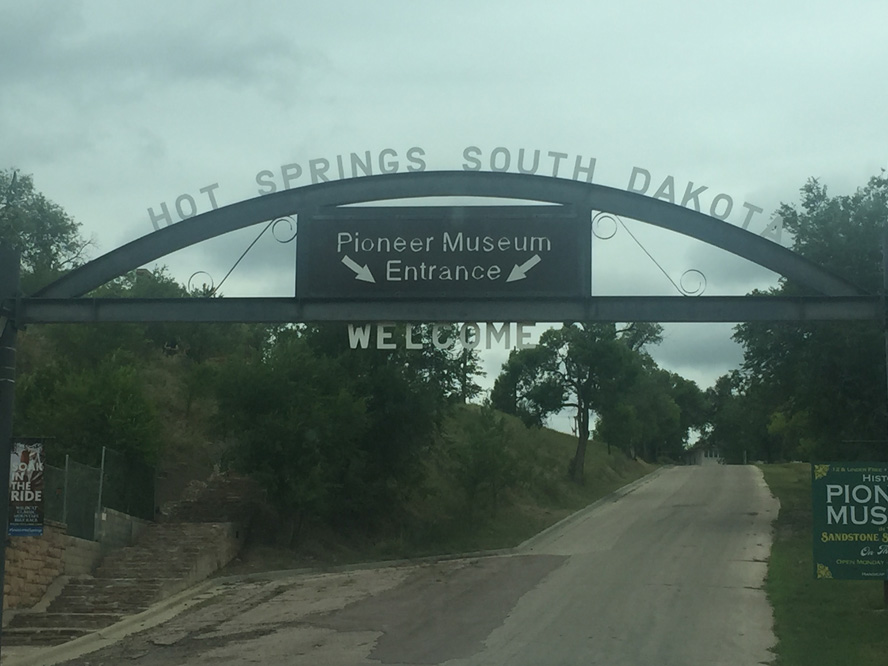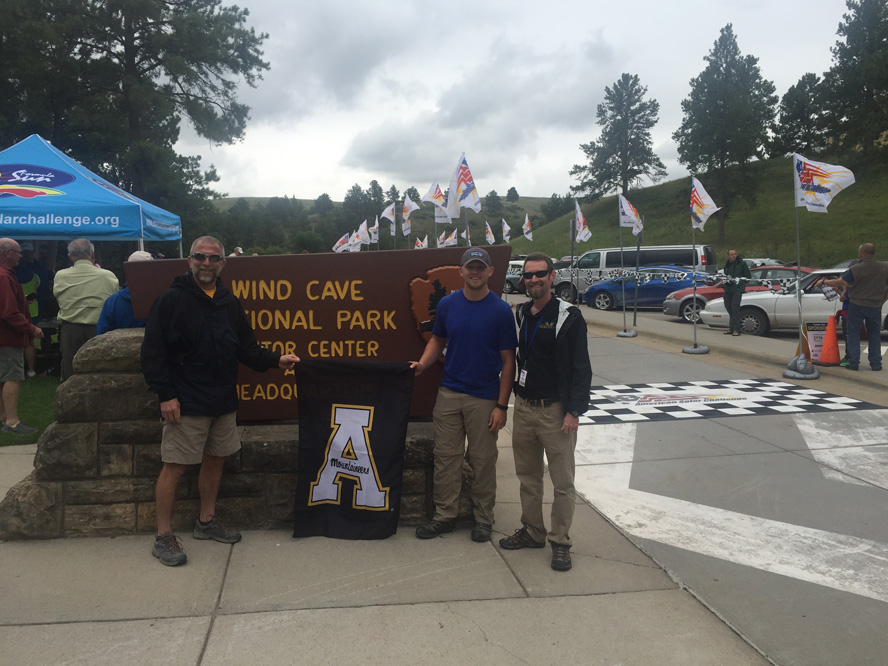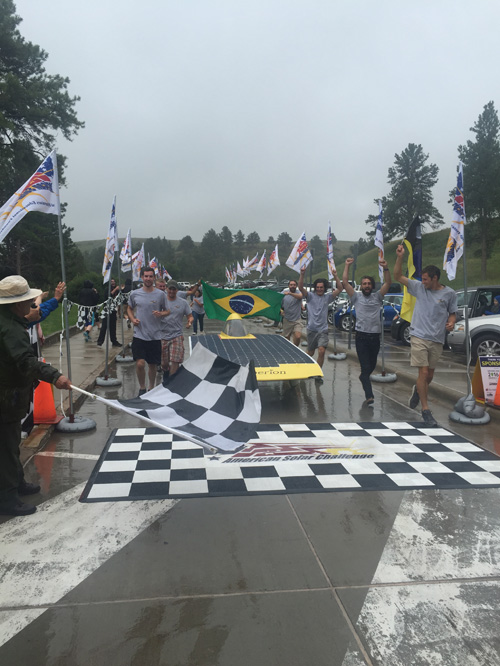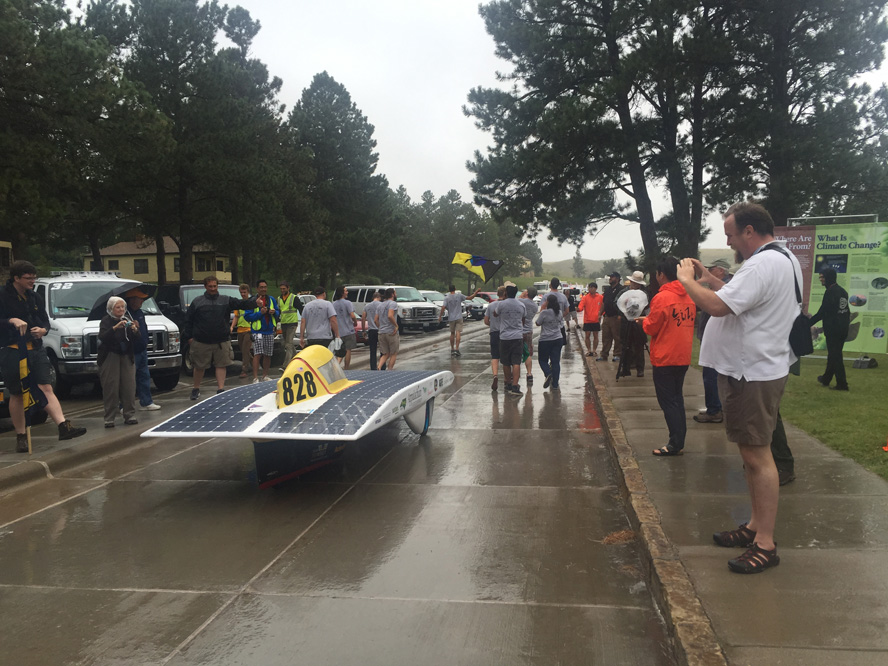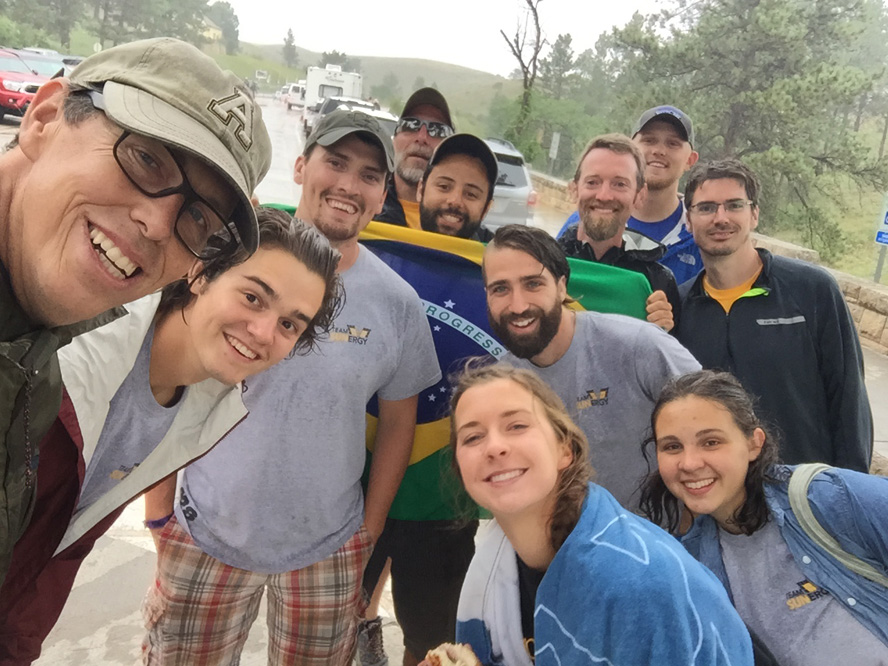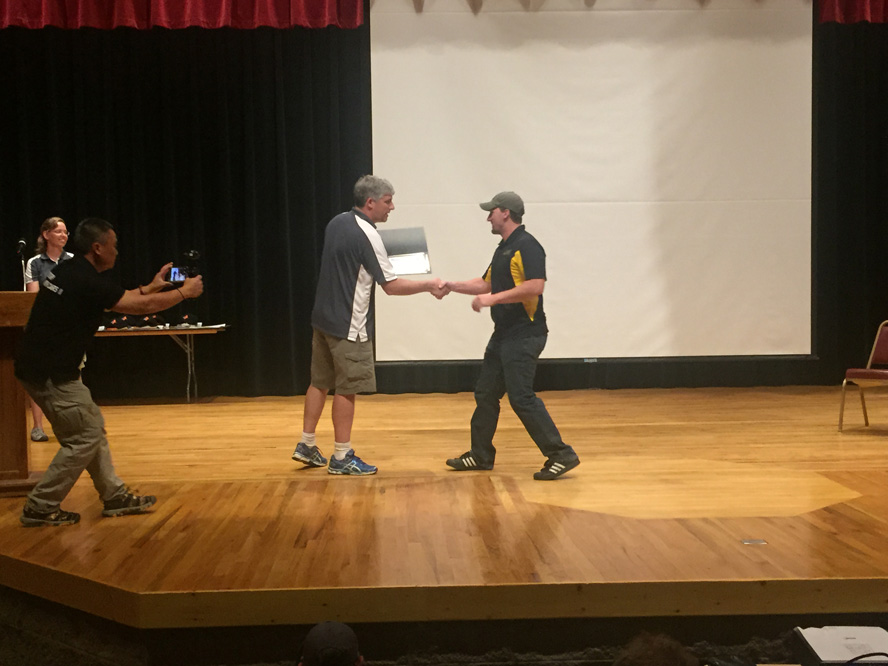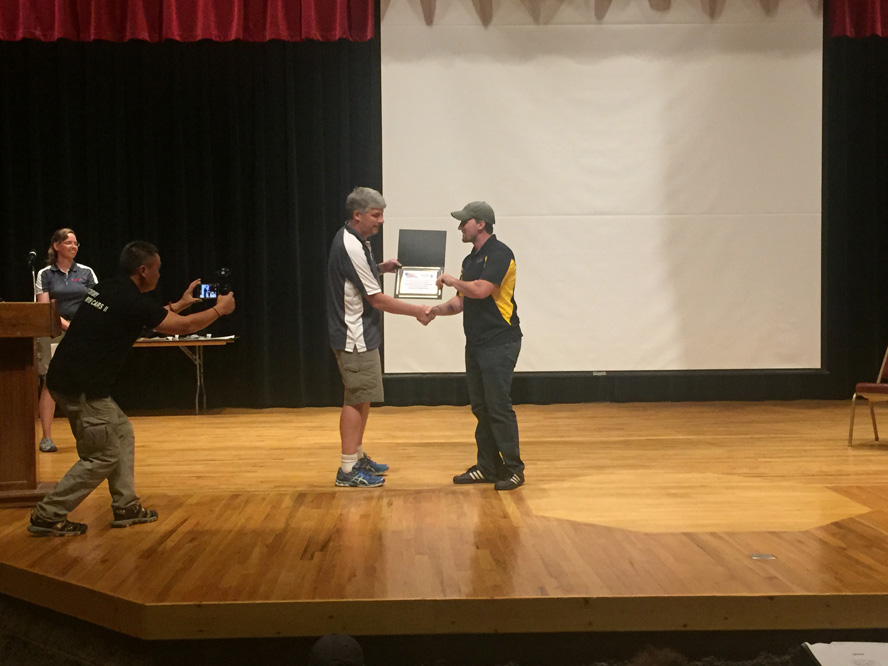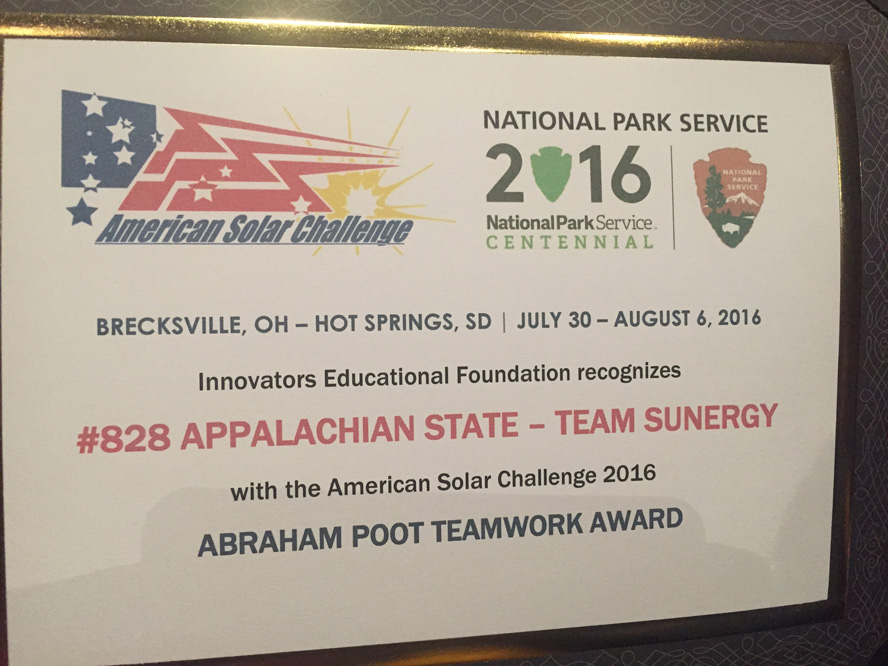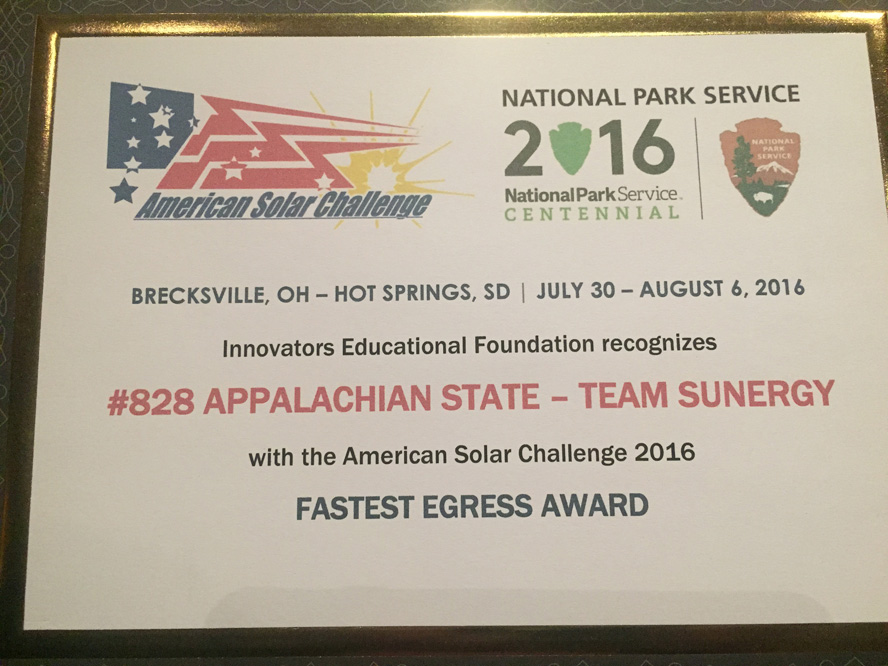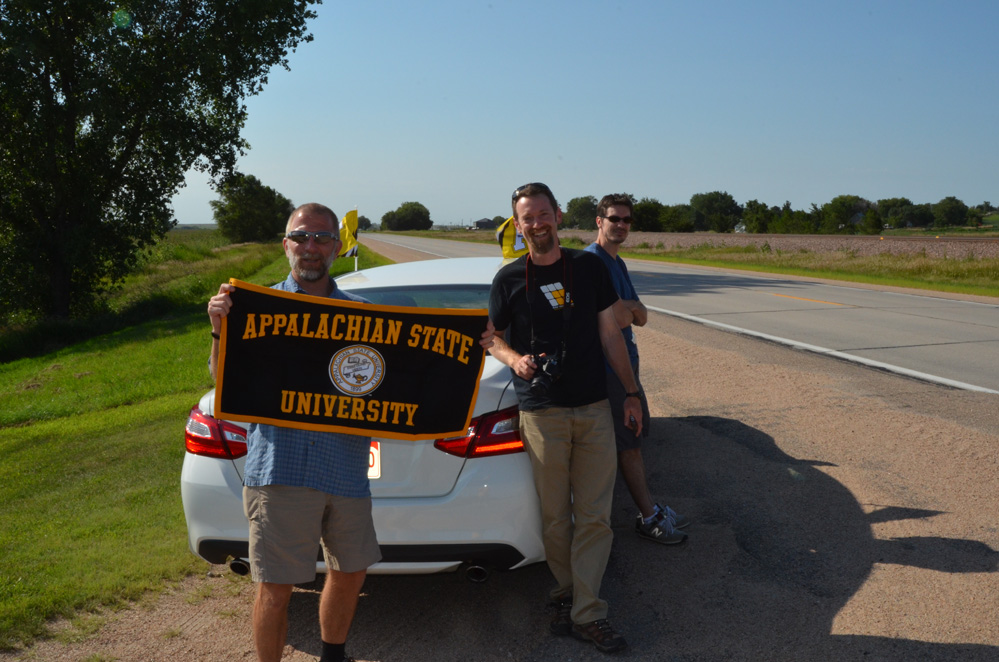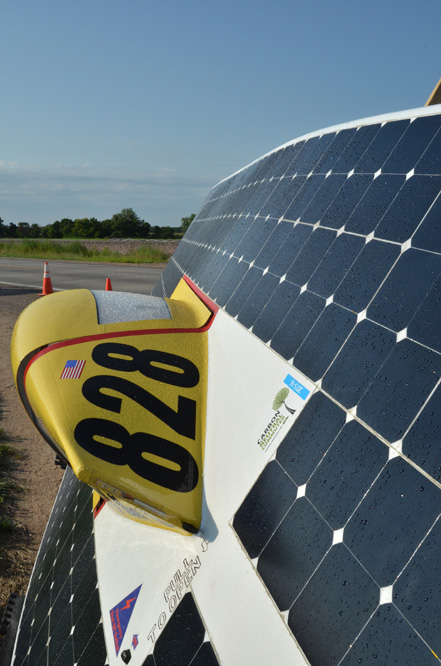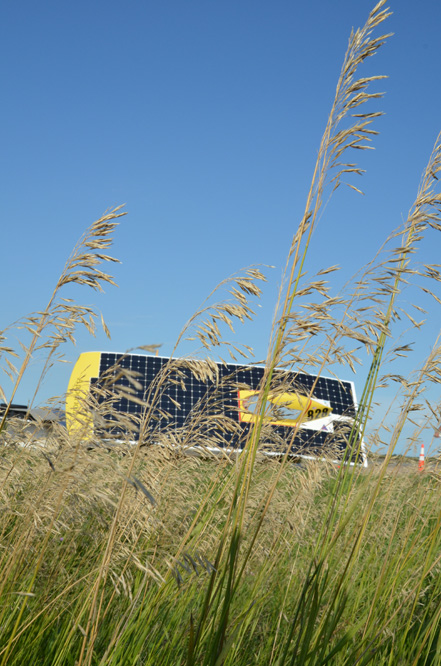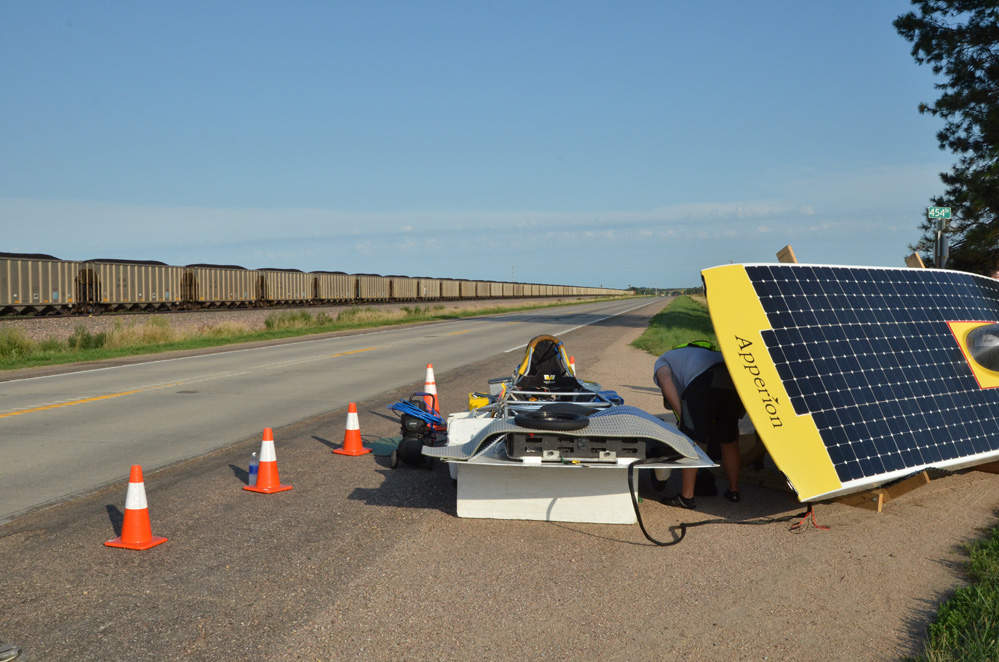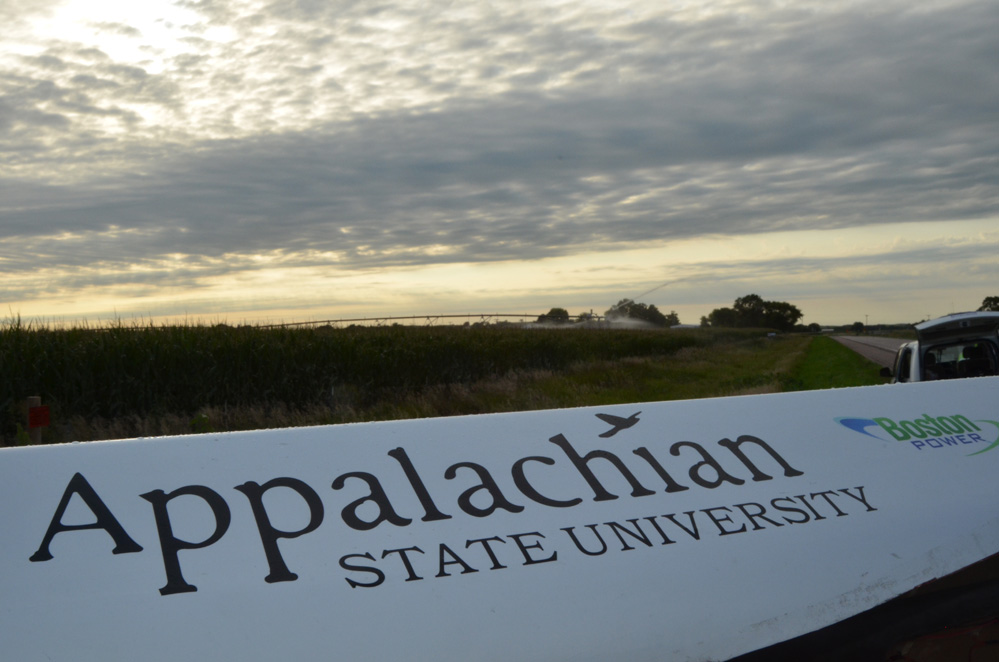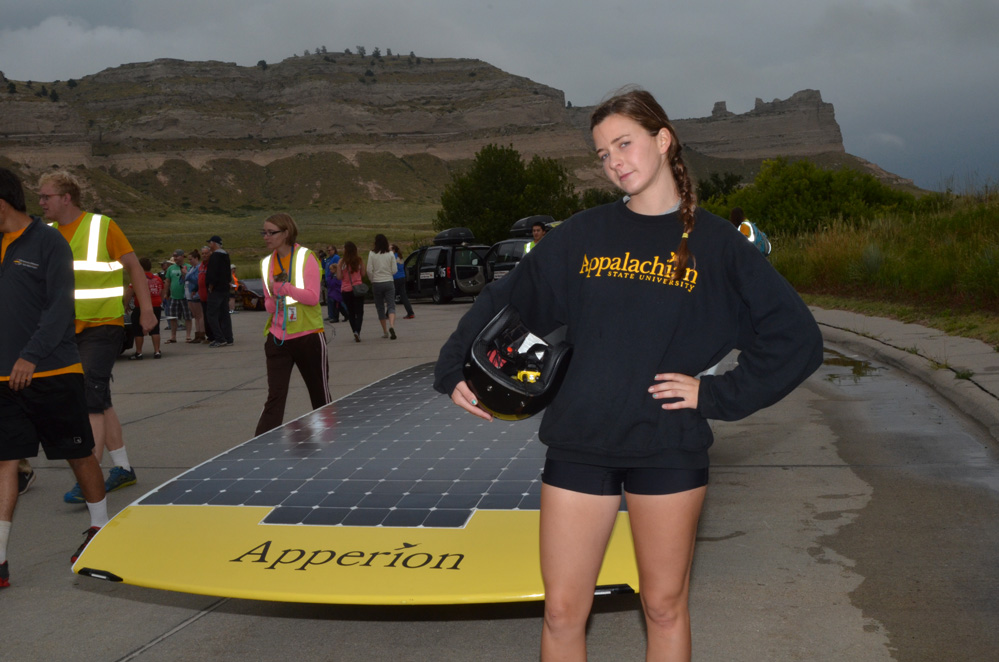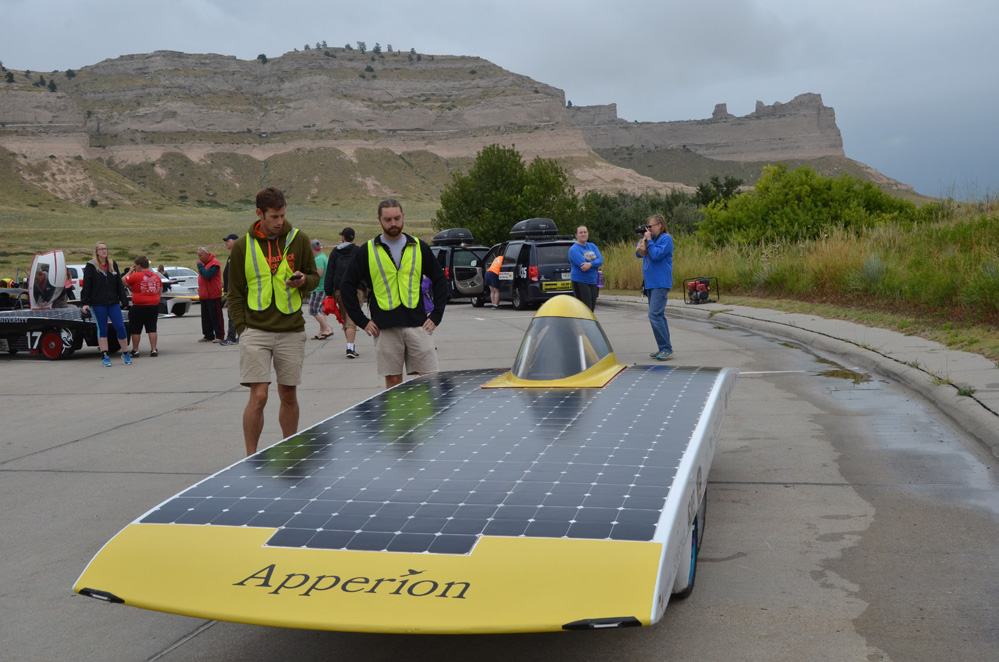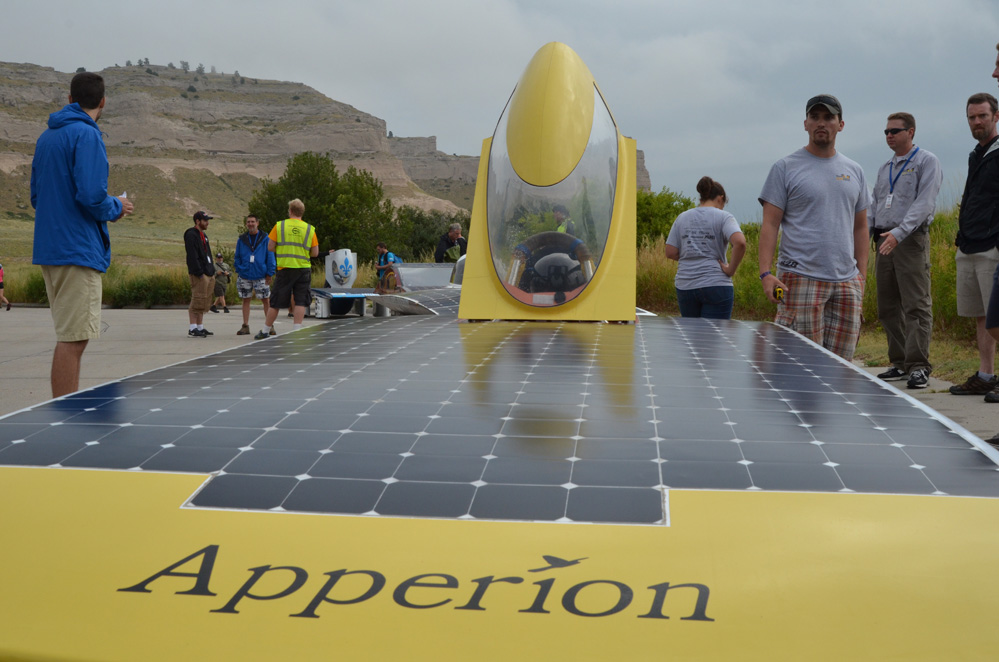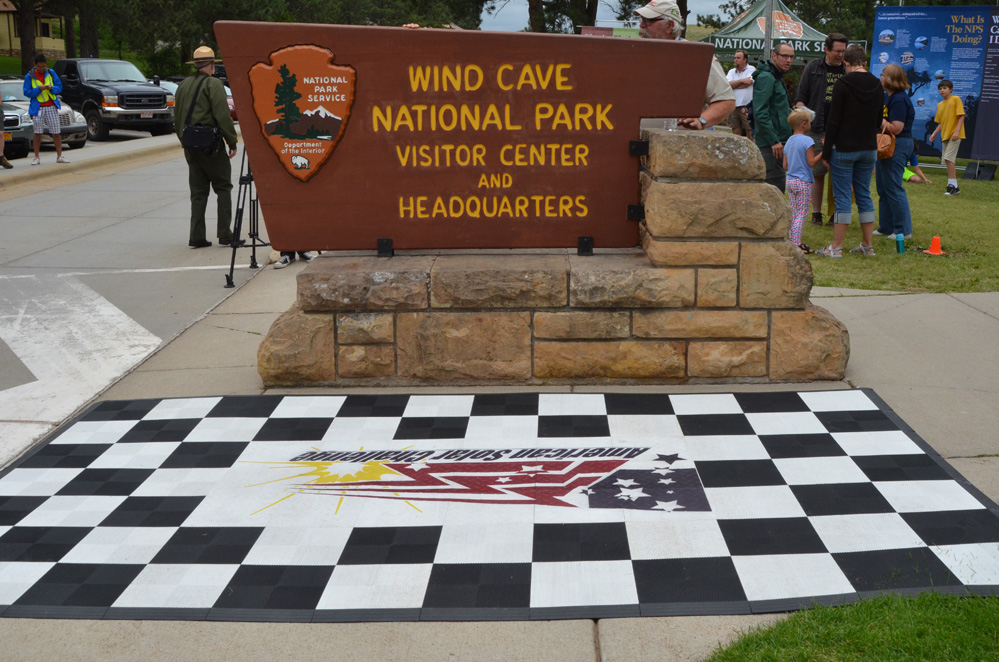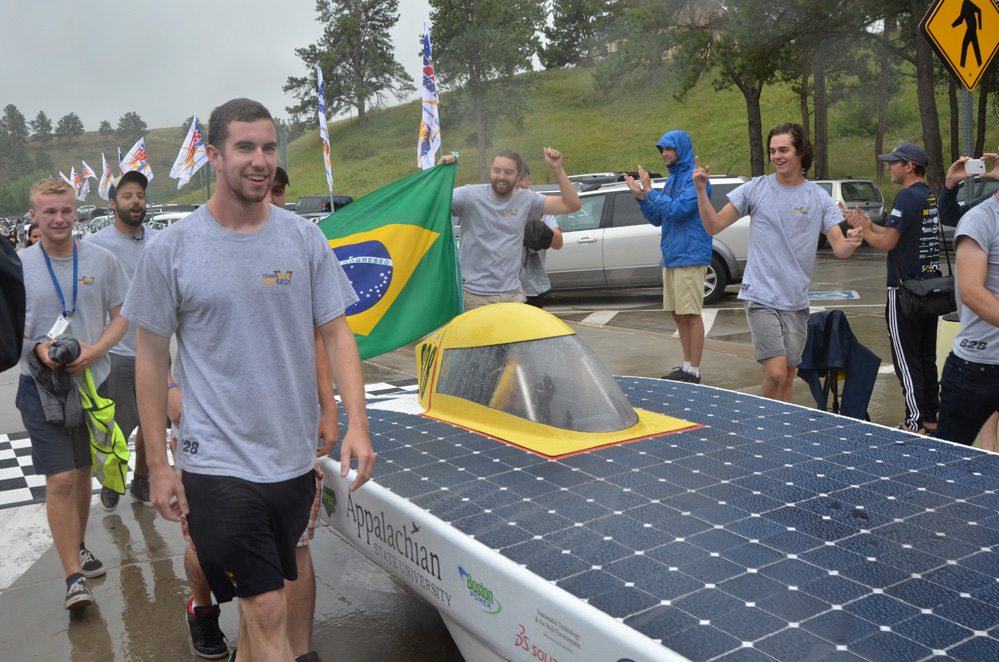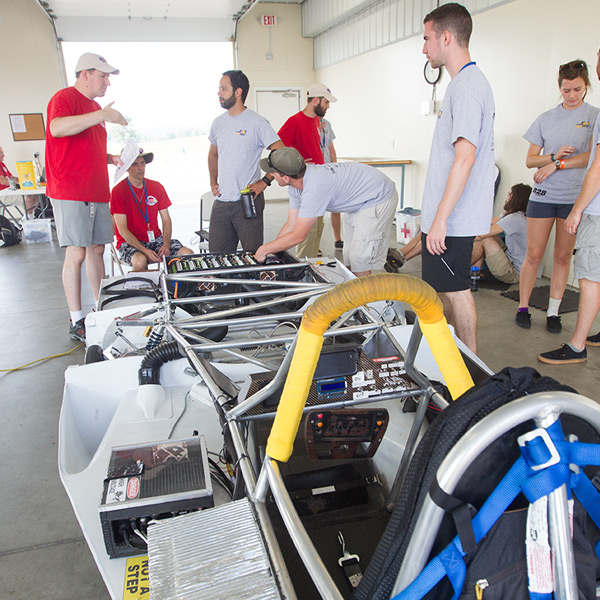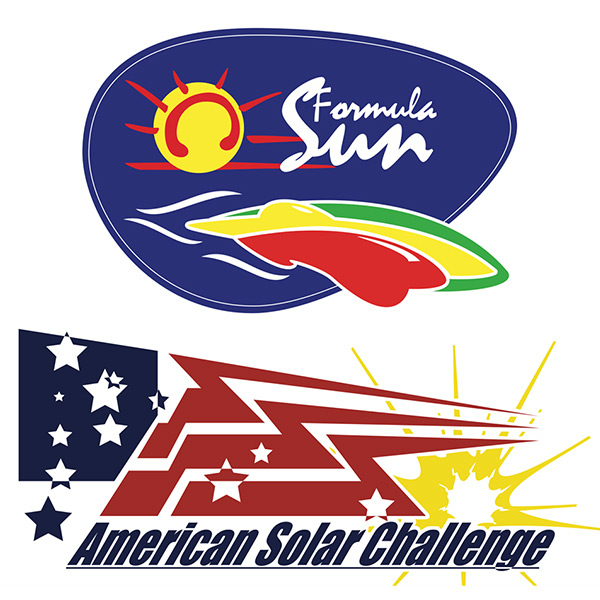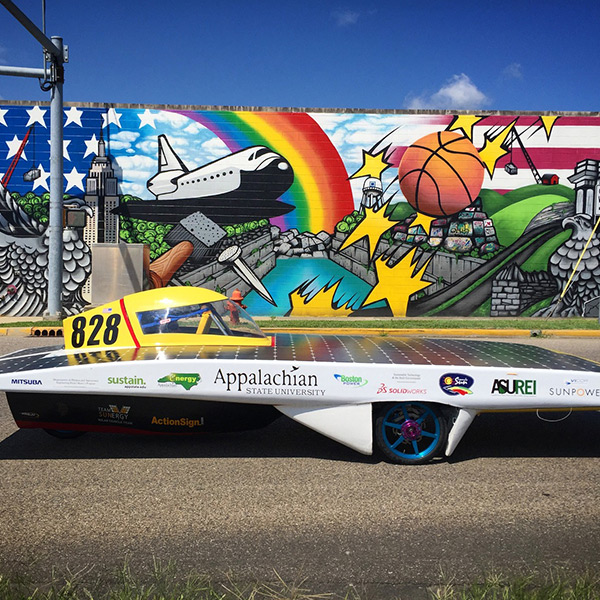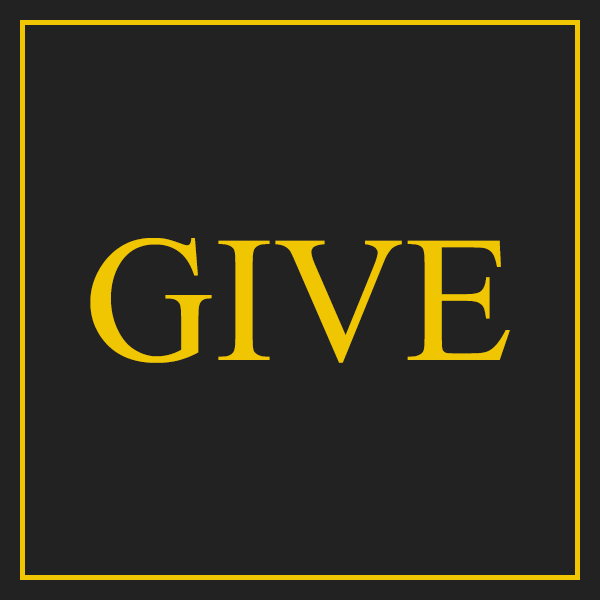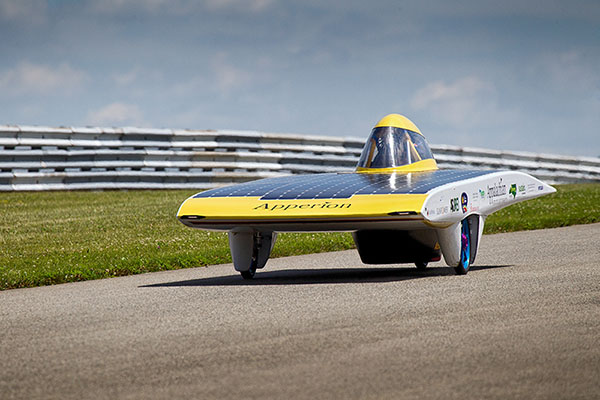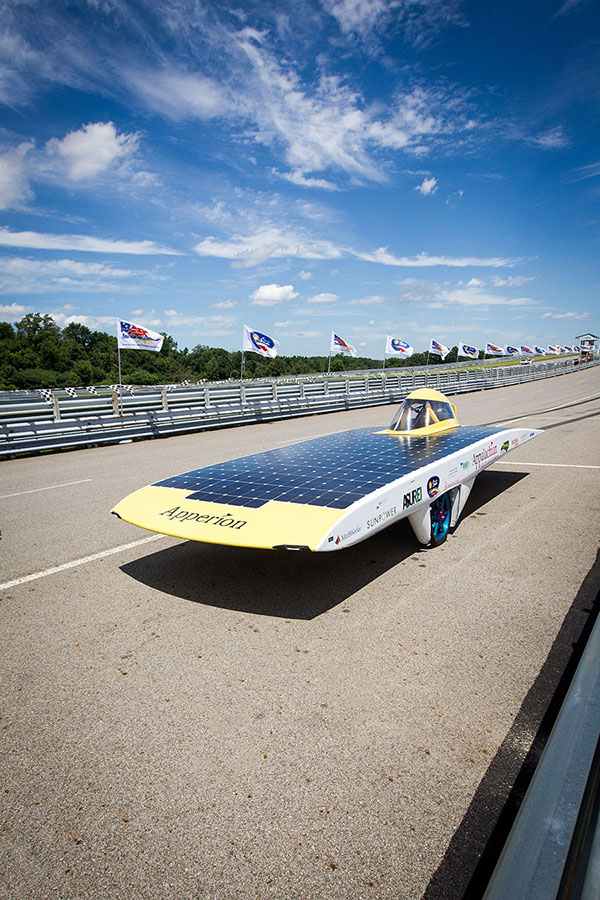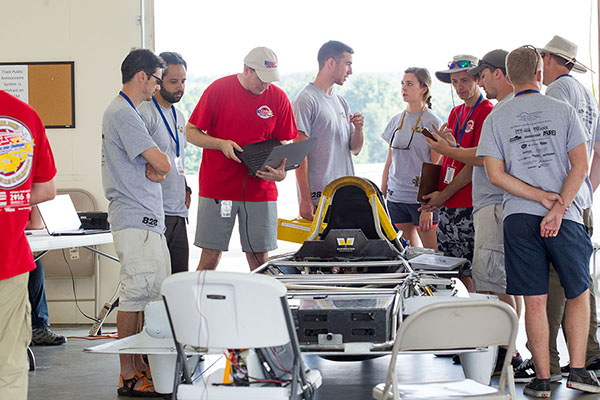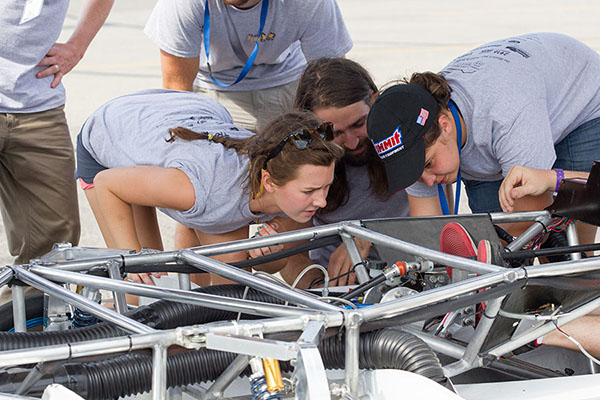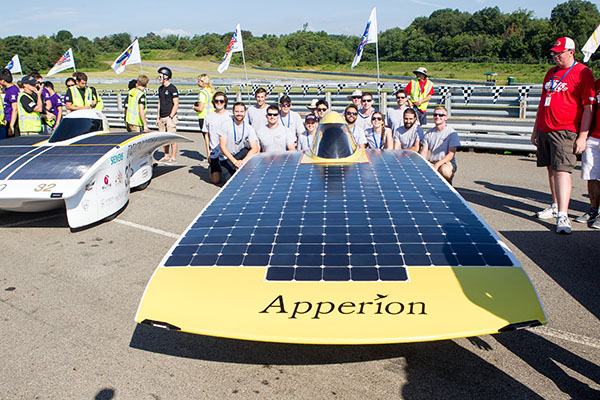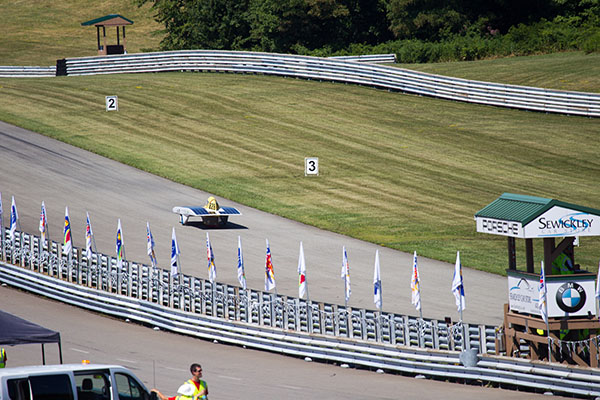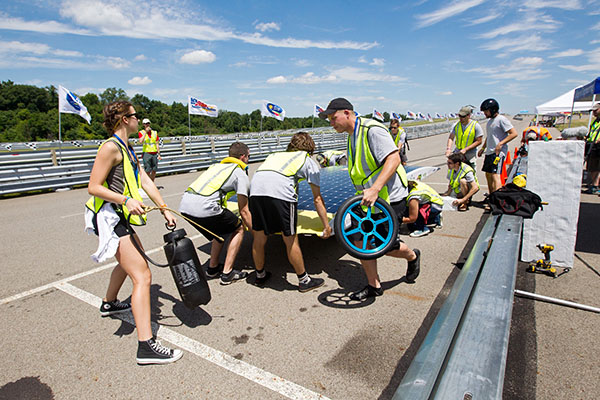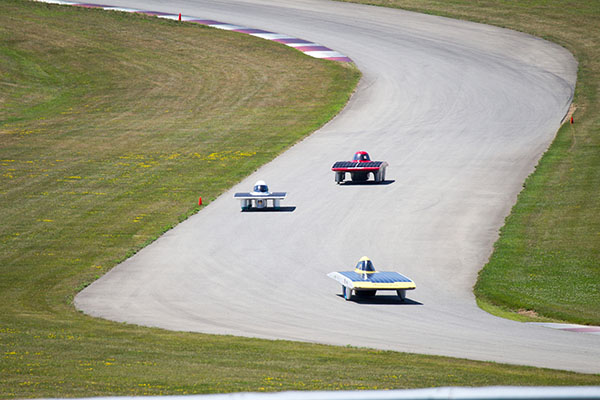What is this competition, anyway? An international event that involves designing, building and racing solar vehicles, the competition is two-fold. It is comprised of the Formula Sun Grand Prix (FSGP) and the American Solar Challenge (ASC). The FSGP is held on a closed course, and begins with a series of inspections and vehicle and driver qualifying assessments to verify that the car and its drivers are road-ready. Vehicles, like Appalachian State University’s Apperion, that pass inspection, or “scrutineering,” move on to the FSGP track race, where they compete for qualification in the ASC cross-country road race.
For a week before and during the 2016 American Solar Challenge at the Pittsburgh International Race Complex in Wampum, Pennsylvania, Appalachian’s solar vehicle underwent scrutineering – detailed inspections and performance trials. Apperion passed all scrutineering tests in time to begin the first day of track racing. Not all vehicles did. Some crashed during slalom testing and spent valuable time repairing; some had difficulty in the wet road brake testing; others had driver egress and communications tech challenges.
Scrutineering stage
The competition’s scrutineering phase includes solar array inspection, battery testing, structural and mechanical vehicle component and driving tests to verify vehicle stability and braking capability. Notably, it also includes verification of insurance, which Team Sunergy found to be one of its most challenging hurdles. Finding both an underwriter and the necessary funding to insure four student drivers to drive a vehicle with no headlights – and that weighs less than a quarter of the typical smart car – proved to take longer than wiring 210 batteries into 35 battery cells of six batteries each. But Chancellor Sheri N. Everts and an anonymous donor came through, and the car passed its final test.
Racetrack qualifier stage
Vehicles that passed all scrutineering inspections then advanced to the Formula Sun track racing qualifier stage. During this phase, each team was required to complete a minimum of 128 1.6-mile laps in one day or 192 laps in two consecutive days. Each driver who wanted to move on to the ASC had to complete a minimum of 33 laps. Those teams that passed scrutineering and met the track racing requirements qualified to race in the ASC.
For a week at the Pittsburgh International Race Complex in Wampum, Pennsylvania, drivers weaved between traffic cones in slalom handling tests, skidded to fast stops in wet road brake tests, and jumped from their vehicles in quick egress tests; crews demonstrated solar array charging capacity, battery load bearing and capacity, and dozens of details, including driver registration, insurance and support vehicle graphics, were scrutinized (or “scrutineered”).
Apperion passed all scrutineering tests in time to begin the first day of track racing. Not all vehicles did. Some crashed during slalom testing and spent valuable time repairing; some had difficulty in the wet road brake testing; others had driver egress and communications tech challenges.
And they’re off…
For a week before and during the 2016 American Solar Challenge at the Pittsburgh International Race Complex in Wampum, Pennsylvania, Appalachian’s solar vehicle drivers weaved between traffic cones in slalom handling tests, clocked times, kidded to fast stops in wet road brake tests, and jumped from their vehicles in quick egress tests; crews demonstrated solar array charging capacity, battery load bearing and capacity; and dozens of details, including driver registration, insurance and support vehicle graphics, were scrutinized or, using track vernacular, “scrutineered.” And, after hours, there was laundry to be done.
Day One
Team Sunergy was feeling cautiously optimistic. They went into the first day of track racing with a plan to qualify all four drivers with the minimum of 33 laps per driver and spend the next two days resting, testing and getting mentally and physically prepared for traversing nearly 2,000 highway miles in a tiny, hot cockpit.
Team leader Dan Blakeley kept the team tight – he was the first driver on the track and spend 44 laps meticulously testing strategies for battery use, regeneration, braking and communications with his crew. When he came off the track, he helped the team pit, gave some instructions to the next driver, Duvey Rudow, and then held a trackside meeting. He encouraged his team, noted where they needed to improve and then took the other two drivers aside and went through the track strategy in detail, having them repeat it back until they knew it cold. He kept the driving strategy consistent, suppressing everyone’s urge to max out their speed – and pass Michigan a few times on the track – so they would stay steady and not drain battery power.
At the end of the first day, Team Sunergy not only qualified, it was holding third place. The game had changed.
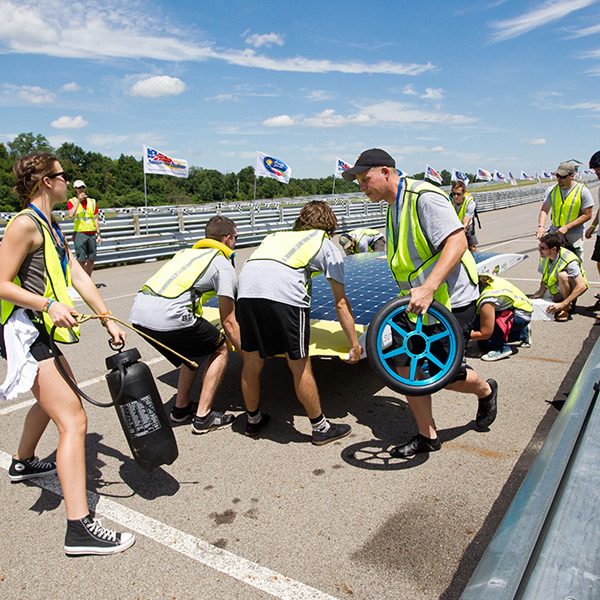
Days 2 and 3
Now a contender for a podium spot, Apperion was going to race the next two days. After holding steady in third place, Team Sunergy suffered a flat tire on Day Two. Briefly abandoning the “steady as you go” strategy, they tried to make up time, but slipped in their standings and began the final day of track racing in fourth place. Day Three was cloudy and rainy. Apperion started the day with a full battery and returned to a consistency-over-speed strategy. Before the end of the day, Michigan and Principia, having solidified their first and second-place standings, left the track, and the race for third was on between Appalachian and the University of Minnesota. Apperion took on water in the wheel wells and the team was getting concerned about compromising the batteries. Pit crew boss Jon Linck listened to his team’s concerns, then calmly strode over with a large drill, and bored two holes in the vehicle’s floor. The water drained out, and Apperion was back on the track.
Blakeley rounded out the race for Team Sunergy, completing Apperion’s three-day run with 414 laps to Minnesota’s 386. He pulled across the finish line, exited the vehicle and was greeted with a celebratory cooler of water over the head from his team.
“We were a little concerned we would not bring it back up to third,” Blakeley said in a post-soaking interview, “but ultimately being consistent brought us back up to third place so not only do we get to…bring our success back to Appalachian State but we also get to go into the American Solar Challenge with our heads held high.”
He took a short break to take in the moment, and then spoke for the team, each member of which was emotional from lack of sleep, tension and a feeling of “ wow – we just did this.”
“To come to an event like this after two years of countless hours of work and dedication,” Blakeley said, surrounded by his giddy team, “…you just can’t describe it.”
Thirteen vehicles qualified for the ASC. Team Sunergy was the first team from North Carolina ever to enter the international competition. They were the only North Carolina team in the competition and the only team in from the South to qualify for the ASC.
Team Sunergy leader Dan Blakeley rounds out the American Solar Challenge track race in third place, completing Apperion’s three-day run with 414 laps to Minnesota’s 386. Exiting the vehicle, he’s doused with a shower of cold water from his team.
The American Solar Challenge
Before their eyes had dried, the team was readying Apperion for its short, trailered journey to Brecksville, Ohio, where it would enjoy a day of rest and charge its batteries before the start flag waved on the eight-day journey across the Midwest. The 2016 ASC had four stages. The nine checkpoint and stage stop locations along the route were located in national parks. Each team had to check in on the designated day. If they ran out of battery power or had a mechanical failure that prevented them from completing the stage or making it to the designated checkpoint during daylight hours, they had to trailer their vehicle, drive it to the next stop, and take a time penalty. In addition to battery regeneration from collecting solar rays on the course, teams could charge their batteries for two hours at the beginning and end of each day. They began each day with the power they could recoup from the sun during the charging sessions.
Share the road with Team Sunergy, Appalachian State University’s solar vehicle team, as it traverses from Brecksville, Ohio, to Hot Springs, South Dakota – 1,975 miles of sun racing, wind-whistling, solar battery charging, slick-road stopping, seven-state crossing, auto-history making, nine national park honoring thrills, spills and sheer Mountaineer grit.
Each solar vehicle traveled between a scout vehicle and a chase vehicle, and 11 of the 12 Team Sunergy members made the trip, the only exception being Jongmin Na, who had returned to his native country of South Korea.
Road racing is more onerous than track racing. Highway conditions vary and include factors like train tracks and potholes which can wreak havoc on delicate wiring systems. Traffic, which makes overtaking and passing other race cars logistically difficult, stoplights and unexpeceted obstacles, like Amish buggies, add to the mix.
Driving Apperion on the road takes some getting used to, explained Blakeley. Drivers sit in the middle of the vehicle, so they have to reorient themselves to driving from the center rather than the left side.
On Day One of the ASC, University of Kentucky struggled with motor control and had to pull out. On Day Three, Iowa State University’s car slid into a ditch.
Team Sunergy completed Stage 1 in fourth place. By the end of Stage 2 they dropped to sixth. Stage 3 presented challenges to all teams. Heavy cloud cover and rain made on-route battery regeneration difficult. By the end of Stage 3, Team Sunergy made the difficult decision to pull over in a sunny spot and charge its batteries, and trailered into the checkpoint that evening. Beginning Stage 4 in ninth place, Apperion entered the stage with full battery capacity and was one of only three vehicles to complete the final day, replete with hills in addition to clouds and rain, on its own power. Apperion chased Michigan the last stage, and had the second-fastest time in the stage. “The last stage was the most challenging of them all,” the team posted on its blog. But by the end of Stage 4, Team Sunergy had gained three places to finish sixth overall.
At the end of a 17-day road trip, and a two-year journey, the team posted on their blog: “The American Solar Challenge has been completed but the challenge of advancing solar transportation has a long path ahead. We look forward to carrying the momentum of our success from this event and bringing more bright minds from Appalachian State onto our team to compete in future events around the globe.”
A competition that fosters collaboration – a bystander’s observations
What is it like to be in this environment? All Michigan digs aside, the competition is one that leaves observers and participants alike with the overall impression that everyone shares in a spirit of collaboration. The work of developing solar technology is important, and everyone wants it to succeed.
When vehicles made it through scrutineering and onto the track in Pittsburgh, everyone cheered. Teams shared parts, and helped one another problem-solve technical issues. Team Sunergy’s blog characterizes the atmosphere as “rampant with friendliness and inter-teamwork,” and describes a “solar-car racing community [that] has been very friendly and welcoming to our new team.”
A July 22 blog post relayed: “Principia College's solar team has lent Team Sunergy 3 rims for our car so we have an extra set for when we need to change tires. Without awesome teams like Principia and Iowa State (who donated our car frame) we would not have made it as far as we have. We reciprocate this generosity by sharing power with our neighbors.”
An Appalachian team seeks to change the future of transportation with a solar race car
About App State’s Team Sunergy
Appalachian State University’s internationally recognized Team Sunergy is an interdisciplinary, student-led team with a passion for sustainable transportation — and the ingenuity, innovation and drive to create it. The team began in fall 2013, as a class project to build a solar-powered golf cart, and has evolved into an award-winning program that has achieved podium finishes in every year of competition in both the Formula Sun Grand Prix and American Solar Challenge (ASC), including a first-place finish in the 2021 ASC. Both races set the standards for and test the limits of solar vehicle technology. Team Sunergy’s first vehicle, Apperion, was a modified single-occupant race car. In 2018, the team designed and built its current, two-passenger, Cruiser Class car, ROSE (Racing on Solar Energy), from the ground up. Learn more at https://sunergy.appstate.edu.
About Appalachian State University
As a premier public institution, Appalachian State University prepares students to lead purposeful lives. App State is one of 17 campuses in the University of North Carolina System, with a national reputation for innovative teaching and opening access to a high-quality, cost-effective education. The university enrolls more than 21,000 students, has a low student-to-faculty ratio and offers more than 150 undergraduate and 80 graduate majors at its Boone and Hickory campuses and through App State Online. Learn more at https://www.appstate.edu.
Acknowledgements
Web work by Pete Montaldi and Derek Wycoff. Video production by Garrett Ford. Photography by Marie Freeman, with additional images by Bailey Winecoff and Dr. Lee Ball. Audio production by Dave Blanks. Writing by Megan Hayes and Elisabeth Wall. Art by Jim Fleri. Editing by Linda Coutant. Logistics management by Stephanie Naoum. Technical support by Wes Craig. Creative direction and executive production by Troy Tuttle.
Special thanks to Dr. Lee Ball and Dr. Jeremy Ferrell for the context, history and on-site updates.
Shoutout to the Principia College and Iowa State University for the support, mentorship and parts you generously provided to Team Sunergy.
Very special thanks to Andrew Grimes, and every member of Team Sunergy. You are an inspiration.
What do you think?
Share your feedback on this story.
